The Kilroy Family
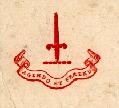 |
|
Agendo et Fereno
|
Abraham Kilroy
1817, in Turin, parish of
Ballymachugh, county Cavan, Ireland
Anthony
Kilroy
Elisa (_____)
Kilroy
1821:
Turin, Ballymachugh, county Cavan
- 1821 census lists
Abraham as aged 4, indicating birth in 1816 or 1817; IGI has year as
1817, and place as Turin
- 1821 census
Adeline Kilroy
1905/6, in Massachusetts, United
States
Richard
Thomas
Joseph Kilroy
Cora Evelyn (Terry) Kilroy
1920:
Abington
Town, Plymouth county, Massachusetts
Agnes Wilhelmina Kilroy
12 July 1893, in Middleborough,
Plymouth county, Massachusetts, United States
Richard Thomas
Joseph Kilroy
Bridget A. (Devine) Kilroy
1900:
Middleboro
Town, Plymouth county, Massachusetts
Alan James Minchin Kilroy
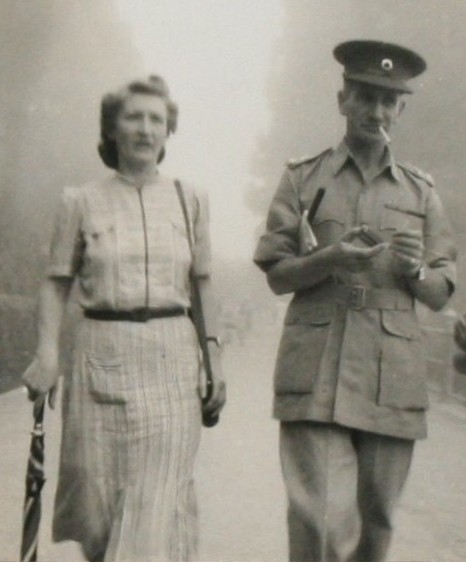 |
|
Alan James Minchin Kilroy (right) with his
sister Annie Kathleen (Kilroy) Gosnell
(Darjeeling 1942)
photograph from Jerry Gosnell
|
24 October 1897, at Moat View,
Oldcastle, county Meath, Ireland
Alan James Minchin Kilroy is recorded as born on Twenty Fourth October 1897
at Moat View, Oldcastle, the son of William W. Kilroy, grazier, of Moat
View, Oldcastle and Annie Maxwell Kilroy formerly Groome.
William
Wesley Kilroy
Annie
Catherine Maxwell (Groome) Kilroy
Army Officer in the Indian
Army, reaching the rank of Lieutenant-Colonel.
Alan was admitted to the Indian Army as Second Lieutenant on 7 February
1917, and attached to the 120th Rajputana Infantry (London Gazette 4 September 1917 p9156). He
was promoted to Lieutenant on 30 January 1918 (London Gazette 1 October 1918 p11567) and
made an acting captain in the 13th Rajputs from 19 May 1918 until 1 July
1918 (London Gazette 12 August 1919 p10228). Alan
was promoted to captain on 30 January 1921 (London Gazette 21 June 1921 p4917). On 11
December 1931 Alan, then of the 4/11 Sikh Regiment, was appointed S.S.O.,
1st Class (London Gazette 4 March 1932 p1502), and
promoted to Major on 30 January 1935 (London Gazette 8 March 1935 p1636). He was
transferred to the Special Unemployed list on 22 June 1936 (London Gazette 10 July 1936 p4422). Alan, a
major in the 11th Sikhs, was awarded the Order of the British Empire (OBE)
on 1 January 1943 (London Gazette 29 December 1942 p10) and
promoted to Lieutenant-Colonel on 12 April 1946 (London Gazette 28 June 1946 p3300).
26 December 1974, in county Meath,
Ireland, aged 78
Killeagh cemetery, Oldcastle, county
Meath, Ireland
In loving memory of Lt. Colonel Alan James
Minchin Kilroy OBE of Castlecor (Late 36th Sikh Regt. I.A.) died 26th Dec.
1974 in his 78th Year
1901:
Moat, Oldcastle, county Meath
1911:
Mountjoy School, Mountjoy Square, St Peters, Dublin, county Dublin
Albert Gibson Kilroy
13 February 1886, at Derrysheridan,
Killeagh parish, county Meath, Ireland
Albert Gibson was born on Thirteenth February 1886 at Derrysheridan, the
daughter of James Kilroy, farmer, of Derrysheridan, and Maria Kilroy
formerly Gibson.
James Watkin
Kilroy
Maria (Gibson) Kilroy
Ruth Hall on 11 October 1911, in
Ladysmith, Natal, South Africa
Albert Gibson Kilroy is recorded as a bachelor, of full age. He is a farmer,
resident in Ladysmith. Ruth Hall is recorded as a spinster, of full age,
resident in Ladysmith. The marriage was witnessed by E. B. Woolman and G. K.
Eaton.
- Albert Gibson Kilroy (1911/2 - ? )
- Frederick George Kilroy (1912/3 - ? )
Farmer (1911); Station Foreman
(1920)
25 December 1920, in the convent
sanatorium, Ladysmith, Natal, South Africa, aged 34 years and 10 months. The
cause of death is listed as an accident, of duration 8 hours, and Albert's
residence is listed Colenso, Natal. An enquiry into the death was held at
Estcourt.
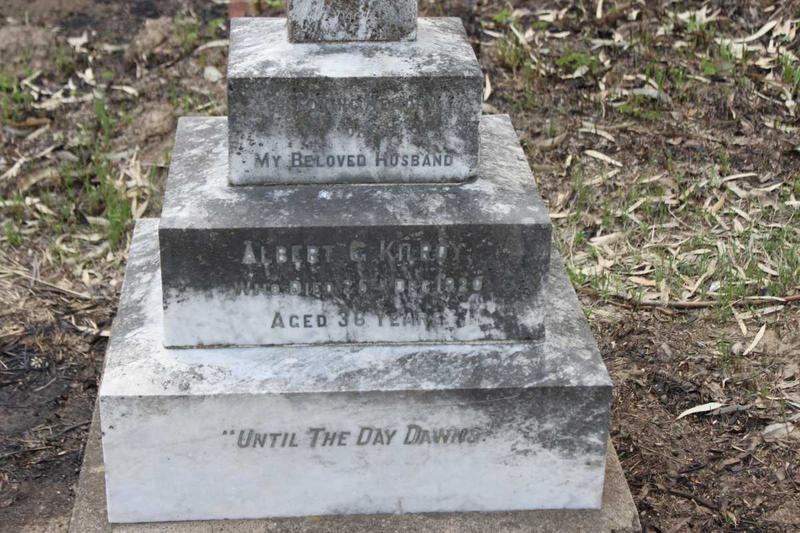 |
|
Headstone of Albert Gibson Kilroy in
Ladysmith Main cemetery, Natal, South Africa
photograph by Chris and Petra Lombard
posted at eGGSA |
Ladysmith Main cemetery, Natal,
South Africa
The headstone reads:
In Loving Memory of | My Beloved Husband | Albert
G. Kilroy | who died 25th Dec 1920 | Aged 36 years | "Until The Day Dawns"
No.
21/1921 dated 16 March 1914, filed 12 January 1921
This is the Last Will and Testament of me
Albert Gibson Kilroy of Lower Lyell St Ladysmith in the County of Klip
River Natal made this 16th day of March in the year of our Lord one
thousand nine hundred and fourteen.
I hereby revoke all wills made by me at any time heretofore. I
appoint my wife Ruth Kilroy to be my Executor and direct that all my debts
and funeral expenses shall be paid as soon as conveniently may be after my
decease.
I give and bequeath unto my son Albert Gibson Kilroy the sum off
£50. 0. 0. sterling (fifty pounds sterling) and the remainder of my
property to my wife the said Ruth Kilroy.
Signed by the said Testator A.G.Kilroy in the presence of us present at
the same time who at h request in h presence and in the
presence of each other have subscribed our names as witnesses.
W.Rooney J.Horne
1911: Ladysmith, Natal (marriage record)
1914: Lower Lyell St, Ladysmith, Natal (will)
1921: Colenson, Natal (death notice)
Albert Brian Kilroy
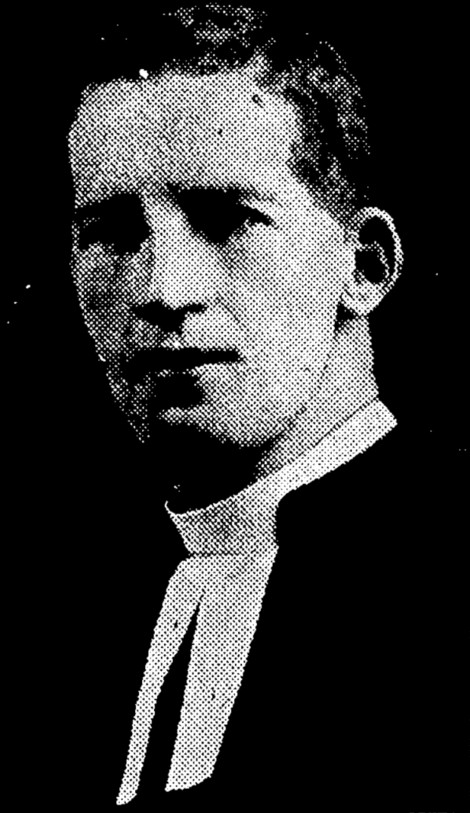 |
|
Albert Brian Kilroy
|
25 April 1895, in Eglinton, Dunedin,
New Zealand
Evening Star 27 April 1895 p2
KILROY.—On
the 25th April, at Eglinton, Mrs Kilroy, of a son.
Mark Moore
Kilroy
Mary Ellen (Moore) Kilroy
M.A. from the University of Otago
Albert graduated with a B.A. from the University of Otago in May 1918 (Otago Daily Times 25 May 1918 p11) and M.A.
(with second class honours in history) in August 1919 (Otago Witness 29 August 1919 p8).
Interestingly, also graduating in the same class, both at B.A. and at M.A.,
with the same degree, even the same grade and honours major, was Catherine
Thomson Macindoe, whom he would marry eleven years later.
Albert continued theological studies at Theological Hall, Knox
College, Dunedin, and at Westminster
College, Cambridge from 1920-22. Westminster was a theological college
of the Presbyterian Church of England, not associated with Cambridge
University. Brian and his mother sailed
on the Arawa
for Southampton and London on 31 July 1920. After completing his
studies, he was licensed by the Presbytery of London North in 1922, and
returned to New Zealand aboard
the Athenic from
Southampton, arriving in Wellington on 10 August 1922, opnward bound for
Port Chalmers (near Dunedin).
Catherine Thomson Macindoe on 27
August 1930, in Invercargill, Southland, New Zealand
Otago Daily Times 29 August 1930 p6
The
marriage took place at Invercargill of Miss K. M’Indoe, daughter of the
late Mr M’Indoe, chemist, and the Rev. A. Brian Kilroy, of Oamaru. The
Rev J. Lawson Robinson (St. Andrew's, Christchurch), assisted by the
Rev. R. M. Ryburn (Youth Director), officiated.
Catherine was born on 3 July 1893, in West
Ham district, Essex, England, the daughter of George Dobbie Macindoe
and Jane Hyndman. The family, including Catherine, aged 2, emigrated to New
Zealand aboard
the Rimutaka, arriving in
Wellington on 25 February 1896. She studied at the University of Otago where
she graduated with a B.A. in May 1918 (Otago Daily Times 25 May 1918 p11) and M.A.
(with second class honours in history) in August 1919 (Otago Witness 29 August 1919 p8).
Interestingly, also graduating in the same class, both at B.A. and at M.A.,
with the same degree, even the same grade and honours major, was her future
husband, Albert Brian Kilroy. Catherine died on 15 August 1970, aged 77, and
was cremated on 18 August 1970, at Wellington crematorium.
Addresses:
1936: 19 Bolton Street, Wellington (Evening Post 8 July 1936 p11)
1965: 236 Tinakori Road, Wellington (manifest
of the Canberra 19 October 1965)
Clergyman
Albert was ordained into the Riccarton Church, near Christchurch, on 12
December 1922, St Paul's Church in Oamaru on 21 August 1928 and lastly St
Andrew's Wellington on 18 October 1934, where he served until his death in
1947.
Register
of New Zealand Presbyterian Church Ministers, Deaconesses &
Missionaries from 1840 p174
KILROY, Rev
Albert Brian M.A.
b 25.4.1895 Dunedin
w Catherine Thomson b 3.7.1893 m 27.8.1930 d 15.8.1970
Home Missionary Alexandra Outfields - student 1915
Okato TkP - student 1916
Theological Hall 1919-20; Westminster College Cambridge 1920-22
Ordained Riccarton Chch CP 12.12.1922
St Pauls Oamaru NOP 21.8.1928
St Andrews Wellington WP 18.10.1934
He had a great deal to do with Broadcasting from its early yrs till his
death. He was involved in the administration of religious broadcasting,
and was Convener of Committee 1939; he was a noted broadcaster to children
and adults (on radio). He was almost blind all his life; his Mother read
his books to him for study in NZ; he could only read with powerful
glasses, the book being held a few inches from his eyes. He had great
courage in the face of infirmity, and especially after a serious illness
in 1940.
After his death he left a widow, but no children.
Died 21.1.1947 in office - He collapsed as he attempted to step on to a
tram in Lambton Quay, Wellington.
Evening Post 30 July 1928 p11
The
Rev. Brian Kilroy, who has accepted a call to St. Paul's, Oamaru,
concluded his ministry at St. Ninian's Church, Riccarton, Christchurch,
yesterday. Mr. Kilroy, who graduated in arts from Otago University, had
part of his theological education at Knox College, Dunedin, but most of
it at Westminster College, Cambridge. After being licensed in 1922 by
the Presbytery of London North, he returned to Dunedin, where he acted
as locum tenens in First Church until he was called to Riccarton.
Press 11 August 1928 p5
ST.
NINIAN'S, RICCARTON.
FAREWELL TO REV. BRIAN KILROY.
The tenth annual meeting of the congregration of St. Ninian's
Presbyterian Church was held on Thursday evening last, when the
opportunity was taken to say farewell to the Rev. Brian Kihoy, who is
leaving shortly to take charge of St. Paul's, Oamaru, after completing a
ministry of nearly six years at St. Ninian's.
The Rev. J. D. Webster, Interim Moderator, presided.
The session report presented by Mr R. Hepburn, session clerk,
stated that it is with feelings of the very deepest regret that the
session and congregation received the intimation of Mr Kilroy's decision
to accept the call to St. Pauls, Oamaru; but their sorrow was tempered
with joy knowing that he has been called to a much larger and more
important charge, where his exceptional gifts will enable him to render
greater service. During his ministry of nearly six years he had proved
himself a minister of unusual talents as a preacher, a leader, an
organiser, and a pastor. His personality and untiring devotion had
endeared him to all, and especially to the young men of the church, who
regarded him not only as their minister, but as a very sincere friend. A
tribute was also paid to Mrs Kilroy, his mother, for her interest and
work in the cause of the Church. The session wished them health,
prosperity, and happiness in their new sphere.
Evening Post 18 October 1934 p5
NEW
MINISTER
ST. ANDREW'S CHURCH
REV. BRIAN KILROY
The Rev. Brian Kilroy, M.A., who recently accepted a call to St.
Andrew's Presbyterian Church, The Terrace, arrived from the south
yesterday. He will be inducted to his new charge this evening, at 7.30
o'clock.
... FAREWELL AT OAMARU.
On Monday evening, St. Paul's Hall, Oamaru, was filled to
capacity for the congregational farewell social tendered to the Rev.
Brian and Mrs. Kilroy and Mrs. Kilroy, sen., by St. Paul's Church, and
the presence of such, a large gathering was a fine tribute to the great
work done by the guests while residing, in Oamaru, states the "Otago
Daily Times." The Rev. W. W. French occupied the chair.
The Mayor (Mr. M. F. E. Cooney), although expressing regret at
bidding farewell to Mr. Kilroy, stated that he was glad of the
opportunity to acknowledge publicly on behalf of the citizens the worth
of the three guests as members of the Oamaru community. Mr. Kilroy had
associated himself with all worthy organisations in the town. He was a
wonderfully gifted speaker, and Mr. Cooney referred to his work among
the young people, both of the church and the community generally. There
were few better tasks that a man could take up than helping the youth,
and the community owed a great debt to Mr. Kilroy for his services. The
Mayor said he was confident that Mr. Kilroy's oratory would make a great
impression in Wellington, as his speaking came direct from the heart. On
behalf of the citizens he congratulated Mr. Kilroy on his call, and
wished the three guests success in the Capital City.
Numerous addresses appreciative of Mr. Kilroy's work in Oamaru
and of his influence on the youth of the community were delivered, and
presentations were made to Mrs. Kilroy and to Mrs. Kilroy, sen.
The Rev. Mr. Kilroy, who was born in Dunedin, was educated at the
Otago Boys' High School and Otago University, and graduated M.A. in
1919. He spent two years at Theological Hall, Dunedin. He was two years
at Westminster College, Cambridge, and was licensed by the Presbytery of
London North in 1922. On his return to New Zealand, he was ordained and
inducted to the charge of Riccarton Presbyterian Church. Mr. Kilroy was
six years minister at St. Paul's Church, Oamaru.
21 January 1947 at Lambton Quay,
Wellington, New Zealand, aged 51. Albert collapsed as he attempted to step
on to a tram in Lambton Quay.
23 January 1947 at Wellington
crematorium, Wellington, New Zealand
Alexander Kilroy
of Omard, county Cavan
1806
Richard Kilroy
Elizabeth (_____) Kilroy
Maria Lucinda Fry on 17 January
1833, in St Luke, Old Charlton, Kent, England.
Maria was born in 1807/8, in Guernsey, Channel Islands (1871, 1881 census)
or Scotland (1891 census). Her father, Captain Fry, served in the Royal
Navy. She died in 1892, in Fulham
district, London, aged 84.
Census:
1841: Charlotte
Terrace, Stoke Damerel, Devon
1851: Alfred
Place, St Andrew, Devon
1871: Kensington,
London, Middlesex
1881: 122 Edith
Road, London, Middlesex
1891: North End
Road, Fulham, London
Staff Surgeon in the Royal Navy.
Member Royal College Surgeons England, 1827. Alexander joined the British
Navy on 7 February 1828. On 20 May 1835 he was posted to the Edinburgh
serving in the Mediterranean, as assistant surgeon (Navy List 1836). Alexander was
promoted to surgeon on 15 April 1838. The Navy
Lists for 1840,
1841
and 1842
show him serving as surgeon on the Favourite
in the East Indies. Alexander then became part of the Transport Service of
the Navy, serving as surgeon superintendent on at least four convict ships,
the China in 1845 (United Service Magazine vol 47 p634), the Mayda in
1846, the female convict ship Australasia
in 1849, and the Mermaid in
1850-51. The Australasia sailed
from Dublin on 26 June 1849, at the height of the Great Famine, taking 95
days to arrive at Hobart, Tasmania on 29 September 1849. The following
general remarks in his surgeon's journal have been transcribed
at
the Family Tree of Trudy Mae Cowley
When the convicts were embarked at Kingstown they
seemed to be in excellent health, although in reality they were not so for
most of them had suffered from insufficient and bad food before their
convictions and in Grange Gorman Depot had been fed a good deal on Bread
and Milk which gave them a healthy appearance, but very soon after the
change from that diet to the salt provisions of the ship they suffered
considerably in health, labouring under obstipation with ma? and gastric
?ation This change was felt the more suddenly from want of the usual
supply of potatoes which are generally given to fresh convict ships and
which could not be procured at the time the Australasia sailed from
Kingstown.
The cases at first were not very severe in the Fever cases which occurred
during the warm weather principally within the tropics. The head was
generally very much affected but in only two of them required b?section.
These two cases 3 and 4 of this Journal, their convalescence was very slow
and frequently interrupted and complicated by local congestions, dysentry
and dysuria. The other cases of fever were generally relived by purging
with a cold application to the head and in some of them b?tis which in
hard cases had to be repeated.
The convicts remained in pretty good health until we got into cold and
damp weather after passing the Cape of Good Hope. When dysentery became
prevalent amongst them the cases were not very severe at first although
some of them proved tedious but after a time the cases became more or less
complicated with Scarbulic (?) Symptoms and then became very troublesome
and difficult to manage ...
Those sent sick on board the Anson
were generally slight cases but still requiring medical treatment and
there was not room for them in the Hospital.
... whenever they went on deck their feet soon became damp and cold in
consequence of the thinness of their shoes which are very little use as a
means of keeping the feet dry and warm and I think it would be a great
improvement in female convict ships to send thicker and stronger shoes and
in that case one pair per convict should be sufficient for the voyage.
The Mermaid sailed from Woolwich on
20 December 1850 bound for Fremantle, Western Australia, with 208 convicts
aboard. It arrived on 13 May 1851. On 10 March 1854, Alexander joined, as
surgeon, the Ajax, a screw steam
guard ship based in the Baltic in
the
1855 list and in Devonport, Devon in
the
1857 list. On 1 February 1858, he joined the Exmouth,
also a screw steam guard ship based in Devonport (Navy List 1858). Alexander retired
on
13 May 1859.
The Free
Settler or Felon? website contains this biography of Alexander:
KILROY,
Alexander R.N., (* 15 April 1838)
In 1833, Alexander Kilroy, assistant-surgeon of the Victory
was appointed to be assistant-surgeon of the Island
of Ascension (Hampshire
Telegraph 25 February 1833)
He was appointed to the Favourite in
1841. (The Navy List)
In 1845 he was appointed Surgeon Superintendent of the convict ship China (The
Standard 24 February 1845)
He was appointed to the Mayda
in July 1845. The Mayda
arrived in Norfolk Island with convicts 8th January 1846. He was
appointed to the Australasia
Convict ship in 1849 (to VDL)
He was employed as surgeon superintendent on the Mermaid
to Fremantle in 1851. The Mermaid,
J.P. Anderson, master, arrived at the moorings opposite the Royal
Arsenal at Woolwich to take on board male convicts for Western Australia
in December 1850. She was to call at Cowes on her passage out, to take
juveniles from Parkhurst prison for the same destination where it was
planned to have free tickets granted to them.
In 1854 he was appointed to the Ajax
for service with the Baltic fleet. (Caledonian Mercury 16 March 1854)
Alexander Kilroy was listed in Medical Register 1865. Qualifications
Mem. Royal College Surgeons Eng 1827.
Alexander Kilroy died in 1872........The Will of Alexander Kilroy
formerly of Plymouth in the county of Devon but late of 6 Shaftesbury
terrace Kensington in the county of Middlesex, Esquire who died 22
November 1872 at 6 Shaftesbury terrace was proved at the Principal
Registry by Maria Lucinda Kilroy of 6 Shaftesbury terrace, widow, the
sole Executrix. Effects under £800 .......England & Wales, National
Probate Calendar (Index of Wills and Administration) (Ancestry)
22 December 1872, at 6 Shaftesbury
Terrace, Kensington, Middlesex, England, aged 66
Brompton cemetery, London, England
1821:
Omard, Ballymachugh, county Cavan
1848: Alfred Place, St Andrew, Devon (Devon
parish registers St Andrew Baptisms 1848 #3012)
1871: Kensington,
London, Middlesex
Alexander Robert Kilroy
1833/4, in Ascension Island, St
Helena
Alexander
Kilroy
Maria Lucinda (Fry) Kilroy
Jacintha "Jessie" Sophia Bayntun on
5 September 1863, in Sattara, Bombay Presidency, India
The Times of India, 1863
KILROY - BAYNTUN
- Sept 5th at Sattara, Bombay Presidency by the Rev A Onslow, Alexander
Robert Kilroy, 33rd Regiment, son of Alexander Kilroy, Esq., RN to Jessie,
daughter of Captain Bayntun, late of the 14th Light Dragoons. - No cards
Jessie was born in 1835/6, in Belfast, Ireland, the daughter of Laurence
Charles Bayntun and Sophia Bathurst Cooper. She died in 1890 in Staines
district, Middlesex, aged 54, and was buried on 24 July 1890, in St
Marys, Staines.
1881: 5 Cromwell
Terrace, London, Middlesex
Army surgeon. Member Royal
College Surgeons England, 1855. Alexander was made assistant surgeon on 12
April 1855 and surgeon on 11 April 1868. He was in the 33rd
Foot, stationed in Bombay in 1861, then appointed to the Royal Artillery in
1869.
2 May 1879, at Nainital, Uttarakhand,
India
The Times of India, 1879
May 2 at Naini Tal Alexander Robert Kilroy
Surgeon Major AMD Royal Artillery aged 45 years
1841: Charlotte
Terrace, Stoke Damerel, Devon
1851: Alfred
Place, St Andrew, Devon
Angela Bernadine Mary (Kilroy) Rendle
11 November 1905, in Sheppey
district, Kent, England
30 December 1905, in St Barnabas,
Nottingham, Nottinghamshire, England
Lancelot
Kilroy
Hester Mary (Dowson) Kilroy
Edward J. Rendell in 1937 in Hampstead
district, London, England
Known as "Tota"
1911: Kingsbridge district, Devon: Angela Bermaine Kilroy is aged 5
- England Birth Index
(4Q1905 vol 2a p1020a); exact date from baptism record
- FreeReg
baptism
record 4657210
- Baptism record
- England Marriage Index
(2Q1937 vol 1a p1581)
Anne Kilroy
1804, in Turin, Ballymachugh, county
Cavan, Ireland
Anthony
Kilroy
Elisa (_____)
Kilroy
1821:
Turin, Ballymachugh, county Cavan
- 1821 census lists "Ann"
as aged 17, indicating birth in 1803 or 1804; IGI has year as 1804, and
place as Turin;
- 1821 census
Anne Evelyn (Kilroy) Tinkler
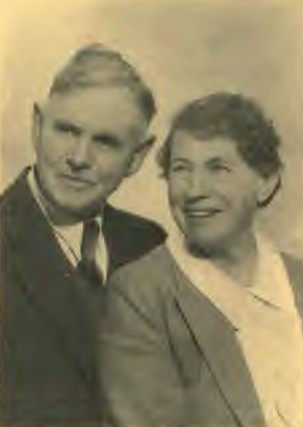 |
|
Arthur Abraham Tinkler and Annie Evelyn
(Kilroy) Tinkler
|
25 September 1880, at Ballahanna,
Kilnaleck parish, county Cavan, Ireland
Anne was born on Twenty fifth September at Ballahanna, the daughter of James
Kilroy, farmer, of Ballahanna, and Maria Kilroy formerly Gibbson.
James Watkin
Kilroy
Maria (Gibson) Kilroy
Arthur
Abraham Tinkler on 3 July 1907 in Winnipeg, Manitoba, Canada
Canadian Union Messenger 23 August 1967
p374
Diamond
Anniversary
Mr. and
Mrs. Arthur Tinkler celebrated their 60th wedding anniversary on July 3,
the Centennial year of Canada. Both were born in Ireland, he in Dublin
and she in County Meath. They came to Canada in 1907. They were married
that year in Winnipeg. Brother Tinkler was employed by the T. Eaton Co.
In 1909, Mrs. Tinkler's sister and her family also came out from
Ireland, Mr. and Mrs. Robert Large, Louis, Jack and Sheila. That year
the two families took up homesteads in the Goose Lake area near Vanscoy
in Saskatchewan.
In 1936, the family moved to British Columbia. They lived on
Vancouver Island, in the Fraser Valley and in 1959 moved to the Okanagan
Valley. While in Saskatchewan the Tinkler family embraced the Third
Angel's Message and were baptized by Elder Luther Long. Their daughter,
Kathleen, attended Battleford Academy. Their son, Desmond, is a minister
and is now president of the Maritime Conference. Kathleen Bayliss and
Hubert, her husband, live near her parents on the Joe Rich Road
overlooking beautiful Lake Okanagan. Evelyn Abbey and her husband live
at Creston, British Columbia. The Tinklers have five grandchildren and
two great-grandchildren. They are strong in faith and look forward
eagerly to the coming of Jesus and a home in heaven.
(MRS.) AMY S. WAGNER,
Press Sec. Rutland SDA Church
Drapers Clerk (1907)
Annie emigrated to Canada aboard
the Tunisian which sailed from
Liverpool on 2 May 1907, arriving in Quebec on 11 May 1907. Annie
Kilroy is recorded as single, aged 25, a draper's clerk, listed as born in
England. Her destination is Winnipeg. Also on board the Tunisian
was Arthur Tinkler, who was to marry Anne in Winnipeg less than two
months later. Although they are not listed together in the manifest, it
seems likely that they knew each other in Ireland and booked passage
together - the two travelled using tickets with consecutive numbers, 27329
and 27330.
22 January 1976, in Kelowna General
Hospital, Kelowna, British Columbia, Canada, of pneumonia, aged 95
Canadian Union Messenger 15 November 1976
p421
OBITUARIES
TINKLER—Annie
Evelyn Kilroy was born at Graddenston House, County Meeth, Ireland,
September 25, 1881. She came to Canada in 1907 and married Arthur A.
Tinkler the same year. She was a brave pioneer, a wonderful mother, a
friend and midwife to the early settlers in Saskatchewan where they
homesteaded near Saskatoon. Her first child, Desmond, was dedicated to
God for the ministry, and her prayers were answered. Sister Tinkler
embraced the third angel's message in 1930 and was an active and
faithful member of the church. She passed to her rest on January 22,
1976 at the age of 95 years, in the Kelowna General Hospital and awaits
the call of Jesus on that Great Day. In every community where Sister
Tinkler lived she organized and conducted a Branch Sabbath School in her
home which she called Sunbeam Classes. Many youth today look back to
these classes as the beginning of their Christian Life. Sister Tinkler
leaves to mourn, her husband, Arthur A. Tinkler of Kelowna, B.C., one
son Elder Desmond Tinkler of Armstrong, B.C., two daughters Kathleen May
Bayliss of Kelowna and Evelyn Vera Abbey of Creston, five grandchildren
and ten great-grandchildren, and a host of those who loved her.
British
Columbia Conference of SDA
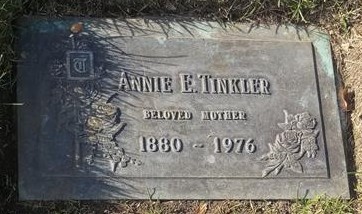 |
|
Gravestone of Annie Evelyn (Kilroy)
Tinkler in Kelowna Memorial Park cemetery, Kelowna, British
Columbia
|
27 January 1976, in Kelowna Memorial
Park cemetery, Kelowna, British Columbia, Canada. Annie is buried in plot C
3 99 79.
1911:
Saskatoon district, Saskatchewan
1916:
Saskatoon district, Saskatchewan
1964: Kelowna, British Columbia (Canadian Union Messenger 7 October 1964
p363)
1976: 2268 Pandosy Street, Kelowna, British Columbia (British
Columbia Death Registrations #76-09-002475)
Annie Kathleen Maxwell (Kilroy) Gosnell
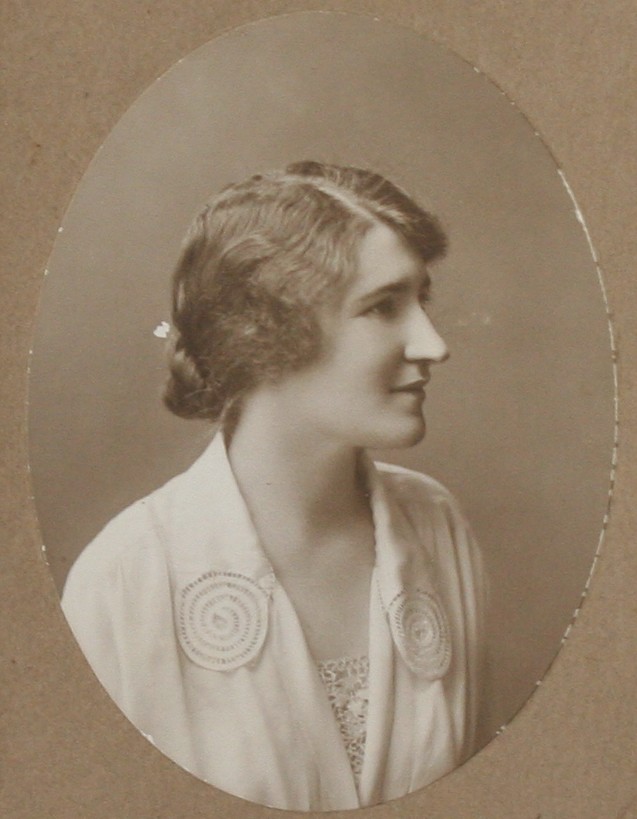 |
|
Annie Kathleen (Kilroy) Gosnell
(1923, Dublin)
photograph from Jerry Gosnell
|
known as "Kathleen" and "Kay"
5 August 1896, at Moat View,
Oldcastle, county Meath, Ireland
Annie Kathleen Maxwell is recorded as born on August fifth 1896 at Moat
View, Oldcastle, the daughter of William Westley Kilroy, gentleman, of Moat
View, Oldcastle and Annie Kathleen Maxwell Kilroy formerly Groome.
20 September 1896, in Oldcastle,
county Meath, Ireland
William
Wesley Kilroy
Annie
Catherine Maxwell (Groome) Kilroy
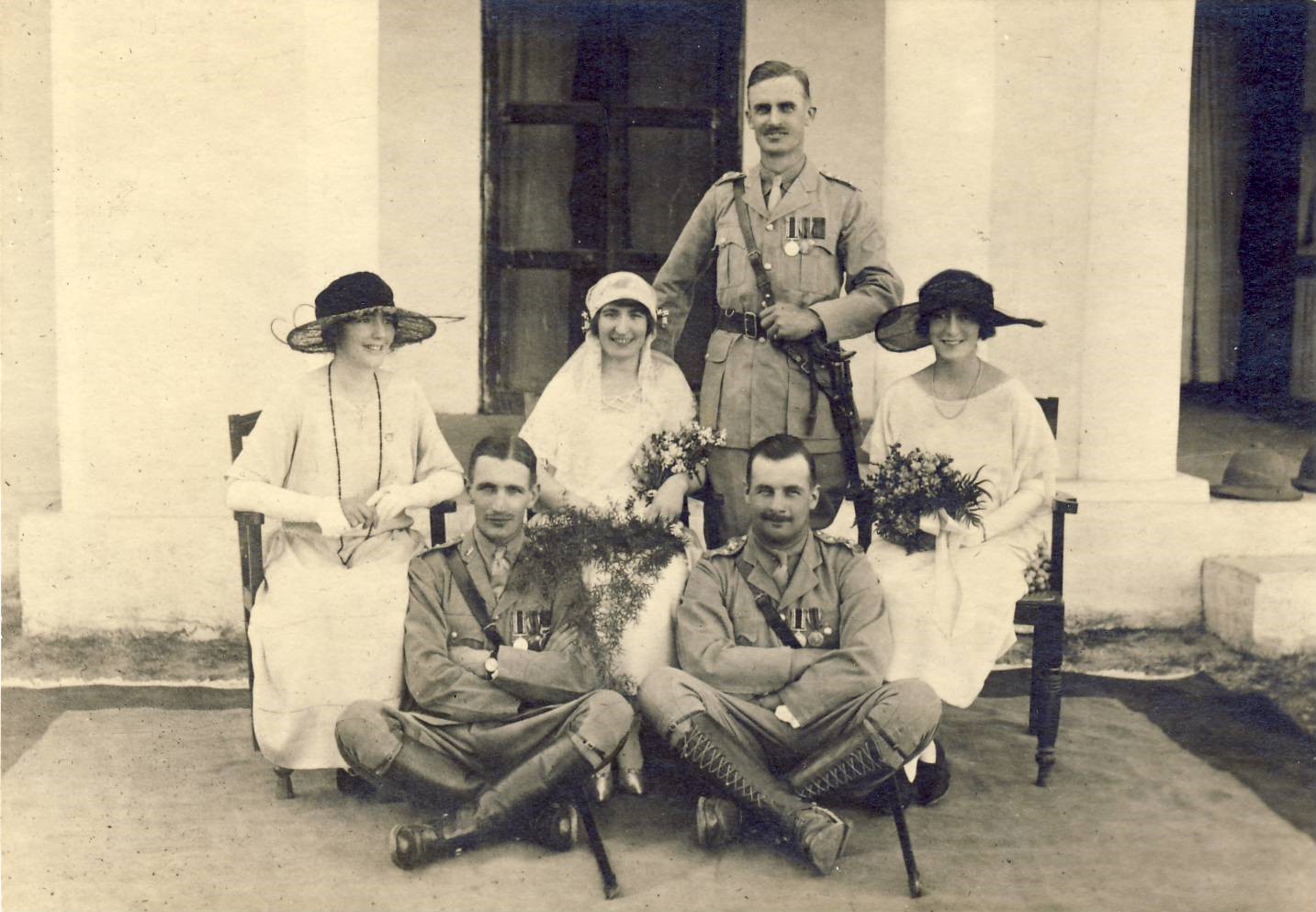 |
|
Wedding of Kenneth Arthur Gosnell and
Annie Kathleen Maxwell Kilroy in Nasirabad, India on 31 October
1922
photograph from Jerry Gosnell
|
Kenneth
Arthur Gosnell on 31 October 1922, in St. Paul's Church, Nasirabad,
Rajputana, India
Annie's driver's license from 1919
lists her height as 5ft 6 3/4 in, her build as "slight" and her hair
as fair.
28 February 1984, in Johannesburg,
Transvaal, South Africa
Ashes interred in the Garden of
Remembrance, White River, Transvaal, South Africa
|
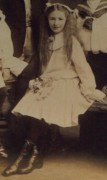 |
|
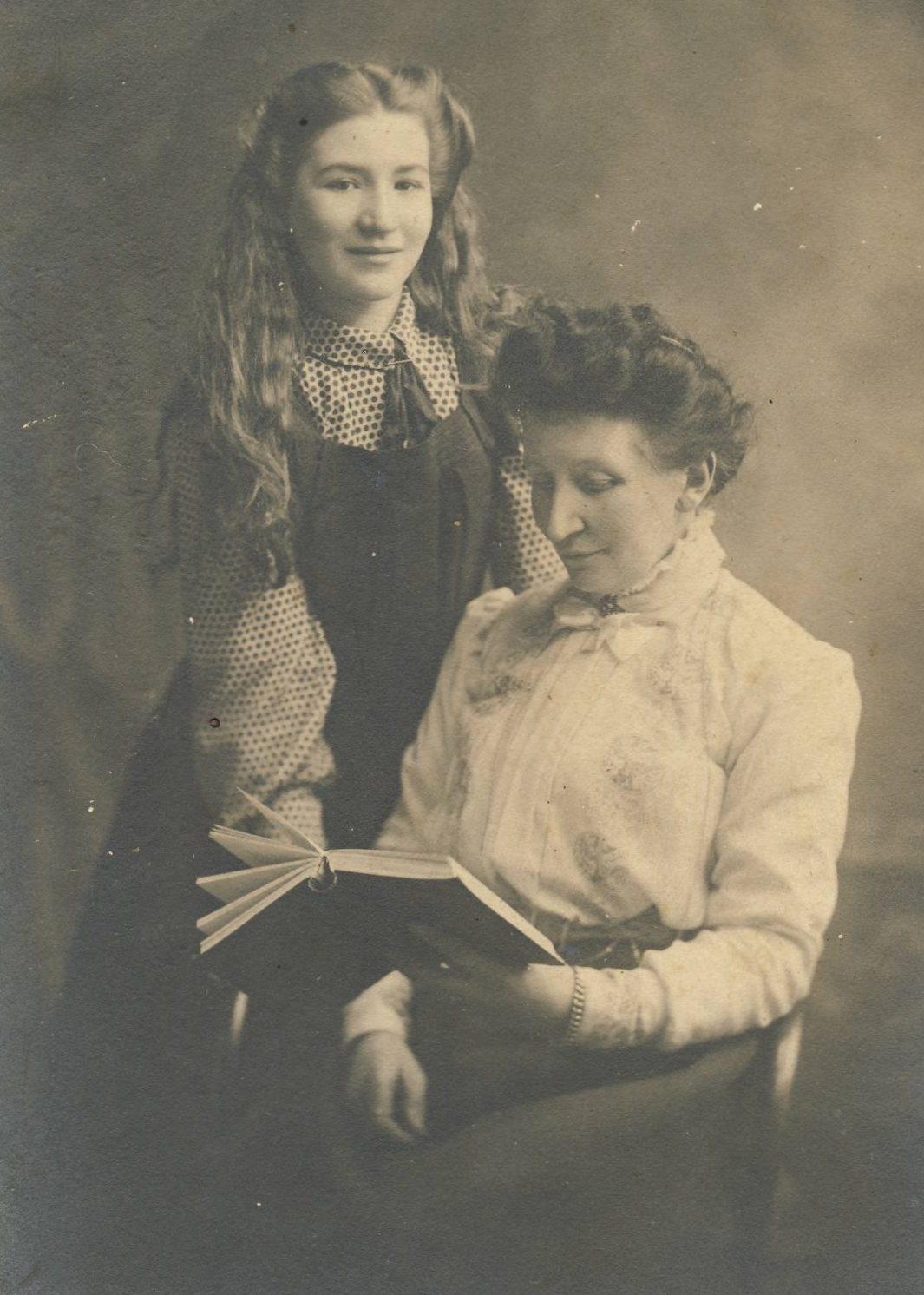 |
|
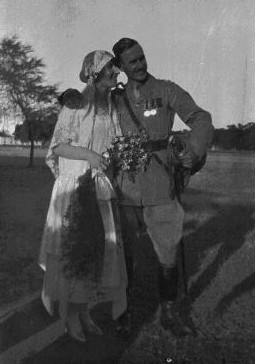 |
|
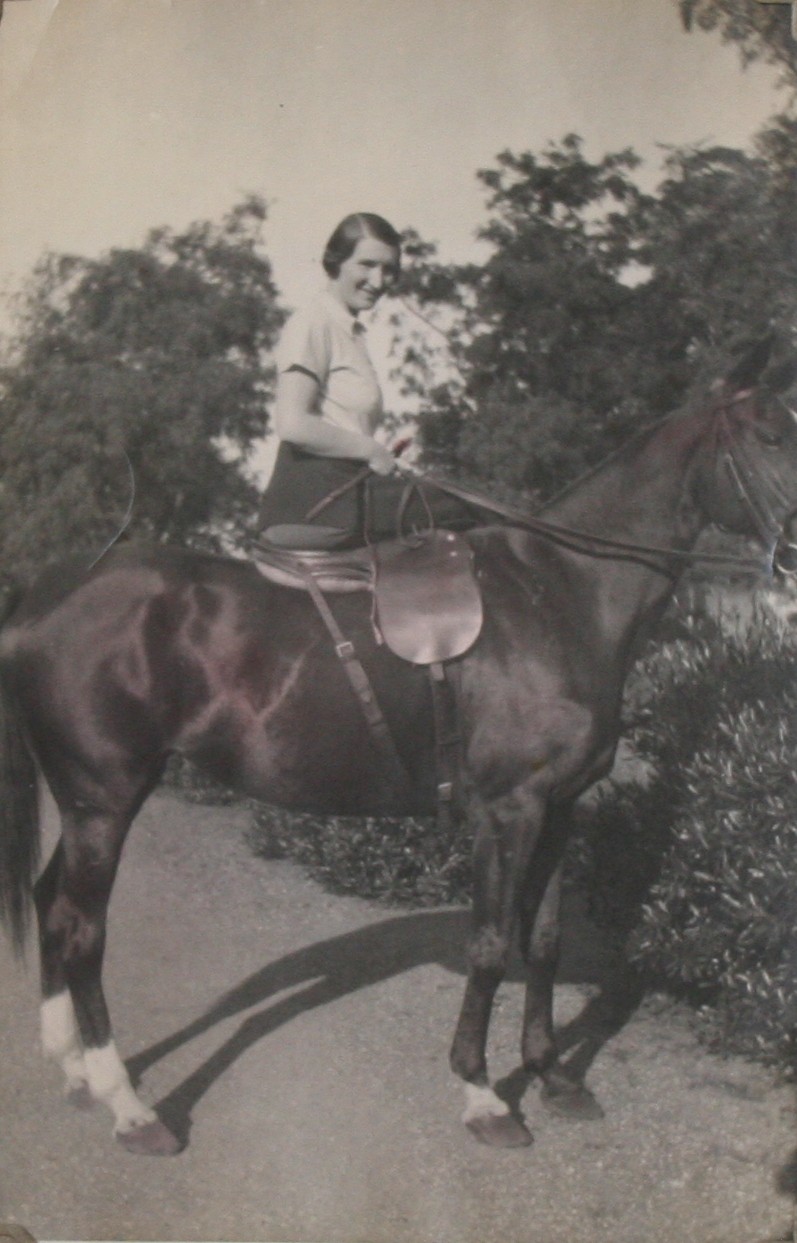 |
|
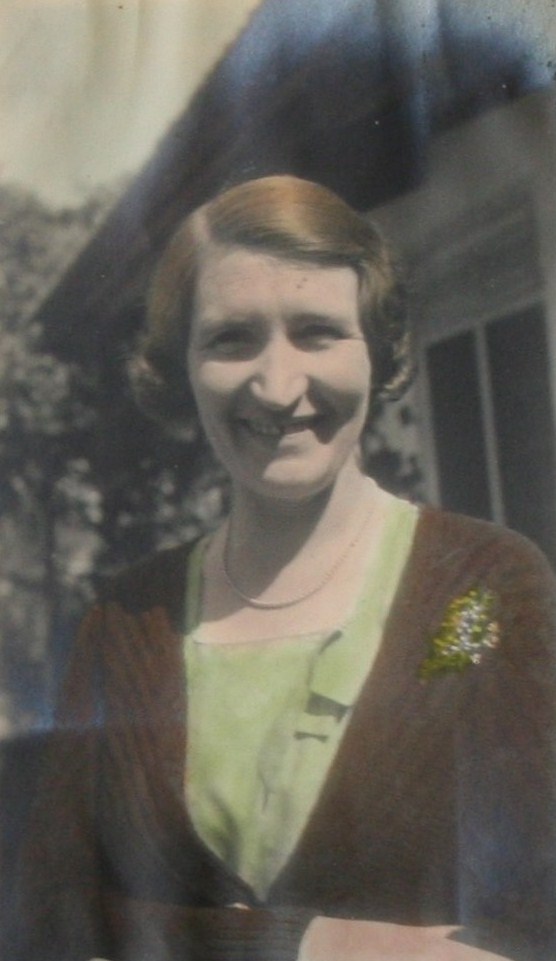 |
|
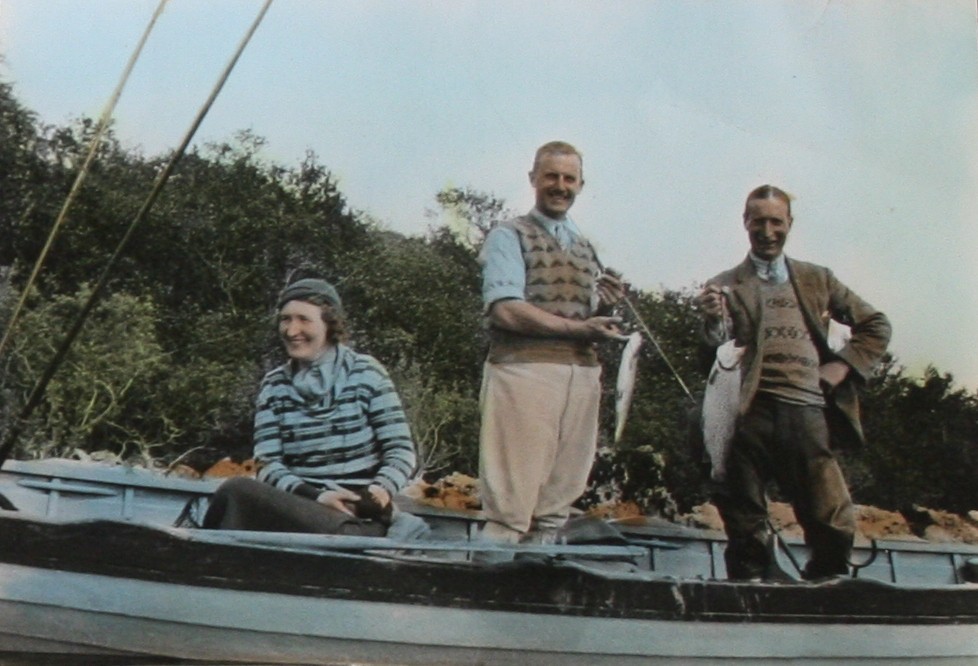 |
|
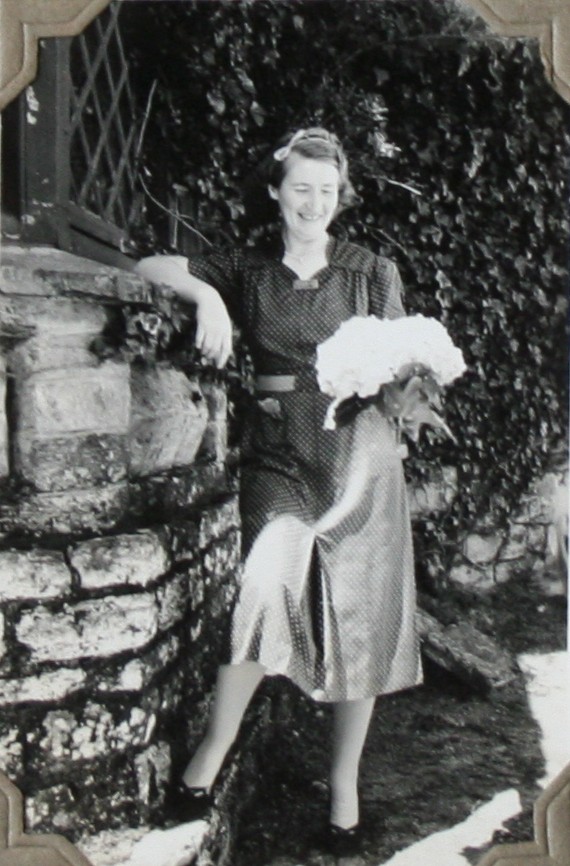 |
|
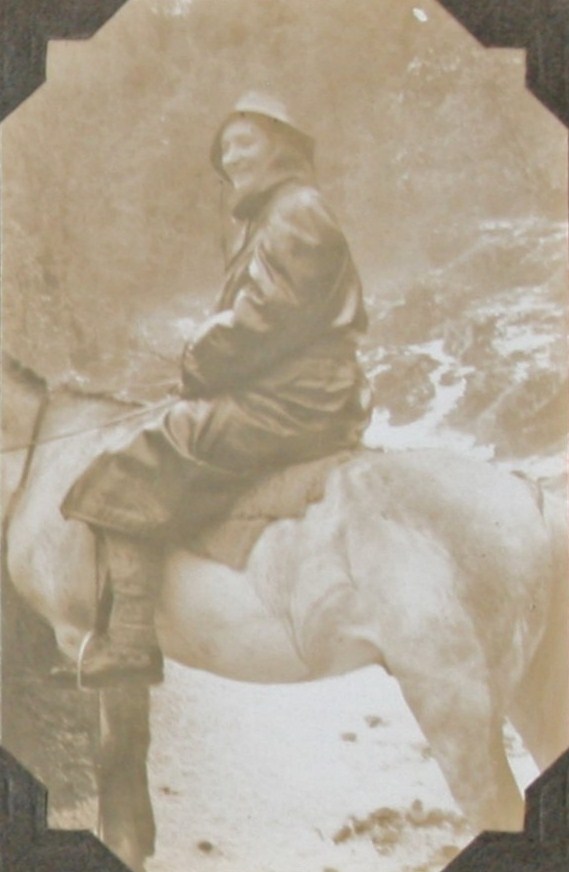 |
|
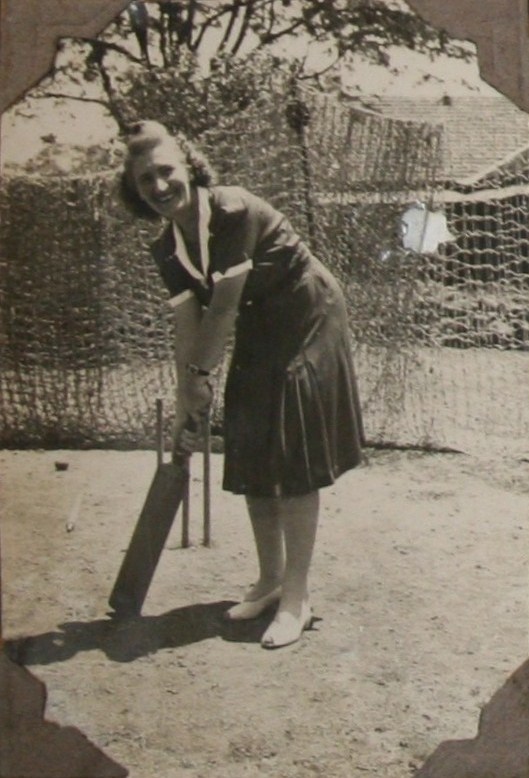 |
|
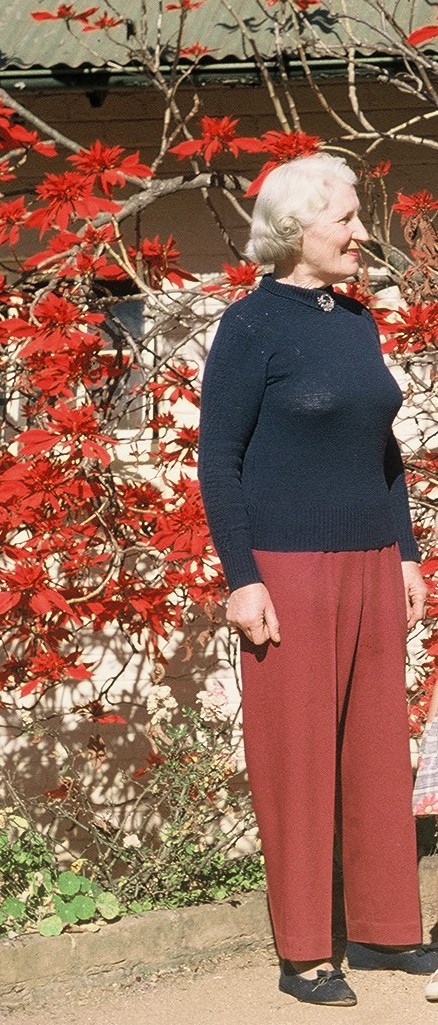 |
|
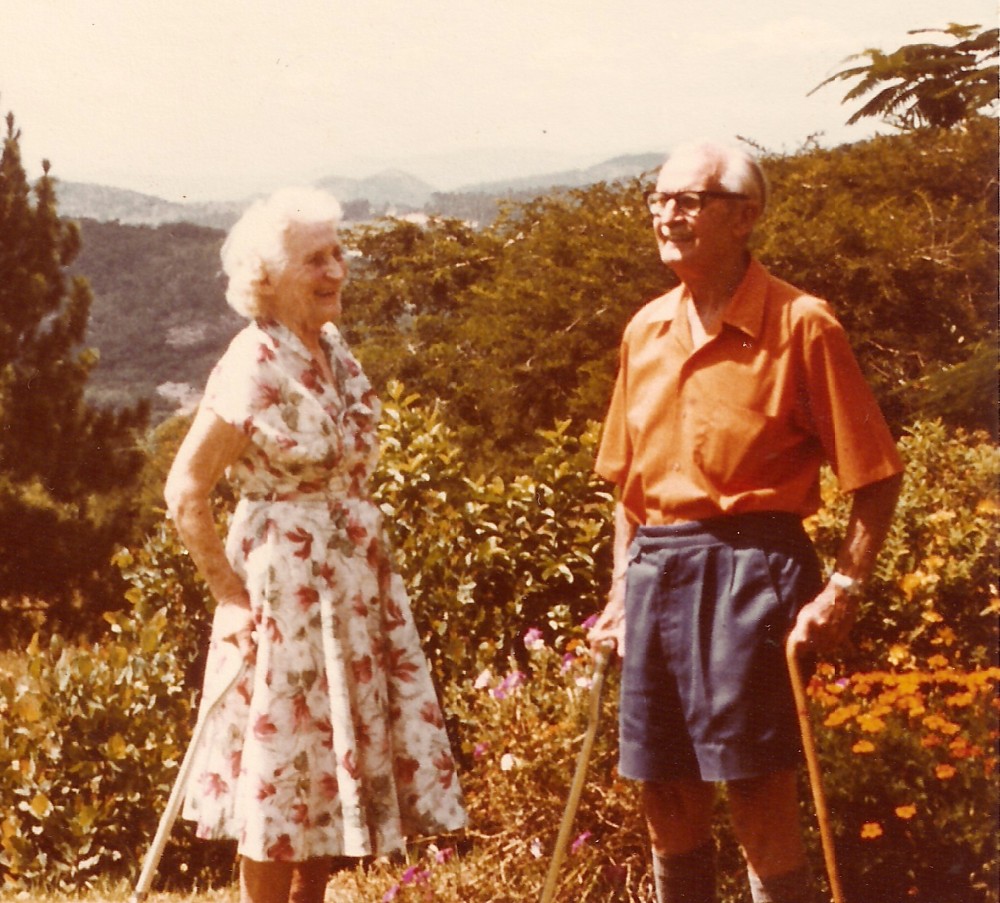 |
|
Childhood
photo from Chris Gosnell
|
|
Annie with her mother
photo from Chris Gosnell
|
|
Wedding
(1922, Nasirabad)
photo from Jerry Gosnell
|
|
Riding Jenny
(1934)
photo from Jerry Gosnell
|
|
At Bexhill-on-Sea
(March 1935)
photo from Jerry Gosnell
|
|
Fishing with Ken Gosnell and Tony
Kilroy
(Lough Sheelin, May 1935)
photo from Jerry Gosnell
|
|
In Jalapahar, near Darjeeling, 1941
photo from Jerry Gosnell
|
|
Phalut Trek - snowstorm near Tonglu
(May 1942)
photo from Jerry Gosnell
|
|
Backyard Cricket
(1943, Poona)
photo from Jerry Gosnell
|
|
White River
(1965)
photo from Jerry Gosnell
|
|
with Ken Gosnell
(White River, 1978)
photo from Jerry Gosnell
|
 scroll
with
your mouse to see more pictures; click on an image for enlargement
scroll
with
your mouse to see more pictures; click on an image for enlargement

1901:
Moat, Oldcastle, county Meath
1911:
Ladies College, 12 Haddington Terrace, Kingstown, county Dublin
1919: Moat View, Oldcastle, county Meath (driver's license)
Anthony Kilroy
1776, in Ballymachugh, county Cavan,
Ireland
_____
Kilroy
Elisa ____
Farmer. The 1821 census show
Anthony farming 44 acres in Turin, Ballymachugh, county Cavan.
1825. Annie Kathleen Kilroy writes
that "Great grandfather Kilroy" was killed coming home from a hunt in his
red coat. He was walking his horse with Lord Farnham when his horse slipped
and threw him. The date of this event is not entirely clear. Kathleen notes
that he left a son aged 19, (making this event about 1825) but also that
"Grandfather married at 21", a marriage we know happened in 1834, so this
death could conceivably have been two years earlier, in 1832. Either way,
Lord Farnham would have been the 5th Baron, John Barry Maxwell (1767 -
1838).
1821:
Turin, Ballymachugh, county Cavan
- 1821 census has Anthony's
age as 45 indicating birth in 1775/6; WorldConnect
(:3234399) has year as 1776 and place as Ballymachugh, although
both may have been inferred from the 1821 census
- 1821 census
- 1821 census
- Kilroy family notes
Anthony Kilroy
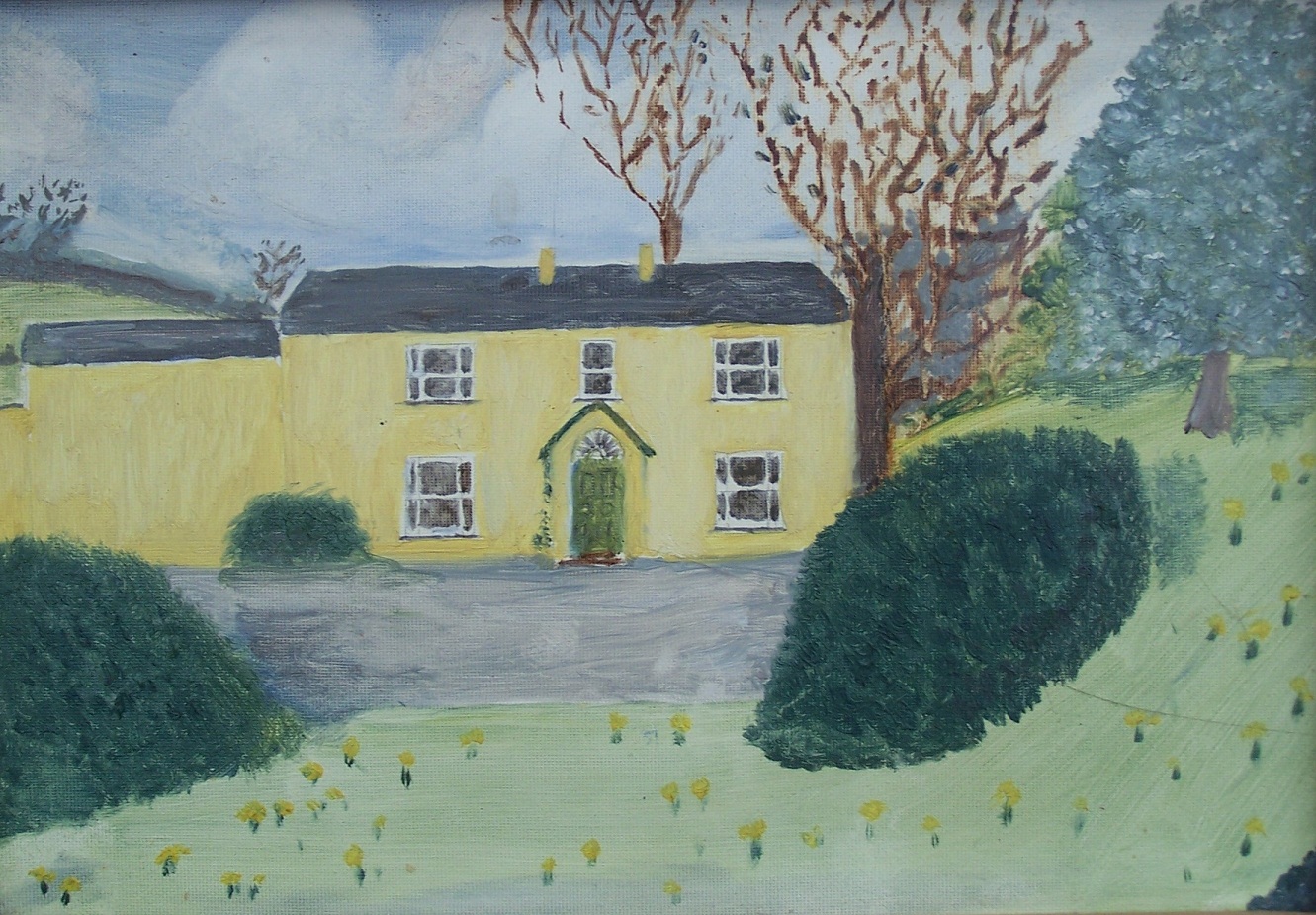 |
|
Omard Villa, Omard, county Cavan
painting by Finola Sweeney
|
of "Omard Villa", Omard, county Cavan
1804/5
Richard Kilroy
Elizabeth (_____) Kilroy
Catherine Burrow on 21
February 1832 in St Peters, Dublin, county Dublin, Ireland. The marriage was
witnessed by Thomas Burrow and Henry Lamange. Catherine's address is
recorded as 44 Harcourt Street, St Peter, and Anthony's address is
recorded as Omard, Ballymoore, county Cavan.
Kitty Bourke-Wright, Anthony's
grand-daughter writes that Anthony sold Omard about 1876, and went to live
in England. The house fell into disrepair and was demolished in the 1980s.
Only some of the farm's stone outbuildings remain. Kitty writes that she
"used to hear as a child what a good man Grandfather Anthony Kilroy was and
how he - the eldest - had brought up a large family of brothers and sisters
when their father (or their parents) had died at an early age". A later
resident of the house, after the Kilroys had sold up, was told as a child
that if she did not behave well "the ghost of Anthony Kilroy will get you".
W.W. Kilroy wrote in 1926 that all of Anthony's children were then dead.
15 August 1877 at 38 Leinster
road, Rathmines, county Dublin, Ireland, aged 73
Cavan
Weekly News, 10 August 1877
DEATH.
KILROY - On the 15th inst., at 38 Leinster road, Rathmines,
Anthony Kilroy, Esq., late of Omard, County Cavan, in his 73rd year.
proved 30 August 1878, by Alexander
Robert Kilroy
Ireland
Calendar of Wills 1878 p375
KILROY
Anthony. 30 August. The Will (with two Codicils) of Anthony
Kilroy late of 38 Leinster-road County Dublin
Esquire deceased who died 15 August 1877 at same place was proved at the
Principal Registry by the oath
of Alexander Robert Kilroy of Benares in India Army Surgeon one of the
Executors. Effects under £4000.
1821:
Omard, Ballymachugh, county Cavan
Anthony Kilroy
1820, in Turin, parish of
Ballymachugh, county Cavan, Ireland
Anthony
Kilroy
Elisa (_____)
Kilroy
1821:
Turin, Ballymachugh, county Cavan
- 1821 census lists
Anthony as aged 10 months, indicating birth in 1820; IGI has place as
Turin
- 1821 census
Anthony Kilroy
1 January 1840, in Cavan, Ireland
James Kilroy
Anne
Moore
Kilroy
Court, a street in Cranbrook, Townsville, Queensland, is named after
Anthony.
Highways and Byways - The Origin of Townsville Street
Names p72 (John Mathew, 2008)
Kilroy Court, Cranbrook. In 1865,
Anthony Kilroy signed the petition to have a municipality established at
Cleveland Bay.
20 January 1869, in Queensland
Anthony is recorded as the son of James Kilroy. He was born in Ireland and
died aged about 27 years.
Anthony went to Australia and New
Zealand with his brother George. It seems the took separate paths fairly
early - George is recorded in Melbourne as early as 1862, and Anthony is
recorded in Townsville, Queensland in 1865.
Beryl Lila Kilroy
1907, in Hendon
district, Middlesex, England
Willie Dickson
Kilroy
Edith Mary (Maclaran) Kilroy
1914, in Hendon
district, Middlesex, England, aged 7
1911: Hendon district, Middlesex: Beryl Kilroy is aged 3
- England Birth Index
(3Q1907 Hendon vol 3a p247)
- 1911 census
- England Death Index
(3Q1914 Hendon vol 3a p293)
Catherine Kilroy
1813/4
Anthony
Kilroy
Elisa (_____)
Kilroy
1821:
Turin, Ballymachugh, county Cavan
- 1821 census lists
Catherine as aged 7
- 1821 census
Catherine Jane (Kilroy) Wright
Anthony
Kilroy
Catherine (_____) Kilroy
William
Bourke
Wright in 1866, in Cavan district, county Cavan, Ireland
1872/3. Catherine died when her
daughter Kitty, was only 2 years old.
- Ireland Marriage Index
(1866 Cavan vol 3 p93)
- Letter from Kitty Bourke-Wright
- Kilroy family notes
Cecil Montague Godfrey Kilroy
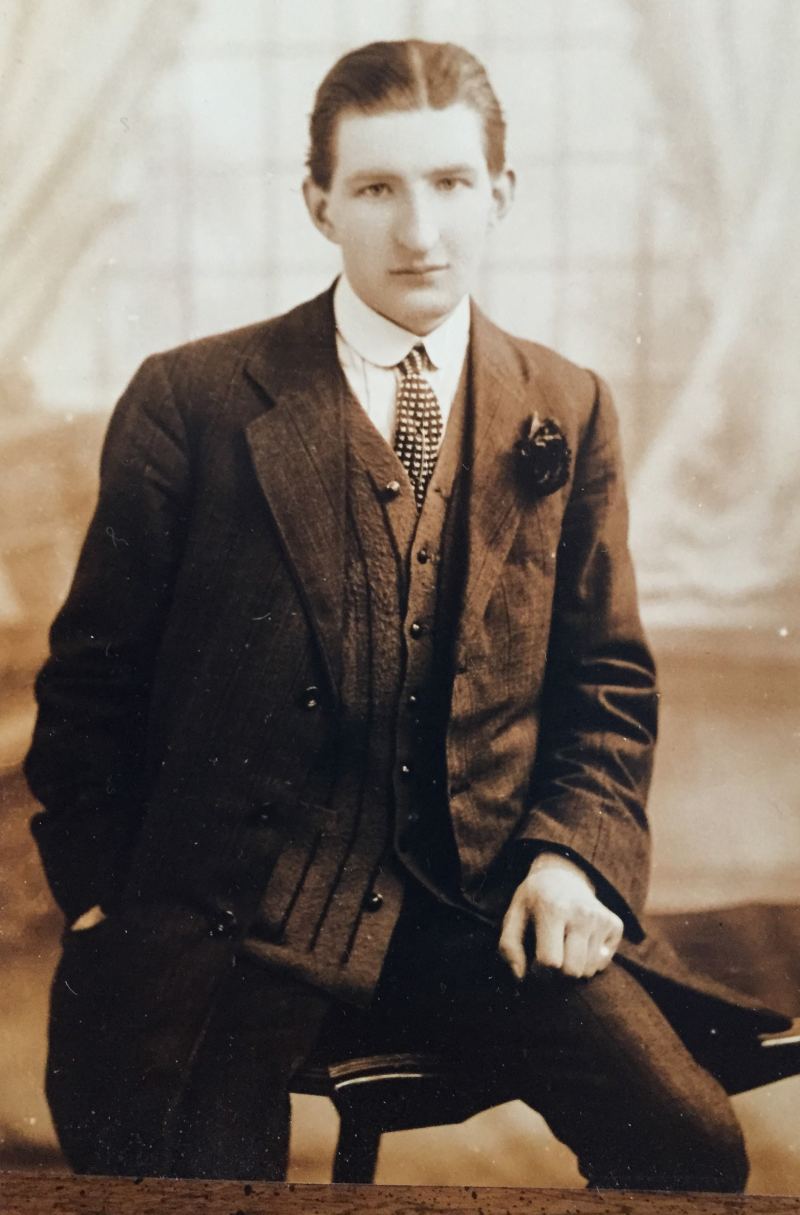 |
|
Cecil Montague Godfrey Kilroy
photograph from Sharon Maughan
|
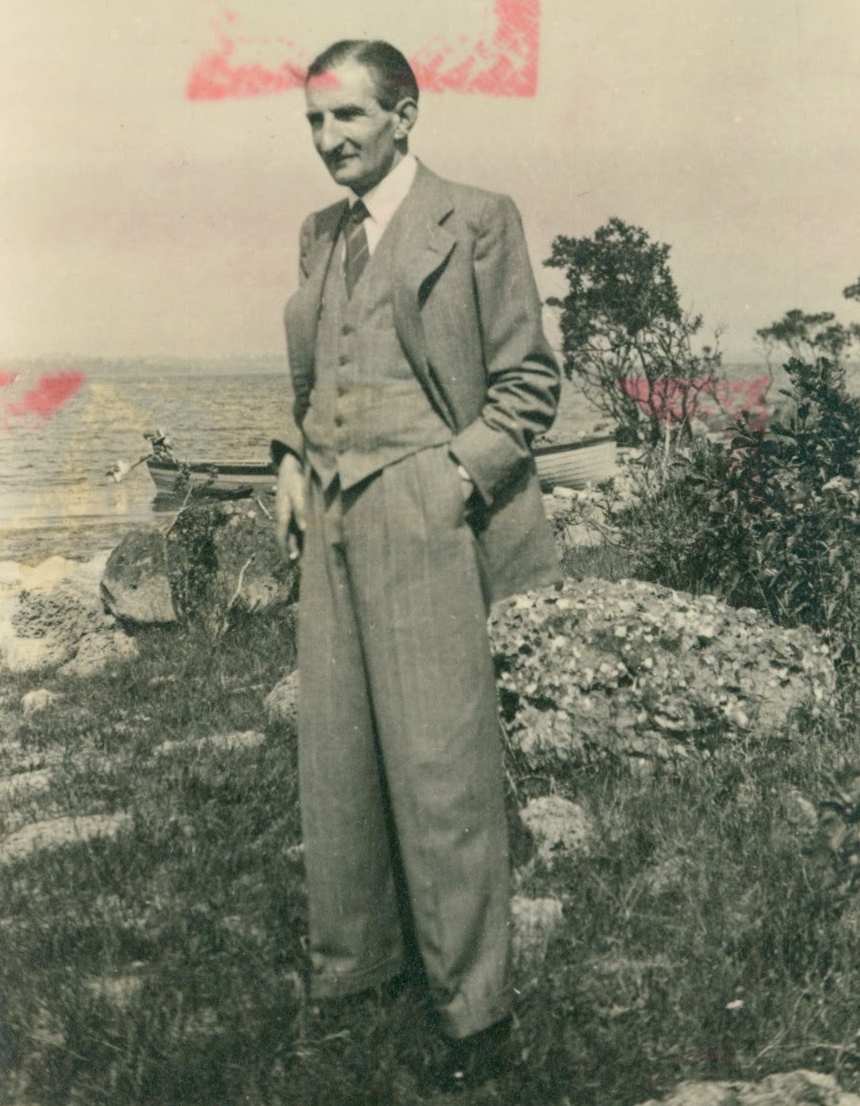 |
|
Cecil Montague Godfrey Kilroy. This looks
to be on the shore of Lough Sheelin.
photograph from Sharon Maughan
|
8 February 1890, at Moat View,
Oldcastle, county Meath, Ireland
William Wesley
Kilroy
Annie
Catherine Maxwell (Groome) Kilroy
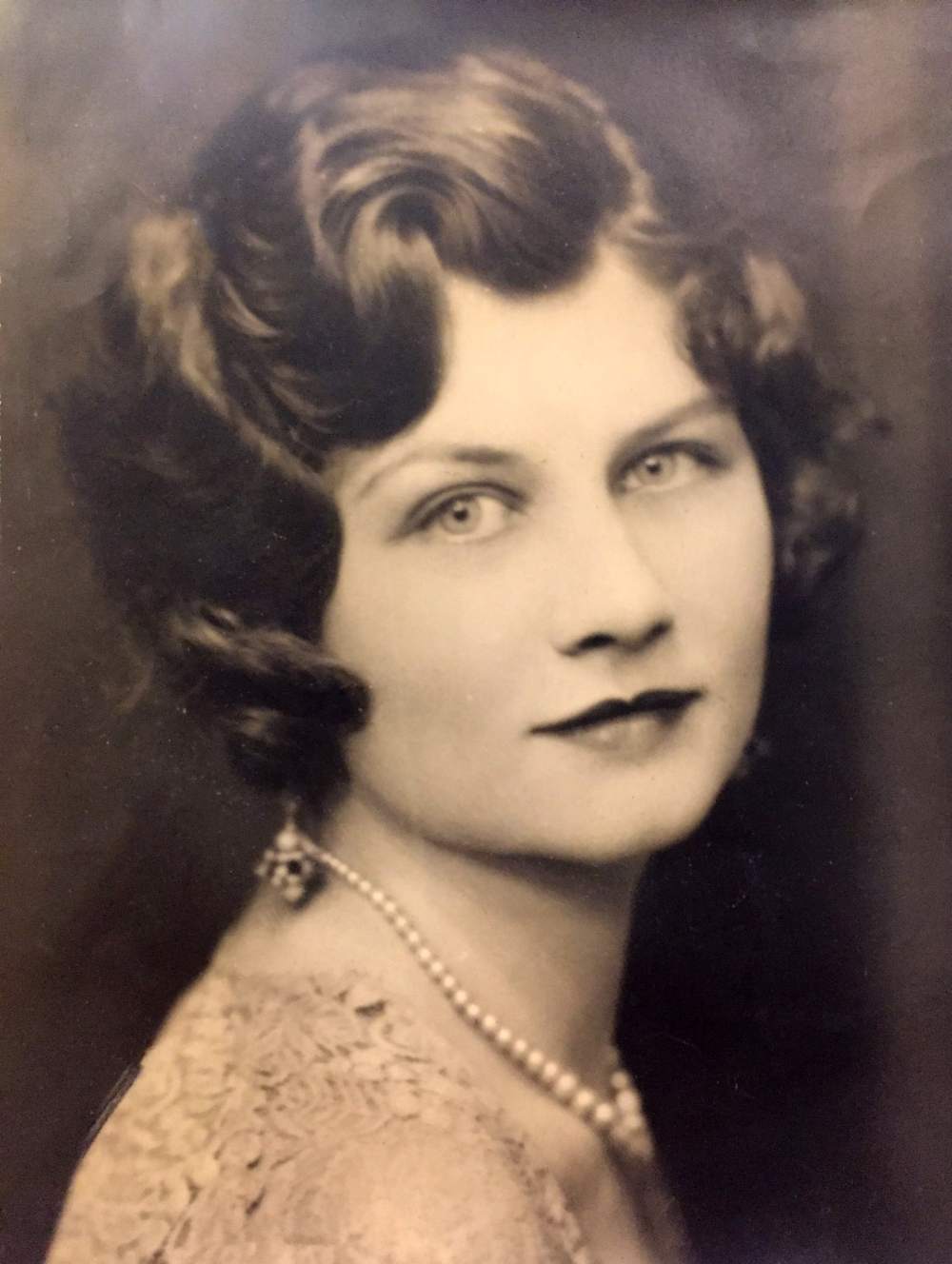 |
|
Gertrude Anna Phair Knight
photograph from Sharon Maughan
|
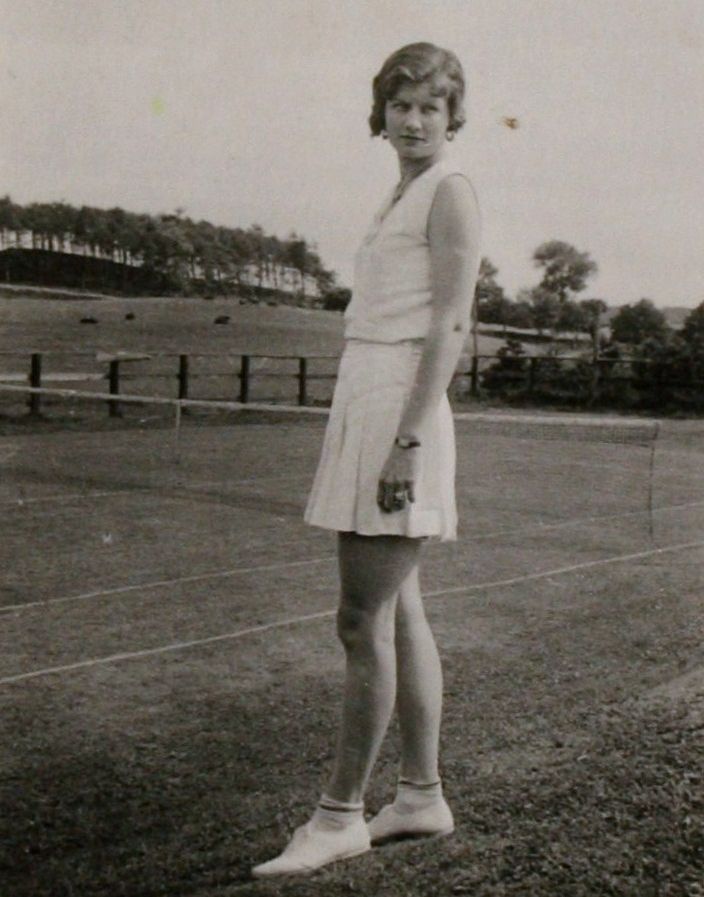 |
|
Gertrude Anna Phair (Knight) Kilroy at
Moat View, Oldcastle, in 1934
photograph from Jerry Gosnell
|
Gertrude Anna Phair Knight on 29
March 1934 in St Catherine's Church, Tullamore, King's County, Ireland
Cecil Montague Godfrey Kilroy is recorded as a bachelor, of full age, the
son of William W. Kilroy, a farmer and land agent. Cecil's occupation is
listed as Bank Official and he is resident in Kilbeggan, county Westmeath.
Gertrude Anna Phair Knight is listed as a spinster, 19 years old, resident
at Bank House, Kilbeggan, Westmeath.
Gertrude, who was known as Trudi, was born on 23 April 1914, in Sacramento,
California, United States, the daughter of Albert Cowles Knight and Matilda Maude Phair. Her U.S.
passport describes her as 5 foot 9 inches tall, with brown haor and blue
eyes. On 1 December 1945 Gertrude flew
on Pan American Airways from Shannon to New York, listing an address
in the US as 1801 N. Normandie, Hollywood, CA. Cecil and Gertrude's marriage
ended in divorce. Trudi married, secondly, Glenn August Moore on 6 April
1956. She died on 13 April 1994 in Kent, King county, Washington, United
States.
Clerk, Author and Dramatist
(1911); Bank Official (1934)
On his marriage certificate, Cecil
signed his name as Godfrey, so he may have sometimes used his middle name.
22 February 1961, in Dublin, Ireland,
aged 71
24 February 1961, in Deansgrange
Cemetery, Dublin, Ireland
The Headstone reads:
CECIL GODFREY KILROY | died 22nd Feb. 1961 aged
71 | "Abide with Me"
1901:
Moat,
Oldcastle, county Meath
1911: 36
Chelmsford Road, St Peters, county Dublin
(Daisy) Margaret Kilroy Kenyon
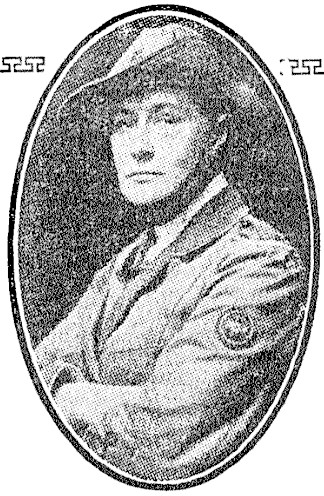 |
|
Margaret Kilroy Kenyon
"MRS KILROY KENYON, Sub-commandant Woman's Reserve Ambulance,
distinguished for taking command of the situation and picking up
the wounded in London Zeppelin raids."
|
Ms. Kilroy Kenyon was born with the name "Daisy" as in the birth index,
early censuses and the marriage index. On the stage in New York, she
appeared as Margaret Kilroy, and after her marriage she consistently used
the name Margaret Kilroy Kenyon, which is the name under which she received
her M.B.E., and is on her death records. Daisy is quite commonly seen as a
nickname for Margaret, but this case appears to be the opposite, where Daisy
lengthened her name to Margaret.
1880, in Winchester, Hampshire,
England
Philip Le
Feuvre Kilroy
Louisa Susan (Le Feuvre) Kilroy
Leslie
Kenyon on 3 July 1907, in All Saints, Ryde, Isle of Wight, England
Leslie Kenyon is recorded as aged 42, the son of William Serigens Blissley.
Daisy Kilroy is recorded as aged 26, the daughter of Philip Lefevre Kilroy.
The
Medical Press 10 July 1907 p50:
KENYON—KILROY.—On July 3rd, at All Saints'
Church, Ryde, Leslie Kenyon, to Daisy, youngest daughter of the late
Philip Le Feuvre Kilroy, Lieut.-Colonel., R.A.M.C., and Mrs. Kilroy,
Fairfield, Ryde.
Leslie died on 3 January 1914, at Miss Alston's sanatorium in West
Sixty-first Street in New York City, after suffering a stroke.
Reading
Times (Reading, Pennsylvania) 5 January 1914 p3:
LESLIE
KENYON.
In answer to a telegram from the Lambs'
Club, New York city, informing her of the sudden death of her husband
Leslie Kenyon, Mrs. Margaret Kilroy Kenyon, of London, England, who is
spending the winter with Mrs. H. M. Dowie and daughter, Miss Reta M.
Dowie, of Kelmscott Studio, Mount Penn, left Sunday for New York city.
When Margaret arrived in New York, she was upstaged by a young stage
actress, Lillian Sinnott, who claimed that Leslie had been about to
divorce Margaret and marry her. Margaret's reaction gives us some insight
into her character.
Reading
Times (Reading, Pennsylvania) 7 January 1914 p2:
When Kenyon was dying his wife came to
this city in answer to a telegram, Miss Sinnott refused to leave his
bedside and steeled herself to face the wife's reproaches. But no such
ordeal presented itself. Instead Mrs. Kenyon was quickly touched by the
girl's obvious intensity of grief and acted and spoke in the kindest way
to her. She even said that she could understand readily how Kenyon had
fallen in love with so charming a young woman. She had realized in their
long separation that Kenyon might be lost to her. Dr. Oscar M. Leiser,
of 263 West Forty-fifth street, who attended Mr. Kenyon, was present
when the women met... "When they left, it was in sorrow, not in anger,"
he said last night to a reporter. "All the time they were together not
one harsh word was spoken."
Margaret's kindness to Lillian was for naught. On the morning of Leslie's
funeral, Lillian committed suicide.
Margaret was a minor stage actress
appearing in London and on Broadway for a few years. She played the part of
Martha Cragg in Swift and Vanessa
at the Court in London in 1904 (The London Stage 1900-1909: A Calendar of Productions,
Performers, and Personnel p170). Margaret sailed to New York
from Liverpool aboard
the Celtic, arriving on 30 July
1904 and the manifest records that she planned to join her friend
Leslie Kenyon (whom she was to marry in 1907) of the Lambs Club, New York.
Margaret appeared in The Misanthrope which ran at the
New Amsterdam Theatre in New York from 10 April 1905 until 15 April 1905 (Internet
Broadway Database). She evidently returned to England in the off
season, and both her and Leslie are found on the passenger
list of the Friesland which
departed Liverpool on 16 August 1905, arriving in Philadelphia on 27 August
1905. Margaret appeared again in a revival of Beau
Brummell which ran at the New Amsterdam from 19 March 1906 until 7
April 1906 (Internet
Broadway Database). Both of these Broadway plays were produced by the
Richard Mansfield Repertory, and Leslie Kenyon also appeared in both
productions. Margaret traveled from Liverpool to New York aboard
the Carmania arriving on 25
July 1906. She was cast
as Page to the Queen in Don Carlos,
by the American Play Company, another production that Leslie also
participated in, as the Duke of Alva.
Margaret Kenyon, and her two year old daughter Eileen, are found on the manifest
of the Cincinnati which
departed from Southampton, arriving in New York on 24 October 1910. On this
trip, Margaret lists her occupation as "Literature" (whereas on previous
trip, she listed her occupation as an actress). She is
described as being 5 ft 5 in tall, of darkish complexion with dark
hair and grey eyes.
Margaret published a book of poetry The Masque of Women in 1911. Another of
Margaret's poems was published in Poetry of Today January-February 1920 p5
STAFFERT'S WOOD
(To Eilidh)
NO woods that I have ever known
More fairy traces bore
Than Staffert's. And when you are grown
You'll love them even more
Than now: because all fairy traces
Are lost in such a lot of
places!
I nearly met old Wayland Smith
Beyond the Forge, one day.
The oak tree Merlin conjured with
Cannot be far away:
And folks out of your history book
Peep through the hedge beyond the brook.
Puck, I am sure, must often dance
Round Squirrel Nutkin Tree!
Prosper le Gai, with shield and lance,
Clanks through the greenery:
And Robin Hood might any day
Chance out, and happen on your play!
If you and Hilda creep like mice
When no one else is near—
And wish it hard—why, in a
trice,
You're very apt to hear
The merry laughter of an elf—
You're never far from one, yourself!
M. KILROY KENYON.
Margaret was an active suffragette, at one time chaining herself to the
railings at Hyde Park in support of women's right to vote. In 1915, Margaret
established the Women's Reserve Ambulance in London to respond to Zeppelin
raids and to transport wounded soldiers returned from the front to
hospitals.
The Encyclopædia Britannica 1922 vol 32 p1054
Mrs. Kilroy
Kenyon formed the Women's Reserve Ambulance (Green Cross Corps) in June
1915, a fresh organization on somewhat similar lines to the W.V.R., but
confining its activities mainly to London
The Sun (Canterbury, New Zealand) 24 November
1917 p4
An incident is
recorded of a heroic part recently played by Mrs Kilroy Kenyon,
sub-commandant of the Women's Reserve Ambulance and eight of her band,
who worked side by side with the police, picking up the dead and dying,
putting the highway in order with as much coolness and courage as the
most seasoned soldier.
In 1916 Margaret traveled again to the United States, departing Liverpool
and arriving in New York on the
New York on 28 August 1916. Her
occupation is now recorded as nurse and Margaret
lists
her final destination as Reading, Pennsylvania, to visit Mrs. Dowie,
of Kelmscott Studio, Mount Penn, Berks county, Pennsylvania. Margaret is
described as 5ft 4in tall, with light complexion, dark brown hair and grey
eyes.
Motor Travel December 1916 p30
How
the London Women's Volunteer Corps Treats Its Motor Troubles
AN inspiring account was given recently at a
lecture delivered in New York by Major Kilroy Kenyon, Subcommandant of
The London Women's Volunteer Corps, concerning the longevity of
automobiles when handled with intelligence and resourcefulness.
Mrs Kenyon commands the Automobile Transport and Ambulance
Section of the splendid organization she was very largely instrumental
in forming, a corps of voluntary workers raised by women, maintained by
women and conducted, under the strictest kind of military discipline,
entirely by women.
In the course of the multifarious duties that are admirably
carried out by this fine body of women, a hurry call was received one
day from the military authorities to provide immediately two motor
ambulances, with chauffeurs and ambulance staffs, for the removal of
“cot cases,” as the more desperately wounded are called, from the
incoming hospital trains and to distribute them to the different
hospitals to which they are assigned in and around London. Time was very
short; the first wounded were already being brought down from the front
to the Channel ports for transportation to England, but as far as the
London Women's Volunteer Corps was concerned, such a thing as a motor
ambulance did not exist. However, it was learned that a couple of old
“Briton” motor ambulances, that had been “used up” by the British Red
Cross in Belgium, were lying, red rusted and abandoned, on a scrap heap
in a London suburb euphemistically called a garage. Permission to
appropriate these relics was obtained by the L.W.V.C. and they were
towed to the garage of the corps, a disused stable, for examination. A
careful scrutiny showed the cars to be outwardly practically complete,
so the women, many of whom before the war would have regarded a
punctured bicycle tire as a catastrophe, donned their overalls and,
under the able guidance of Major Kenyon and one or two of her colleagues
to whom the inside of an automobile hood presented no brain-paralyzing
mysteries, set to work on an apparently forlorn hope.
In continuous day and night shifts, sleeping in turns when worn
out in the loft above their garage, the women dismantled the two
engines, replaced what essential parts were beyond repair, repaired
those portions that were at all possible, reassembled the engines and
filled up with gasoline. Then, torn between hope and doubt, the cranking
orderlies laid hold of the crank and swung the engines over. Gallantly
did the two motors respond to their efforts, for they started at the
very first turn, to the accompaniment of one of the heartiest cheers
that ever was uttered. The final result of it all was that among the
first of the ambulances to arrive at their appointed railroad stations
ready, waiting for the first trainload of wounded soldiers to come in,
were two smart looking businesslike “Briton” cars, running without a
hitch, driven by women chauffeurs, and “manned” by staffs of perfectly
trained women orderlies in the handsome khaki uniform of the London
Women's Volunteer Corps.
From the day those two “Briton” ambulances were resuscitated by
the Motor Transport Section of the L.W.V.C. they were kept in constant
use day and night on their errands of mercy. One had a record of well
over 2,500 miles to its credit and the other 3,000 before they at last
really did wear out, and then the women hit on the bright idea of what
Major Kenyon called “marrying the two ‘Britons’ together.” Consequently
they were dismantled once more, the serviceable parts from each were
selected, and with the sole addition of a new main shaft and a few minor
parts that had to be purchase owing to the women not having the
necessary lathes for making them, a fresh and absolutely efficient motor
ambulance was rebuilt from the relics of the former two and was
immediately put into commission.
That was over twelve months ago, but so well and conscientiously
did the women mechanics do their work and so proficient has been the
driving of its women chauffeurs, that the offspring of the “Briton”
wedding is running perfectly and performing its magnificent service to
this day, and apparently shows every indication of continuing
indefinitely. E. H. ST. G. W.
Margaret joined the Women's
Army Auxiliary Corps, the women's unit of the British Army which was
formally instituted on 7 July 1917, and served in France where she was an
Area Controller of the Corps in Calais, with rank equivalent to major. Ruby
Ord, also in the W.A.A.C. remembered in an
interview conducted by the Imperial War Museum in 1973 (reel 1 at 16:17):
We were lucky
when we first went out. We had Mrs Kilroy Kenyon, the famous
suffragette, as our AC. She also was a poetess. But she was one who had
been chained to Hyde Park railings and so of course to us she was a very
famous person. And she was very very good and she supported us. She
fought for the girls against the men because the base commandant, I
think, resented our going there and lots of the male officers resented
our going out there; it was going to cause all sorts of complications,
and etc and we would not be any good at the job, and whoever heard of
women doing this, that and the other, which was all very true.
(reel 4
at 3:04)
Our Mrs Kilroy Kenyon fought [the base
commandant] hard for us, she really did, he was going to make all sorts
of ridiculous regulations and she wouldn't have it any price. So we were
lucky to have her - a strong suffragette she was - fighting for women. I
liked her very much - she was a very good example.
Margaret was promoted from Unit Administrator to Deputy Controller on
21 July 1917 (London Gazette 31 August 1918 p10235) and
Controller on 3 July 1918 (London Gazette 22 November 1918 p13863).
She was awarded an M.B.E. (Member of the Order of the British Empire) in
March 1918 for her efforts (London Gazette 12 March 1918 p3289).
Margaret ceased to be employed by the Corps on 28 December 1918 (London Gazette 14 January 1919 p788).
Margaret studied at Oxford University after the War, entering Somerville
College in 1920. She was active in the acting community there and one
of her fellow students, Margot Collinson, perhaps unaware of Margaret's
background on Broadway, commented in a
letter to her mother on 7 March 1920 "On Thursday we performed
“Everyman” at the Masonic Hall just up the High. It was a very good show,
thanks to the Moberly, who stage managed, and her Waac officer friend, Mrs
Kilroy Kenyon, who acted Everyman and did most of the dressing. She was
superb, and really made the thing go. None of us would have had time for
such a big part, or the power to carry it through."
Margaret Kilroy Kenyon is recorded on the manifest
of the Canopic
in Montreal on 10 September 1922. She is a widow, aged 41, born in
Winchester, England. Her occupation is student and her last permanent
residence is Oxford, England. She lists a friend in England as Commander L.
Kilroy, of Broughton, nr Melton Mowbray, England. She had previously visited
various places in the U.S. from 1903 until 1914. She notes that she intends
to stay permanently in the U.S. and lists a destination as Winnetka nr.
Chicago, Illinois and has a friend Dr. L. E. Taylor of Lincoln Avenue. She
is described as 5ft 5½in tall, of medium complexion with dark hair and grey
eyes.
2 October 1922, in Chicago, Cook
county, Illinois, United States, aged 42
The Fritillary 1922 pp314-5:
In Memoriam
MARGARET KILROY KENYON
Died in Chicago, U.S.A., October 2nd, 1922
It is with the deepest regret that we record the death of Mrs.
Kenyon. She entered Somerville in the Michaelmas Term of 1920. She had
led an exceptionally full and varied life, yet she adapted herself
perfectly to an undergraduate's position. In two years she had become
almost as well-known in the University as in the College.
As President of the O.W.I.D.S., she was an able organiser, as
well as an inspiring leader. Her powers of acting were extraordinary,
and her performance of Everyman
at St. Hilda's in the summer of 1920, and of Bluntschli
in 'Arms and the Man' in Trinity Term of this year, are unforgettable.
In the same Term she became President of the Central Committee, and had,
even in the short time that she held the office, made herself
permanently felt. She also divided the Coombs Prize, which is given at
Somerville for the best history student of the year.
Among her many friends she will be remembered, above all else,
for her sense of comradeship and her unfailing sympathy and humour, as
well as for her genuine modesty and an absence of anything like
self-assertion.
5 October 1922, in Graceland
cemetery, Chicago, Cook county, Illinois, United States
1881: Plymstock,
Devon
1891: 72 Chaucer Road, Bedford St
Paul, Bedfordshire
1901: Pellhurst
Road, Ryde, Isle of Wight
Desmond Albert Frederick Kilroy
19 May 1915, at High Street,
Tullamore, King's County, Ireland
Desmond Albert Frederick was born on Nineteenth May 1915 at High St.,
Tullamore, the son of James A Kilroy, merchant, of High St., Tullamore, and
Lucy Kilroy formerly Hutchinson.
James Arthur
Kilroy
Lucy Hannah (Hutchinson) Kilroy
1991
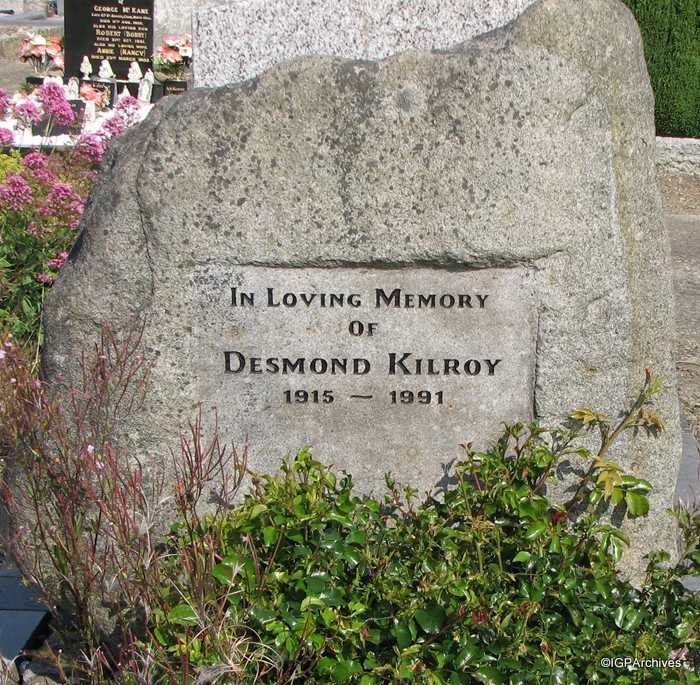 |
|
Headstone of Desmond Albert Frederick
Kilroy in Deansgrange cemetery, Dublin, county Dublin
|
Deansgrange cemetery graveyard,
Rathdown, county Dublin, Ireland.
The headstone reads:
In Loving Memory | of | DESMOND KILROY | 1915 -
1991
Dorothy Kilroy
1909/10, in Massachusetts, United
States
Richard
Thomas
Joseph Kilroy
Cora Evelyn (Terry) Kilroy
1920:
Abington
Town, Plymouth county, Massachusetts
Edith Kilroy
1907/8, in Massachusetts, United
States
Richard
Thomas
Joseph Kilroy
Cora Evelyn (Terry) Kilroy
1920:
Abington
Town, Plymouth county, Massachusetts
Eileen Maude Margaret (Kilroy) Mason
12 November 1892 at Derrysheridan,
Killeagh parish, county Meath, Ireland
Maude Margaret was born on Twelfth November 1892 at Derrysheridan, the
daughter of James W. Kilroy, gentleman, of Derry Sheridan, and Mary
Elizabeth Kilroy formerly Armstrong.
James Watkin
Kilroy
Elizabeth Mary (Armstrong) Kilroy
Ernest V. Mason in 1922 in Croydon
district, Surrey, England
Drapers Assistant (1911)
1901:
Derrysheridan, Killeagh, county Meath
1911: 18
Cannon Street, Kells, county Meath
Elisa (_____) Kilroy
1781/2
Anthony Kilroy
:
1821:
Turin, Ballymachugh, county Cavan
Elizabeth Kilroy
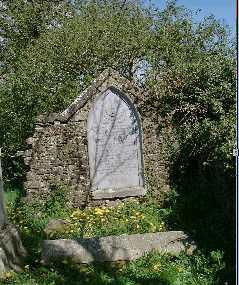 |
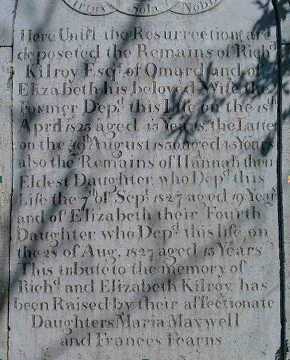 |
|
Gravestone of
Richard and Elizabeth Kilroy, and their daughters Hannah and
Elizabeth, in the churchyard at Ballymachugh Parish Church. It is
probably part of the old church wall.
|
Detail of the
gravestone:
Here Until the
Resurrection are
deposited the Remains of Richd
Kilroy Esq of Omard and of
Elizabeth his beloved Wife the
Former Depd this life on the 18th
April 1823 aged 43 Years the Latter
on the 19th August 1830 aged 45 Years
also the Remains of Hannah their
Eldest daughter who Depd this
life the 7th of Sept 1827 aged 19 Years
and of Elizabeth their Fourth
Daughter who Depd this life on
the 28 of Aug. 1827 aged 13 Years
This tribute to the memory of
Richd and Elizabeth Kilroy has
been Raised by their affectionate
Daughters Maria Maxwell
and Frances Fearns
|
1813/4
Richard Kilroy
Elizabeth (_____) Kilroy
28 August 1827
Ballymachugh Parish Church, county
Cavan, Ireland
1821:
Omard, Ballymachugh, county Cavan
- Aged 13 at death in
1827; aged 6 at 1821 census
- Inscription on
gravestone in Ballymachugh Parish Church
- Inscription on
gravestone in Ballymachugh Parish Church
Elizabeth (Kilroy) Whiteside
1834, in Dublin, county Dublin,
Ireland
Anthony
Kilroy
Catherine (_____) Kilroy
James Arthur Whiteside on 13
February 1857, in St. Anne's Church, Dublin South disrict, county Dublin,
Ireland.
Revd. James Whiteside is recorded as a bachelor, of full age, the son of
James Whiteside, government clerk. He is a clerk in holy orders, resident at
Gleneoy, county Antrim. Elizabeth Kilroy is recorded as a spinster, of full
age, the daughter of Anthony Kilroy, esquire. Elizabeth is resident at
Omard, county Cavan, and 27 Molesworth Street. The marriage was witnessed by
Anthony Kilroy and John Ousley Bonsall.
Cavan Weekly News, 19 February 1857
MARRIED.
On the 13th instant, in Anne's Church, by the Rev. Eugene O'MEARA, the
Rev. James WHITESIDE, of Crumlin, county Antrim, to Elizabeth, eldest
daughter of Anthony KILROY, of Omard, county Cavan, Esq.
James was born in 1823, in Dublin, Ireland, the son of James Whiteside. He
was a clergyman, educated at Trinity College Dublin, where he graduated in
1850.
Alumni Dublinenses
p876:
WHITESIDE, JAMES, Pen. (P.T.), Nov. 6,
1843, aged 20; s. of James, defunctus; b. Dublin. B.A. Vern 1850
James was ordained deacon in 1853 and priest in 1854. He was
appointed curate of Glenavy, county Antrim in 1855 and served as perpetual
curate of Muckamore, county Antrim, from 1860 until 1871, as the incumbent
at Drumbo, county Down from 1871 until 1872, and as rector of Dowra, county
Cavan in 1876. James was then rector of St Peter, Paddington, London from
1876 until 1880, and rector of Penhow, Monmouthshire from 1880 until 1886.
In 1886, he was promoted to vicar of Queen Charlton, Somerset, where he
served until 1894.
Glenavy
Parish Church Clergy List
1855 JAMES WHITESIDE
B c 1823 Dublin; educated privately; entered Trinity College Dublin 6th
November 1843 aged 20 BA 1850
D 1853 p 1854; Curate Glenavy (Conner) 1855; Perpetual Curate Muckamore
1860 - 1871; Incumbent Drumbo (Down) 1871 - 1872; Rector Dowra (Kilm)
1876; Curate St Peter Paddington (Lon) 1876 - 1880; Rector Pen how (Mon)
1880 - 1886; Vicar Queen Charlton Somerset (B&W) 1886 - 1894. Res and
lived at Bath.
Son of James Whiteside.
South Wales Daily News 18 October 1886 p4:
The Rev. James Whiteside, rector of Penhow, has been licensed to the
perpetual curacy of Queen Charlton, Somerset.
James died on 20 June 1910, in Bath, Somerset, aged 86.
Census & Addresses:
1857: Glenavy, county Antrim (marriage
certificate)
1857: Crumlin, county Antrim (Cavan
Weekly News, 19 February 1857)
1881: Penhow,
Monmouth, Wales
1881: Penhow Rectory, Caerleon, Wales (Tenby Observer, 25 August 1881 p2)
1891: Royal
Crescent, Bath, Somerset
1901: Pulteney
Street, Bath, Somerset
1912, in Bath
district, Somerset, England
1857: Omard, county Cavan, and 27 Molesworth Street, Dublin (marriage
certificate)
1881: Penhow,
Monmouth, Wales
1889: 12 Burlington Street, Bath, Somerset (Kelly's
Directory of Somerset, 1889)
1891: Royal
Crescent, Bath, Somerset
1901: Pulteney
Street, Bath, Somerset
1911: Bath,
Somerset
Elizabeth Frances (Kilroy) Porter
15 May 1836, in Ballymachugh, county
Cavan, Ireland
James Kilroy
Anne
Moore
George
Porter on 11 April 1860, in Ballymachugh, county Cavan, Ireland
20 July 1907, at Beabeg, St. Mary's,
county Meath, Ireland, aged 72. The cause of death is recorded as acute
bronchitis, of 14 days duration.
1901:
Bey Beg, St. Mary's, county Meath (listed as Frances Elizabeth)
Emma Martha (Kilroy) Carson
12 March 1850, in Ballymachugh,
county Cavan, Ireland
James Kilroy
Anne
Moore
Samuel
Crawford
Carson on 25 May 1886, in the parish church of Dublin St Peter, county
Dublin, Ireland
Samuel Crawford Carson is recorded as a bachelor, of full age, the son of
John Carson, farmer. Samuel is a farmer, resident at Corcreeghy, county
Monaghan. Emma Martha Kilroy is recorded as a spinster, of full age, the
daughter of James Kilroy, farmer. Emma is resident at 6 Harcourt Street and
Moate House, Oldcastle. The marriage was witnessed by Wm. W. Kilroy and R.
J. Parker.
21 September 1933 at 11 Clarinda Park
N, Dun Laoghaire, county Dublin, Irleand, aged 83. The cause of death is
listed as hemiplegia.
1886: 6 Harcourt Street, Dublin and Moate House, Oldcastle, county
Meath (Ireland
civil records Marriages 1886 Dublin St Peter #191)
1901:
Corcreeghy, Bellanode, county Monaghan
1911: 11
Clarinda Park North, Kingstown, county Dublin
Ethel Essie (Kilroy) Ferguson
16 October 1893 at Derrysheridan,
Killeagh parish, county Meath, Ireland
Ethel Essie was born on Sixteenth October 1893 at Derry-Sheridan, the
daughter of James Watkins Kilroy, gentleman, of Derry-Sheridan, and
Elizabeth Mary Kilroy formerly Armstrong.
James Watkin
Kilroy
Elizabeth Mary (Armstrong) Kilroy
Sherard
Freeman Statham Ferguson on 7 April 1915, in the parish church,
Munterconnaught, county Cavan, Ireland
Sherard F. S. Ferguson is recorded as a bachelor, aged 21 years, the son of
James Ferguson, clerk in holy orders. Sherard is a bank clerk, resident in
Virginia, Virginia parish, county Cavan. Ethel E. Kilroy is recorded as a
spinster, aged 21 years. She is resident at Ryefield House, Munterconnaught
parish. The marriage was witnessed by Percival J. Porter and Eileen M.
Kilroy.
Dressmaker's apprentice (1911)
1967, in Exeter
district, Devon, England, aged 73
29 December 1967, in Kilnasoolagh
churchyard, county Clare, Ireland. The parish register states her to be of
Dublin.
1901:
Derrysheridan, Killeagh, county Meath
1911: 97
Clanbrassil Street, Dundalk, county Louth
Fanny Kilroy
1813, in Turin, parish of
Ballymachugh, county Cavan, Ireland
Anthony
Kilroy
Elisa (_____)
Kilroy
1821:
Turin, Ballymachugh, county Cavan
- 1821 census lists Fanny
as aged 8, indicating birth in 1812 or 1813; IGI has year as 1813, and
place as Turin
- 1821 census
Frances (Kilroy) Fearns
 |
|
Ballymachugh Parish Church
|
1812/3
Richard Kilroy
Elizabeth (_____) Kilroy
_____ Fearns
Ballymachugh
28 May 1821: Omard,
Ballymachugh, county Cavan
- 1821 census
- 1821 census
- Inscription on
father's gravestone in Ballymachugh Parish Church
- A note from Kathleen
Kilroy noting Kilroys buried at Ballymachugh
Franklin Arthur Moore Kilroy
22 September 1910, at High Street,
Tullamore, King's County, Ireland
Franklin Arthur Moore was born on Twenty second September 1910 at High St.,
Tullamore, the son of Arthur Kilroy, merchant of High St., Tullamore, and
Lucy Kilroy formerly Hutchinson.
James Arthur
Kilroy
Lucy Hannah (Hutchinson) Kilroy
Dress Designer
It seems that Frank emigrated to
Canada. He is listed on the manifest
of the Megantic, arriving in
Quebec on 30 October 1926. Frank A. M. Kilroy is aged 15, of Irish
nationality.
Later, Frank is found on a Northern
Arrival Manifest at Niagara Falls, New York, on 30 March 1930. In this
document Frank A. M. Kilroy is listed as aged 19 years and 6 months old, a
dress designer, born in Tullamore, Irish F.S. His last permanent address is
432 Kennedy St, Wpg, Man., and he is going to join the American Fashion Co.
at 4951 W. 36th St., New York City. He is described as being 5 ft 6 in tall,
of fair complexion with brown hair and blue eyes. His nearest relative is
listed as his father, Arthur, of High St. Tullamore, I.F.S. Frank's seaport
of landing was Quebec, in October 1926, on the Megantic, of the White Star
Line.
Frank may be the Frank Kilroy who married Olga Rickert in Winnipeg in 1930 (Manitoba Marriages
1930-033177)
1911:
High Street, Tullamore, Kilbride parish, King's county
1930: 432 Kennedy Street, Winnipeg, Manitoba (Northern
Arrival Manifest at Niagara Falls)
George Thomas Kilroy
24 May 1838, in Cavan, Ireland
James Kilroy
Anne
Moore
Gardener
A number of articles in Melbourne newspapers between 1875 and 1879 note
George's prize-winning pears and apples. He is described as gardener to Mr.
A. P. Blake and later gardener to Mr. James Grice. A sample of these notices
is:
The
Argus 11 March 1875 p5 (Melbourne, Victoria)
THE
HORTICULTURAL SOCIETY'S SHOW.
...On the present occasion, however, two new exhibitors, Mr. Chas. May,
from Sunbury, and Mr. G. Kilroy, gardener to Mr. P. Blake, of Caulfield,
showed excellent specimens of well grown fruit, and won a fair share of
the honours.
The
Argus 30 March 1876 p6 (Melbourne, Victoria)
THE
HORTICULTURAL SOCIETY OF VICTORIA.
...In the Amateur section, Mr. George Kilroy, gardener to Mr. A. P.
Blake, and Mr. A. A. Stuart closely contested the apple and pear
sections, each in turn being the winner.
Weekly
Times 10 March 1877 p7 (Melbourne, Victoria)
HORTICULTURAL
SOCIETY OF VICTORIA.
...From Mr. George Kilroy, gardener to Mr. Black, came fifteen kinds of
apples, several of them well-grown; the first among them were Cox's
Pomona, Adams's Pearmain, Mere de Menage, and King of the Pippins ; also
four kinds of pears, Williams's Bon Chretien and Beurre Clairgeau were
fine-grown specimens.
The
Australasian 9 August 1879 p26 (Melbourne, Victoria)
Report of Fruit
Committee—Mr. George Kilroy, gardener to Mr. James Grice, Caulfield,
exhibited samples of pear, beurre Bretonneau, a late winter dessert
kind, well grown, also samples of Uvedale's St. Germain.
15 June 1884, at Wellington street,
Windsor, Victoria, of acute hepatitis
The
Age 19 June 1884 p1 (Melbourne, Victoria)
KILROY.—On the
15th June, at Wellington street, Windsor, of acute hepatitis, George
Kilroy, native of Cavan, Ireland.
St Kilda cemetery, Melbourne,
Victoria. The grave is in the Wesleyan section, compartment D, grave 37
George went to Australia with his
brother Anthony. It seems the took separate paths fairly early - George is
recorded in Melbourne as early as 1862, and Anthony is recorded in
Townsville, Queensland in 1865.
- IGI (AFN: KMQ4-83)
- Victoria
BMD Deaths 1884 #5804; exact date, place and cause of death from
The
Age 19 June 1884 p1
- Southern
Metropolitan Cemeteries Trust. The burial record contains as its
only information, that George was aged 40, indicating birth in 1843 or
1844. Since so little seemed to be known about George at his death, I
have assumed that the birthdate in the IGI is correct and that he was
really aged 46 at his death and that "40" was just an estimate. Of
course, this George who died in Victoria in 1884 might be someone else
entirely, but the death notice mentions that he is from Cavan, so I do
believe this is the right George Kilroy. Also, a George Thomas Kilroy
(including the middle name) is placed in the Melbourne area in 1862 with
the receipt of a shipped box noted in The Star 24 February 1862 p2
- Notes on the Kilroy
family from Kathleen Kilroy
Guy Philip Kilroy
1909, in Hendon
district, Middlesex, England
Willie Dickson
Kilroy
Edith Mary (Maclaran) Kilroy
Navy Officer, reaching the rank
of Lieutenant-Commander in the Royal Navy.
Acting Cub-Lieutenant G. P. Kilroy was promoted to Sub-Lieutenant on 1
November 1930 (London Gazette 8 April 1932 p2292), and
Lieutenant on 1 November 1932 (London Gazette 9 December 1932 p7832). In
October 1939 Guy was involved in the Minesweeping Section trials of the
'Skid', an early type of electro-magnetic mine sweep towed by the drifter Feaco, and in the subsequent
development of the electric 'AA' sweep strung between two trawlers. Guy was
stationed on the Clyde in 1947. Lieutenant-Commander G. P. Kilroy retired on
15 March 1954 (London Gazette 23 March 1954 p1748).
1911: Hendon district, Middlesex: Guy Philip Kilroy is aged 2
1957: Craigside Cottage, Leckhampton Hill, Cheltenham, Gloucestershire (London Gazette 23 November 1956 p6693)
- England Birth Index
(2Q1909 Hendon vol 3a p252)
- Letter from Willie
Dickson Kilroy to Kathleen (Kilroy) Gosnell (1947), supplied by Chris
Gosnell; 1911 census
- Letter from Willie
Dickson Kilroy to Kathleen (Kilroy) Gosnell (1947), supplied by Chris
Gosnell; The Torpedomen - HMS Vernon's
Story 1872 -1986 by Rear Admiral Nicho Poland
Hannah Kilroy
1802, in Turin, Ballymachugh, county
Cavan, Ireland
Anthony
Kilroy
Elisa (_____)
Kilroy
1821:
Turin, Ballymachugh, county Cavan
- 1821 census lists
"Hana" as aged 19, indicating birth in 1801 or 1802; IGI has year as
1802, and place as Turin
- 1821 census
Hannah Kilroy
 |
 |
|
Gravestone of
Richard and Elizabeth Kilroy, and their daughters Hannah and
Elizabeth, in the churchyard at Ballymachugh Parish Church. It is
probably part of the old church wall.
|
Detail of the
gravestone:
Here Until the
Resurrection are
deposited the Remains of Richd
Kilroy Esq of Omard and of
Elizabeth his beloved Wife the
Former Depd this life on the 18th
April 1823 aged 43 Years the Latter
on the 19th August 1830 aged 45 Years
also the Remains of Hannah their
Eldest daughter who Depd this
life the 7th of Sept 1827 aged 19 Years
and of Elizabeth their Fourth
Daughter who Depd this life on
the 28 of Aug. 1827 aged 13 Years
This tribute to the memory of
Richd and Elizabeth Kilroy has
been Raised by their affectionate
Daughters Maria Maxwell
and Frances Fearns
|
1808
Richard Kilroy
Elizabeth (_____) Kilroy
7 September 1827, aged 19
Ballymachugh Parish Church, county
Cavan, Ireland
1821:
Omard, Ballymachugh, county Cavan
- Aged 19 at death in
1827; aged 12 at 1821 census
- 1821 census
- Inscription on
gravestone in Ballymachugh Parish Church
- Inscription on
gravestone in Ballymachugh Parish Church
Hannah Selina (Kilroy) Purdon
27 March 1844, in Ballymachugh,
county Cavan, Ireland
Anthony
Kilroy
Catherine (_____) Kilroy
John
Edward Blakeney Purdon in 1866, in Cavan district, county Cavan,
Ireland
22 April 1907 in Mendocino county,
California, United States, aged 63 years and 27 days
1900:
Turlock, Stanislaus county, California
- 1900 census; exact date
and place from IGI and from exact age at death
- Ireland Marriage Index
(1866 Cavan vol 3 p93)
- Mendocino County
Recorders Office death records, indexed at Mendocino
County
Indexes
Harold Thomas Kilroy
15 March 1884, at 2 Glen Road,
Eglinton, Dunedin, New Zealand
Otago Witness 5 April 1884 p17
BIRTHS.
On the 15th October, at 2 Glen road, Eglinton, the wife of M. M.
Kilroy, of a son.
Mark Moore
Kilroy
Mary Ellen (Moore) Kilroy
1 January 1899 at Balmoral Creek,
near Balclutha, Otago, New Zealand, aged 14, by drowning
Otago Daily Times 17 January 1889 p2
CASUALTIES
Harold Thomas Kilroy, 15 years of.age, son of Mr Kilroy, in the
employ of Messrs Brown, Ewing, and Co., met his death by drowning on New
Year's Day under distressing circumstances. The family were spending
their holiday at Balmoral Creek, some 10 miles from Balclutha. Mr
Kilroy, after working late on Saturday evening, travelled by the night
train and joined them on Sunday morning. The boy Harold, who was a good
swimmer, had swum across the creek, and was returning, when a gentleman
who was with Mr Kilroy drew his attention to the fact that something
appeared to be the matter with the boy, as he had turned on his back. Mr
Kilroy at once threw off his boots, and went to his son's assistance.
Seizing him by the arms, he had brought him to within a few feet of the
shore when both sank to the bottom, Mr Kilroy being thoroughly
exhausted. On coming to the surface Mr Kilroy found he had lost his hold
of his son. His friend managed to drag him ashore, and as soon as he had
regained a little strength he made another determined effort to save the
boy, but was unsuccessful. It was not till some time had elapsed that
the body was recovered, and then life was extinct. Much sympathy is felt
for the parents. The boy, who was a pupil at the Otago Boys' High
School, was a bright, intelligent youth, and had won some prizes during
his short career at school.
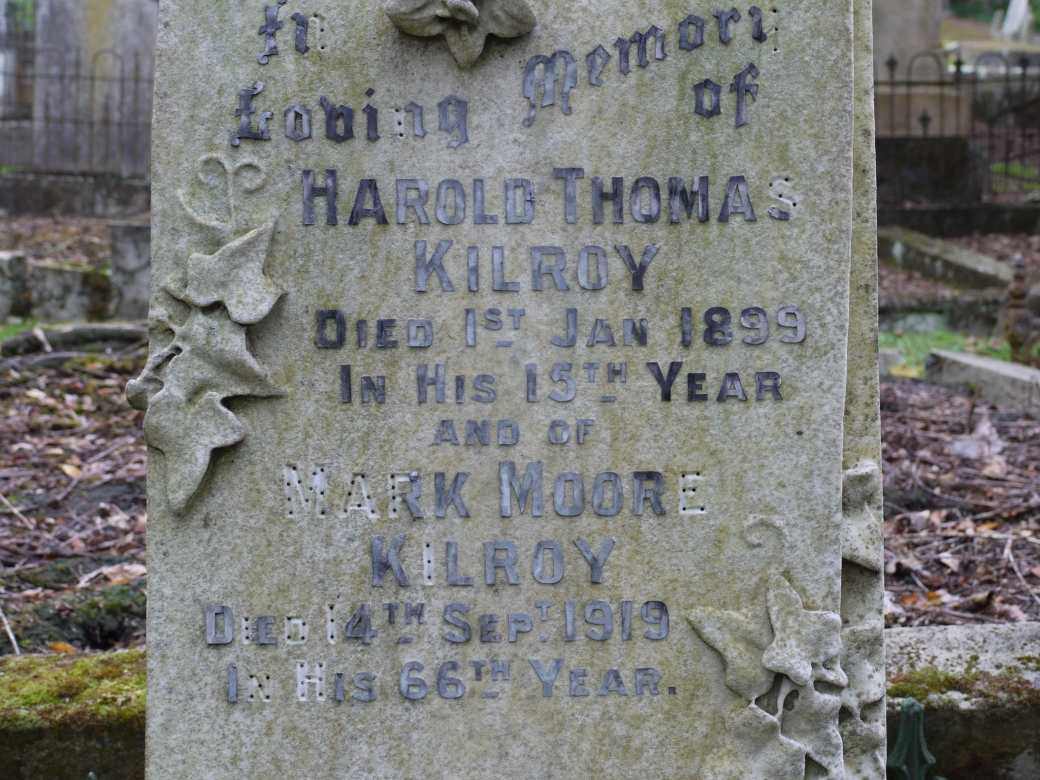 |
|
Gravestone of Harold Thomas Kilroy and
Mark Moore Kilroy in Southern cemetery, Dunedin, New Zealand
|
16 September 1919, in Southern
cemetery, Dunedin, Otago, New Zealand. The grave is in block 12A plot 17.
Henrietta Kilroy
1846
Anthony Kilroy
Catherine (_____) Kilroy
12 April 1867
12 April 1867, in Fort William,
Bengal, India
- India Deaths and Burials
batch B39308-8
- India Deaths and
Burials batch B39308-8
- India Deaths and Burials
batch B39308-8
- India Deaths and Burials
batch B39308-8
Isabella Mabel (Kilroy) Large
4 May 1879, at Ballahanna, Kilnaleck
parish, county Cavan, Ireland
Isabella was born on fourth May 1879 at Ballahanna, the daughter of James
Kilroy, farmer, of Ballahanna, and Maria Kilroy formerly Gibbson.
James Watkin
Kilroy
Maria (Gibson) Kilroy
Robert
Metcalf Large on 28 September 1898 in the parish church, Foyran,
county Westmeath, Ireland
Robert Medcalf Large is recorded as a bachelor, of full age, the son of John
H. Large, gent. farmer. Robert is a gent-farmer, of Rheban Castle, parish of
Athy. Isabel Mabel Kilroy is recorded as a spinster, aged 19 years, the
daughter of James Kilroy, gent farmer. Isabel is resident Derry, parish of
Foyran. The wedding was witnessed by James Kilroy, John H. Large and Henry
S. Large.
Isabel and her husband Robert and
children Louis, John and Sheila Annie, sailed
to Canada on the Lake Manitoba
which departed Liverpool on 21 July 1909, via Belfast, arriving in Quebec on
3 August 1909 onward bound to Montreal. Their destination is listed as
Winnipeg to Robert's brother-in-law (likely Isabel's brother, Percy, who had
earlier emigrated to Canada).
Isabella appears to have used her middle name, Mabel, sometimes shortened to
Mae.
1 September 1964
Canadian Union Messenger 7 October 1964
p363
OBITUARIES
LARGE—Isabel
Mabel Large was born on May 5, 1879, to James and Maria Kilroy, in the
county of Meath, Ireland. She was married to Robert Large, Rheban
Castle, Athy, Ireland, on September 28, 1897, and came with her husband
to Canada in July of 1906. They lived on a homestead in the Rosetown
District until retiring in 1950 when she with her husband made their
home in Saskatoon.
Mrs. Large was a member of the
Seventh-day Adventist Church. Her husband and their three children are
also members. She was baptized in 1926 at camp meeting in Saskatoon. On
the morning of September 1, 1964 she fell asleep in Jesus and awaits the
resurrection when Christ will awake her to everlasting life.
Left to mourn their loss are her
husband; one daughter, Mrs. Foulston of Eyebrow, Saskatchewan; a son,
Louis, of McGee, Saskatchewan; a son, Jack, of Kelowna, B.C.; one
sister, Mrs. Annie Tinkler of Kelowna, B.C.; nine grandchildren and
twelve great-grandchildren.
We are confident that Mrs. Large will
answer to the call of the righteous saints on the great resurrection
morning.
D. R. WATTS
Woodlawn cemetery, Saskatoon,
Saskatchewan, Canada. Isabella is buried in plot 31A-L115-SH.
1898: Derry, Foyran parish, county Westmeath (marriage
record)
1901:
Castlereban North, Churchtown, county Kildare
1916:
Township 29 & 30, Range 16 W 3, Kindersley district, Saskatchewan
Isaiah Kilroy
16 February 1817, in Ballymachugh,
county Cavan, Ireland
Anthony
Kilroy
Elisa (_____)
Kilroy
Isaiah is not listed with his family
in the 1821
census at Turin. Possibly he died young.
- IGI; Worldconnect
- IGI; Worldconnect
James Kilroy
 |
|
Ballymachugh Parish Church
|
1806, in county Cavan, Ireland
Anthony Kilroy
Elisa (_____)
Kilroy
Anne
Moore on 25 February 1834
Farmer
James lived at Turin, Ballymachugh
parish, county Cavan, and then came to Moat View near Oldcastle, county
Meath, about 1869. In a letter in 1926, his son William writes that he was
"of Fortland Co. Cavan". Fortland is another townland in Ballymachugh. In
the same letter in 1926, William notes that all five of his brothers were
dead.
2 April 1880, in Moate, Killeagh,
county Meath, aged 74
Ballymachugh, county Cavan, Ireland
proved 19 October 1880, by George
Porter
Ireland
Calendar of Wills 1880 p380
KILROY
or KILRUY James. 19 October. The Will of James Kilroy late of
Moate County Meath Farmer
deceased who died 2 April 1880 at same place was proved at the Principal
Registry by the oath of George Porter of Oldcastle in said
County Gentleman one of the Executors. Effects
under £800.
1821:
Turin, Ballymachugh, county Cavan
- 1821 census has James
aged 15, indicating birth in 1805/6; from gravestone (aged 74 at death
on 2/4/1880), and a letter from Anthony Kilroy; place from WorldConnect.
The IGI has the birthplace as "Moate, Meath" - Moat is a townland in
Killeagh parish, county Meath, near Castlecor.
- 1821 census
- From birth record of
William - IGI (Film 8718130 Sheet 42); date from note above. The IGI
(AFN: KMQ4-4D) has the marriage date as 15 February 1834.
- From marriage
certificate of daughter Eliza Kilroy researched by Angela Wise
- Ireland Death Index
(2Q1880 Oldcastle vol 3 p313); exact date and place from Ireland
Calendar of Wills 1880 p380
- A note from Kathleen
Kilroy noting Kilroys buried at Ballymachugh
James Kilroy
1818/9
Richard Kilroy
Elizabeth (_____) Kilroy
Sarah Wigelsworth on 23 June 1859,
in St Andrew, Dublin, county Dublin, Ireland.
The marriage was winessed by John Heacock, for the husband, and Thomas
Russell, for the bride. James is listed a bachelor, of full age, of Church
Park, Athleague parish, county Roscommon, the son of Richard Kilroy,
deceased. Sarah is listed as a spinster, of full age, of 49 Dame Street, the
daughter of Joseph Wigelsworth, deceased.
Sarah was born in 1824/5 in Ireland, the daughter of Joseph Wigelsworth and
Anne Martin and was the sister of Catherine Wilhelmina Wigelsworth, who
married James's brother, John, in 1862.
Census:
1881: 2 Cumbria
Villa, St Peter Port, Guernsey, Channel Islands
1821:
Omard, Ballymachugh, county Cavan
1859: Church Park, Athleague, county Roscommon (marriage record)
James Watkin Kilroy
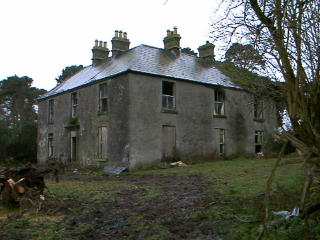 |
|
Derrysheridan House in 2000, before a
recent renovation
|
21 April 1848, in Turin,
Ballymachugh, county Cavan, Ireland
James Kilroy
Anne
Moore
Maria Gibson on 24 April
1877, in the Wesleyan Church, Stephens Green, Dublin, Ireland
Cavan Weekly News 27 April 1877
MARRIAGES.
KILROY
and GIBSON - April 24, in the
Wesleyan Church, Stephens'-green, Dublin, by the Rev. James Nixon,
brother-in-law of the bride, assisted by the Rev. William Gorman, James
Kilroy, Esq., of Ballycan House, Mountnugent, to Maria, third daughter
of James Gibson, Esq., of Craddenstown, county Westmeath.
Maria was born in 1852/3, the third daughter of James Gibson, Esq., of
Craddenstown, county Westmeath. She died on 10 December 1888 in Oldcastle
district, county Meath, aged 35, on the same day that her daughter Maria was
born, so presumably she died in childbirth. Maria is buried in Ballymachugh,
county Cavan.
Elizabeth Mary Armstrong on
24 September 1891, in St Columba, Moybolgue, county Meath, Ireland
James Watkin Kilroy is recorded as a widower, of full age, the son of James
Kilroy, farmer. The groom is a farmer, resident at Derrysheridan, parish of
Foyran. Elizabeth Mary Armstrong is recorded as a spinster, of full age, the
daughter of William Armstrong, farmer. Elizabeth is resident at Moyle,
parish of Moybologue. The wedding was witnessed by Richard Edward Gill and
Ana C. ??? Latimer.
Elizabeth was born in 1853/4, in county Meath, the daughter of William
Armstrong. In 1901, after the death of her husband, Elizabeth is listed as a
farmer in Derrysheridan townland. She died on 15 August 1907 at Ryefield,
Virginia, county Cavan, aged 53, from chronic pneumonia of duration 8 months
leading to cardiac failure of duration 1 week. The informant is her sister,
Matilda Porter, of Ryefield. Elizabeth is buried in Ballymachugh, county
Cavan. Probate of her will was granted on 20 January 1908 to Matilda Porter.
Ireland
Calendar of Wills 1908 p291
KILROY
Elizabeth Mary 20 January Probate of the Will of Elizabeth Mary Kilroy late of
Ryefield House County Cavan
Widow who died 15 August 1907
granted at Cavan to Matilda
Porter Married Woman. Effects £1,610 9s. 0d.
Census & Addresses:
1901:
Derrysheridan, Killeagh, county Meath
1907: Ryefield House, Virginia, county Cavan (Ireland
Calendar of Wills 1908 p291)
Farmer
3 October 1899, at Derrysheridan,
Killeagh parish, county Meath, Ireland, aged 51
James W. Kilroy died on Third October 1899 at Derrysheridan. He is recorded
as a farmer, married and aged 51 years. The informant is Elizabeth Mary
Kilroy, wife, of Derrysheridan.The cause of death is cancer of the spine, of
duration 1 year and abcess of duration 4 months, asthenia.
Ballymachugh, county Cavan, Ireland
granted 21 December 1899, to
Elizabeth M. Kilroy
Ireland
Calendar of Wills 1899 p244
KILROY
James Watkin. 21 December Probate of the Will
of James Watkin Kilroy late of
Derrysheridan Mountnugent County Meath
Farmer who died 3 October 1899
granted at Dublin to Elizabeth
M. Kilroy of Derrysheridan Widow. Effects £1,555 2s.
James Arthur Kilroy
7 February 1878, at Ballyean,
Kilnaleck parish, county Cavan, Ireland
James Arthur was born on Seventh February 1878 at Ballyean, the son of James
W. Kilroy, farmer of Ballyean, and Maria Kilroy formerly Gibson.
James Watkin
Kilroy
Maria (Gibson) Kilroy
Lucy Hannah Hutchinson on 2
September 1908 in Christ Church, Gorey, county Wexford, Ireland
James Arthur Kilroy is recorded as a bachelor, of full age, the son of James
Watkin Kilroy, farmer. James Arthur is a merchant, of High Street,
Tullamore. Lucy Hannah Hutchinson is recorded as a spinster, of full age,
the daughter of Isaac Hutchinson, merchant. Lucy is resident at ???, Gorey.
The wedding was witnessed by Isaac Hutchinson, J. H. Johnston and Anna
Eileen Warren.
Lucy Hannah Hutchinson was born on 7 August 1884, in Gorey, county Wexford,
the daughter of Isaac Hutchinson, merchant of Gorey and Margaret Hutchinson,
formerly Armstrong.
Census:
1901:
Main Street, Gorey, county Wexford
1911:
High Street, Tullamore, Kilbride parish, King's county
Ironmonger, hardware merchant
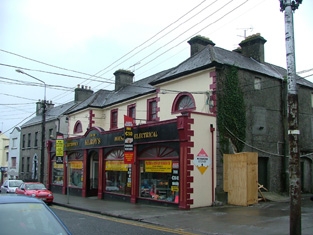 |
|
After more than a century in business,
J.A. Kilroy's store on High Street, Tullamore, county Offaly was
sold in 2016 to be turned into an arts centre.
|
James bought a hardware store in High Street, Tullamore in 1908, and built
"J.A. Kilroy & Sons Ltd" into a large business, well-known in the region
and operated by three generations of the Kilroy family. In 2009, the firm
went through a
restructuring resulting in the loss of 50 jobs at their three stores in
Tulamore, Mullingar and Athlone. That article notes that "For
generations Kilroys was the first choice when it came to purchasing a
variety of goods. While the range of products had been somewhat narrowed in
recent decades, at one time the shop sold motorcycles, petrol, prams,
buckets and general hardware. The Kilroy family took over the business in
1908 from a gentleman called Hannegan." In 2016, the store's building on
High Street, Tullamore, was purchased
by the Offaly County Council for £405,000 to be converted
into an arts centre for the town.
8 March 1960, at Hildon Park Nursing
Home, 62 Terenure Road, Terenure, county Dublin, Ireland, aged 82
James Arthur Kilroy died on Eighth March 1960 at Hildon Park Nursing Home,
62 Terenure Road. He was a retired hardware merchant, married, and aged 82
years. The cause of death was congestive cardiac failure of duration 5 days,
a result of bronchopneumonia of duration 10 days. The informant was ?
Kilroy, grandson, of "Lynwood" Thorncliffe Park, Rathgar, Dublin.
Irish Independent 9 March 1960 p2
Obituary
MR. J. A. KILROY Mr. James Arthur Kilroy, High Street, Tullamore, who has
died aged 82 was a native of Co. Cavan and has lived for over 50 years in
Tullamore where he had established an extensive mail order business. He
took a keen interest in local affairs. He is survived by his wife. Lucy,
and his sons Noel, Frank, Percy, Desmond, Dermot and George.
1901:
West Steet, Drogheda, county Louth
1908: High Street, Tullamore, King's county (marriage
record)
1911:
High Street, Tullamore, Kilbride parish, King's county
1960: Hildon Park Nursing Home, 62 Terenure Road, Terenure, county
Dublin (death
record)
James Kilroy
23 February 1899, in Middleborough,
Plymouth county, Massachusetts, United States
Richard
Thomas
Joseph Kilroy
Bridget A. (Devine) Kilroy
7 November 1899
Jane Kilroy
1809, in Turin, Ballymachugh, county
Cavan, Ireland
Anthony
Kilroy
Elisa (_____)
Kilroy
1821:
Turin, Ballymachugh, county Cavan
- 1821 census lists
"Jaine" as aged 12, indicating birth in 1808 or 1809; IGI has year as
1809, and place as Turin
- 1821 census
John Kilroy
1796, in Turin, Ballymachugh, county
Cavan, Ireland
Anthony
Kilroy
Elisa (_____)
Kilroy
John Kilroy
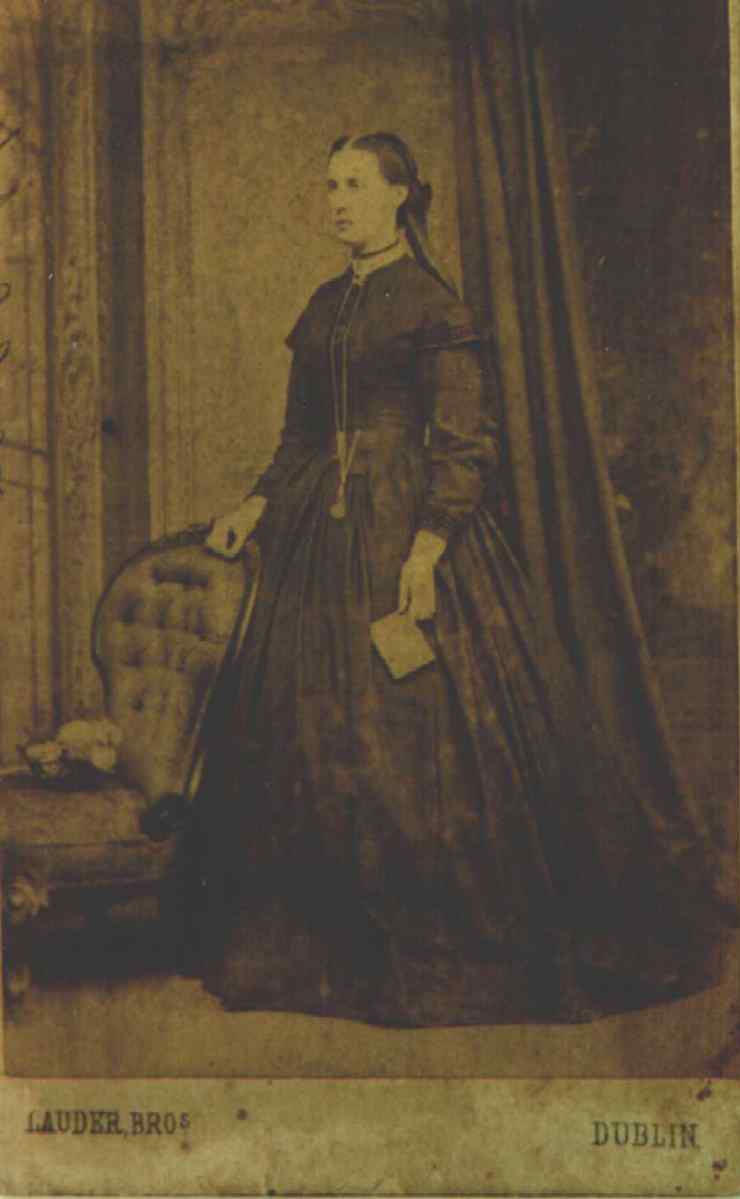 |
|
Catherine Wilhelmina Wigelsworth
photo from Joe Lineberger
|
1819/20
Richard
Kilroy
Elizabeth
(_____) Kilroy
Catherine Wilhelmina Wigelsworth on
19 September 1862, in Dublin North, county Dublin, Ireland
Known as "Kate", Catherine was of Church Park, near Roscommon. She was the
daughter of Joseph Wigelsworth and Anne Martin, and was the sister of Sarah
Wigelsworth, who married John's brother, James in 1859. She also had a
brother, Joseph Wigelsworth (who was born 21 March, 1827 in Church Park, and
died near Clyattville, Lowndes County, Georgia, United States) and two other
sisters: Abigail Wigelsworth, who is listed as a retired farmer, single,
aged 69, living in Tromaun, Athleague, county Roscommon in the 1911
census, and Anne who appears in the 1901 census living in Tromaun with
Abbie, also a single famer.
1821:
Omard, Ballymachugh, county Cavan
- 1821 census
- 1821 census
- Ireland Marriage Index
(1862 Dublin North vol 5 p164); exact date and place from Ireland
Marriages
batch M70226-5; Wigelsworth details from Joe Lineberger and 1911
census
John James Kilroy
12 May 1845, in Ballymachugh, county
Cavan, Ireland
James Kilroy
Anne
Moore
Kathleen remarks that she thinks John
died young.
- IGI (AFN: KMQ4-DR);
place from WorldConnect
- Notes on the Kilroy
family from Kathleen Kilroy
Lancelot Kilroy
8 May 1870, in Sitapur, Oudh, India
: 30 May 1870, in Sitapur, Oudh, West
Bengal, India
Philip Le
Feuvre Kilroy
Louisa Susan (Le Feuvre) Kilroy
Hester Mary A. Dowson.
Hester was born in 1867, in Basford, Nottinghamshire, the daughter of
Benjamin Dowson, a solicitor, and Alice (Greg) Dowson. Hester was a nurse at
the Arthur Road Hospital, Bombay, and the letters extracted in the privately
printed "Bombay during the Plague" describe her voyage to India, her
experiences during the plague of 1897-8, and the death from plague of her
friend Harriett McDougall. Hester's eldest brother, William Enfield Dowson,
was one of the earliest motor car owners in Nottingham and is recreated as
the Will Renshaw in D.H. Lawrence's story "The Overtone" who "drove to all
kinds of unexpected places, in his motor car, bathed where he liked, said
what he liked, did what he liked".
Census:
1871: Ropewal
Rd., Nottingham Castle and Standard Hill, Nottingham, Nottinghamshire
1881: 4 Clumber
Road, Standard Hill, Nottinghamshire
1891: Clumber
Rd., Standard Hill, Nottingham, Nottinghamshire
1911: Salcombe,
Devon
Naval Surgeon, Royal Navy. In
the 1891 census, Lancelot is listed as a medical student. In 1908, Lancelot
is listed
as
the staff surgeon aboard the Brilliant,
attached to the fourth Cruiser Squadron.
1905: An
Inquiry
into the Existence of Typhoid Fever in Bermuda (British Medical Journal 22 April 1905; 1(2312): 878-880 by Lancelot Kilroy
and F.W. Hooper)
On 17 November 1904, Hester and her children Maud and Robert (but not
Alix?), along with Evelyn Roebuck, their nurse and governess, entered the
United States on the Majestic (manifest),
from
Liverpool. Their final destination is given as Bermuda with the intention of
joining Lancelot Kilroy at the Royal Naval Hospital, Bermuda. They are
accompanied by Hester's father, Benjamin Dowson, who gives his occupation as
lawyer and residence as Nottingham. He states his purpose as being to
accompanhy his daughter as far as New York (crossed out and replaced with
Montreal, Canada). Curiously, the same party (Benjamin Dowson, Hester, Maud,
Robert but this time including Alix, appear on the mainfest of the Teutonic
which arrived in New York on 20 October 1904, but their names are all
crossed out. I surmise that perhaps Alix fell ill, the family did not board
the Teutonic, and they then
proceeded on the Majestic a month
later, leaving Alix behind to recover)
On 22 March 1905, Lancelot, his wife Hester and children Maud Winifred and
Robert, and Evelyn Roebuck, returned to the United States aboard the Bermudian (manifest)
sailing from Hamilton, Bermuda. They were en route to London, and they give
their last residence as Bermuda.
In 1934, Lancelot, his brother Willie and F. Wheatley applied for a patent
for "A new or improved
device for holding fish hooks, artificial flies or baits"
1941, in Wokingham
district, Berkshire, England, aged 70
1871: Highfield,
South Stoneham, Hampshire
1881: Junior
School of The United Services College, Westward Ho!, Abbotsham, Devon
1891: North End
Road, Fulham, London
1901, 1904: "The Park", Nottingham, Nottinghamshire (baptism records of
children Maud and Robert)
1905: Bermuda (Ellis Island ship manifest)
1907: Cromwell Street, Nottingham, Nottinghamshire (baptism records of
daughter Mona)
1911: St Clement
Danes, Strand, London
1922: Broughton, near Melton Mowbray, Leicestershire (manifest
of the Canopic)
1934: Barn Elms Farm, Bradfield, Berkshire (patent
application)
Louise Maria Kilroy
7 June 1874, in Freshwater, Isle of
Wight, Hampshire, England
5 July 1874, in Yarmouth, Isle of
Wight, Hampshire, England
Philip Le
Feuvre Kilroy
Louisa Susan (Le Feuvre) Kilroy
1955, in Christchurch
district, Hampshire, England, aged 81
1881: Plymstock,
Devon
1891: 72 Chaucer Road, Bedford St
Paul, Bedfordshire
1901: Aberdeen
Terrace, Lewisham, London
1911: Ryde, Isle
of Wight, Hampshire
Lucy Kilroy
1852, in Ireland
James Kilroy
Anne
Moore
Margaret Anne (Kilroy) Gill
known as "Maggie"
2 Jan 1842, in county Cavan, Ireland
James Kilroy
Anne
Moore
Benjamin
Gill on 13 August 1863, in Ballymachugh, county Cavan, Ireland
Farmer
I believe that there is some
error here with Margaret's children. The 1911 census shows that she only
ever had seven children, all still living in 1911.
18 September 1920, at Cloney Grange,
Athboy, county Meath, Ireland, aged 80. The cause of death is listed as
acute bronchitis of duration 1 month and pulmonary congestion for 7 days.
21 September 1920, in Killaconnigan
cemetery, Ballivor, Killaconnigan, county Meath, Ireland
1901:
Clonygrange, Killaconnigan, county Meath
1911:
Clonygrange, Killaconnigan, county Meath
Maria (Kilroy) Maxwell
1810/1, in Ireland
Richard Kilroy
Elizabeth (_____) Kilroy
Henry
Maxwell on 23 June 1831, in the presence of her brother, Anthony.
9 February 1891, at 404 Garden
Street, Hoboken, New Jersey, United States, aged 80
The New York Herald 10 February 1891
DIED.
MAXWELL. - At her residence, No. 404 Garden st., Hoboken, on
Monday, February 9, 1891, MARIA, widow of Henry Maxwell,
formerly of Crover, county Cavan, Ireland, and daughter of the late
Richard Kilroy, Esq., of Omard House, same county, Ireland, in the 81st
year of her age.
The relatives and friends of the family are invited to attend her
funeral, on Thursday, February 12, at two P. M., from St. Paul's Church,
Hoboken, N. J. Please omit flowers.
1821:
Omard, Ballymachugh, county Cavan
1860: Hoboken, Hudson county, New Jersey: Maria Maxwell is aged 48, born in
Ireland (film 803693 p64 family 497)
1870:
Hoboken,
Hudson county, New Jersey
1885: Hoboken, Hudson county, New Jersey: Maria Maxwell is aged over 60.
1891: 404 Garden Street, Hoboken, New Jersey (The New York Herald 10 February 1891)
Maria Kilroy
1836/7, in Stoke Damerel, Devon,
England
Alexander
Kilroy
Maria Lucinda (Fry) Kilroy
21 June 1911, in Tetbury
district, Gloucestershire, England, aged 75
1841: Charlotte
Terrace, Stoke Damerel, Devon
1851: Alfred
Place, St Andrew, Devon
1871: Kensington,
London, Middlesex
1881:
122
Edith Road, London, Middlesex
1891: North End
Road, Fulham, London
1901: Buckingham
Road, Ryde, Isle of Wight
1911: Tetbury district, Gloucestershire: Maria Kilroy is aged 73
1911: Leighterton Rectory, near Tetbury, Gloucestershire (London Gazette 1 September 1911 p6500)
which also notes that she was "formerly of Omard, Harrow, Weald, Middlesex"
Maria Gibson (Kilroy) Marshall
10 December 1888, at Derrysheridan,
Killeagh parish, county Meath, Ireland
Maria was born on Tenth December 1888 at Derry Sheridan, the daughter of
James W. Kilroy, gentleman, of Derry Sheridan, and Maria Kilroy formerly
Gibson.
Maria's mother died on 10 December 1888, the day of Maria's birth,
presumably in childbirth.
James Watkin
Kilroy
Maria (Gibson) Kilroy
Thomas
M. Marshall on 30 September 1913 in St. Matthew's church, Winnipeg,
Manitoba, Canada
The Winnipeg Tribune 27 September 1913 p6
Church Felicitates.—A number of young people of St. Matthew's
church, Mrs. McElheran, and also some personal friends of Miss Myra
Gibson Kilroy (numbering about 100) met in the basement of the new
church on Thursday evening, and presented her with a shower of presents
on the occasion of her marriage on Oct. 30 to the Rev. Thomas Marshall,
vicar of St. Thomas' church, Weston. J. S. Spence, as chairman, paid a
high tribute to the excellent work which Miss Kilroy had been doing in
Sunday school, and Mr. Hargreaves referred to her successful efforts in
other directions of the work of the church. Mrs. Kilroy, who is a native
of Ireland, came to Winnipeg some years ago, when she early associated
herself with St. Matthew's church.
The Winnipeg Tribune 1 October 1913 p7
MARSHALL—KILROY
A pretty wedding took place at 3 o'clock yesterday afternoon in
St. Matthew's church, when Miss Myra Kilroy was joined in holy matrimony
to Rev. T. Marshall, rector of St. Thomas church. Rev. R. D. McEtheran
officiated. The bride, who was given away by her brother, wore a gown of
white crepe de chine with a Limerick lace veil and carried a shower
bouquet of lilies; Miss Sybil Mastell was bridesmaid, and was gowned in
pale pink charmeuse. Rev. Mr. Morris, rector of St. Alban's, acted as
best man.
After the ceremony a reception was held at the residence of Rev.
R. D. McElheran, 158 Maryland street.
Maria used the name Myra. She emigrated
to Canada on the Lake Manitoba
with her sister, Isabel Mabel Large, in 1909, aged 20. Her destination is
listed as Winnipeg, Manitoba and her occupation is shop assistant.
18 December 1956, at 4323 Coronation
Drive, Calgary, Alberta, Canada, aged 68
The Winnipeg Evening Tribune 20 December 1956
p27
MARSHALL — On
December 18, 1956 at the residence of her daughter, Mrs Basil Mainman,
4323 Coronation Drive, Calgary, Alberta, Mrs. Myra Gibson Marshall, aged
68 years, widow of the Rev. Thomas Marshall, formerly of Winnipeg.
Funeral service 2.15 p.m. Friday in St. Andrew's Anglican Church,
Woodhaven and Portage Ave. Interment in Chapel Lawn Memorial Gardens.
Arrangements by the Clark Leatherdale Funeral Home, Ph. 93-5494
The Winnipeg Evening Tribune 20 December 1956
p31
MRS THOMAS MARSHALL
Mrs. Myra Gibson Marshall, 68, formerly of Winnipeg, died Tuesday
at the home of her daughter, Mrs. Basil Mainman, 4323 Coronation Drive,
Calgary, Alta.
Mrs. Marshall was born in Ireland and came to Winnipeg in 1909.
She was the widow of Rev. Thomas Marshall.
She is survived by a son, Hedley; a daughter, Mrs. Basil Mainman;
two brothers, Percy and Arthur Kilroy; two sisters, Mrs. K. Large and
Mrs. A. Tinkler; five grandchildren.
Funeral service will be held at 2.15 p.m. Friday in St. Andrew's
Anglican Church, Dean J. Burton Thomas officiating, assisted by Rev. A.
Wilcox. Burial will be in Chapel Lawn Memorial Gardens. Clark
Leatherdale Funeral Home is in charge of arrangements.
21 December 1956, in Chapel Lawn
Memorial Gardens, Winnipeg, Manitoba, Canada
1901:
Derrysheridan, Killeagh, county Meath
1916:
1458 Ross Avenue, Winnipeg, Manitoba
1917: 1458 Ross Avenue, Winnipeg, Manitoba (attestation
papers of brother Percy)
Mark Anthony Kilroy
1841/2, in Ireland
Anthony
Kilroy
Catherine (_____) Kilroy
Army Surgeon. Mark was
registered as a doctor on 5 March 1866. His qualifications at the time are
given as "Mem. R. Coll. Surg. Eng. 1865. Lic. K. Q. Coll. Phys. Irel. 1865."
Mark became Staff Assistant-Surgeon on 1 April 1867. Hart's
Army
list for 1870 shows him as an assistant-surgeon with the rank of
lieutenant, stationed in the West Indies and the 1871
and 1872
lists show him with the same rank now stationed in Chatham, Kent. The 1873
list shows Mark still an assistant-surgeon with the rank of
lieutenant, now stationed in Bengal. Mark retired on 4 November 1873, with
the rank of surgeon. This retirement, after only 6 years, was likely a
result of illness, and Mark died the following year.
1874, in Croydon
district, Surrey, England, aged 32
1865: 10 Upper Gloucester Street, Dublin (admission
to
King and Queen's College of Physicians in Ireland)
1866: Ogmard, Virginia, county Cavan (The Medical Register (1878) p278)
1871: Chatham,
Kent
Mark Moore Kilroy
19 March 1854, in Ballymachugh,
county Cavan, Ireland
James Kilroy
Anne
Moore
Mary Ellen Moore in 1880 in New
Zealand
Mary was the daughter of Thomas Charles Moore and Ellen Dunbar. She was born
in 1857/8 in Limerick, Ireland. In her husband's obituary (Evening Star 15 September 1919 p6) it is
stated that Mark came out to New Zealand 40 years prior (i.e. 1878/9), and
that Mary Ellen, his fiancee, came out a year later. Likely she is the Miss
Moore who arrived on the Arawata on
4 October 1880, from Melbourne, bound for Dunedin, in the company of a Miss
Kilroy (Press 5 October 1880 p2).
Mary Ellen's youngest son, Albert Brian, was "almost blind all his life; his
Mother read his books to him for study in NZ." (Register
of New Zealand Presbyterian Church Ministers, Deaconesses &
Missionaries from 1840 p174). In 1920 Mary Ellen accompanied
Brian to England during his period of study at Westminster College,
Cambridge from 1920 until 1922. They sailed
on the Arawa
for Southampton and London on 31 July 1920. Before leaving she put
many of her household goods up for auction and the description gives a
glimpse into her lifestyle:
Evening Star 17 July 1920 p9
TUESDAY, 20th JULY,
At 2 o'clock.
On the Premises, No. 5 Neidpath road (off Eglinton
road).
Instructed by Mrs M. M. Kilroy (who is leaving for England).
SUPERIOR HOUSEHOLD FURNITURE.
RICH AXMINSTER CARPET, WALNUT AND TAPESTRY SUITE (9 Pieces), MAHOGANY
EXTENDING DINING TABLE, SADDLEBAG CHESTERFIELD SETTEE, MAHOGANY BOOKCASE
AND CHIFFONIER. PEDESTAL WRITING DESK, LARGE RED PINE PEDESTAL DUCHESSE
PAIR, LARGE MIRROR-DOOR WARDROBE WALNUT OVERMANTEL.
ALEX. HARRIS AND CO have received instructions to sell by auction,
Household Furniture, including?Rich Axminster carpet, mahogany
bookcase and chiffonier, walnut and tapestry suite, leather couch,
pedestal writing desk, opossum rug, vases and ornaments, dinner service
(84 pieces), red pine hall stand, fenders and irons, rattan chairs,
wicker chairs, 4 fur hearthrugs, spring rockers, bamboo tables, tapestry
settee, seagrass rocker, mahogany extending dining table, wall mirrors,
photogravures and pictures, folding chairs, 1½ pairs heavy tapestry
curtains, portiere curtain and rods, walnut overmantel, saddlebag
Chesterfield settee, marble timepiece, velvet pile table cover, 6
leather dining chairs, coal vases, linoleum, Austrian chairs, crockery,
folding bed chair and cushion, double and single iron bedsteads, wire
mattresses, kapok and flock mattresses, blankets, handsome red pine
duchess pair, large duchesse chest, toiletware, 2 sewing machines, large
mirror-door wardrobe, blankets, kitchen table, kitchen utensils, tool
chest and tools, quantity garden tools, grindstone.
Mary Ellen returned to New Zealand with Brian aboard
the Athenic from
Southampton, arriving in Wellington on 10 August 1922, onward bound for Port
Chalmers (near Duedin). She continued to assist Brian, and is recognized for
her efforts both when Brian left his first appointmnt at Riccarton for
Oamaru ("A tribute was also paid to Mrs Kilroy, his mother, for her interest
and work in the cause of the Church." (Press 11 August 1928 p5) and when he left
Oamaru for Wellington "the congregational farewell social tendered to the
Rev. Brian and Mrs. Kilroy and Mrs. Kilroy, sen" (Evening Post 18 October 1934 p5).
Mary Ellen died on 1 June 1936 in Wellington, New Zealand, aged 80. Her last
address was 19 Bolton Street, Wellington. Mary Ellen was cremated on 3 June
1938 in Wellington crematorium and her ashes buried in Southern cemetery,
Dunedin, block 12A plot 17.
Dunedin
Probate and Letters of Administration Files 1919-P6593
THIS IS THE
LAST WILL AND TESTAMENT of me MARY ELLEN KILROY of Dunedin in the
Provincial District of Otago and Dominion of New Zealand Widow.
1. I REVOKE all wills and testamentary dispositions heretofore
made by me and declare this to be my last will and testament.
2. I APPOINT my sons REGINALD JAMES KILROY of Dunedin aforesaid
Draper and ALBERT BRIAN KILROY of Wellington in the Provincial District
of Wellington and Dominion aforesaid Presbyterian Minister (hereinafter
referred to as "my Trustees") TRUSTEES AND EXECUTORS of this my Will.
3. I DESIRE that my body may be cremated.
4. I GIVE DEVISE AND BEQUEATH to the said ALBERT BRIAN KILROY
absolutely all my household furniture and effects and all articles of
personal domestic or household use or ornament belonging to me at the
date of my death
5. I GIVE DEVISE AND BEQUEATH the whole of my real property and
the residue of my personal property whatsoever and wheresoever situate
unto my Trustees UPON TRUST that they shall sell call in collect and
convert into money the same or such part or parts thereof as shall not
already consist of money at such time or times and in such manner as my
Trustees shall think fit but so that they shall have the fullest power
and direction to postpone such sale calling in collection and conversion
during such period or periods as they shall think proper and to retain
the same in its present form of investment without being responsible for
loss.
6. I DIRECT my Trustees to pay my just debts and my funeral and
testamentary expenses adn the duty (if any) on my estate out of the
proceeds of such sale calling in collection and conversion or out of my
ready moneys of which I shall die possessed and to pay the sum of Five
hundred pounds (free of all duties) to each of my grandchildren ANNETTE
KILROY MARY ELLEN KILROY and REGINALD THOMAS KILROY (all children
of the said Reginald James Kilroy) if and when they shall respectively
attain the age of twentyone years.
7. AFTER payment thereout of my just debts funeral and testamentary
expenses duty and the legacies mentioned in Paragraph 6 of this my Will
I DIRECT my trustees to stand possessed of the balance of such proceeds
and ready moneys as aforesaid (hereinafter referred to as "my residuary
estate") UPON the trusts hereinafter mentioned that is to say:-
(a) To pay one-third thereof to my son the said REGINALD JAMES
KILROY
(b) To pay one-third thereof to my son the said ALBERT BRIAN
KILROY
(c) To invest the remaining third thereof in any of the
investments authorised by the laws for the time being in force in New
Zealand relating to the investment of trust funds and to pay the income
arising therefrom to my son WILLIAM ERNEST KILROY during his lifetime
and after his death to stand possessed of the said investments both as
to capital and income UPON TRUST for my sons the said REGINALD JAMES
KILROY and ALBERT BRIAN KILROY in equal shares.
8. In the event of any of them my grandchildren the said Annette Kilroy
Mary Ellen Kilroy and Reginald Thomas Kilroy predeceasing me on
surviving me but dying before attaining the age of twentyone years I
DIRECT that the sum hereinbefore directed to be paid to such grandchild
on her or his attaining the age of twentyone years shall fall into and
form part of my residuary estate and shall devolve accordingly.
9. In the event of either of them my sons the said Reginald James Kilroy
and Albert Brian Kilroy predeceasing me or surviving me but predeceasing
the said William Ernest Kilroy leaving issue him or them surviving I
DECLARE that such issue on attaining the age of twentyone years shall
take and if more than one in equal shares the share or shares under this
my will which his her or their parent would have taken had he survived
me and the said William Ernest Kilroy.
10. In the event of either of them my sons the said Reginald James
Kilroy or Albert Brian Kilroy predeceasing me or surviving me but
predeceasing the said William Ernest Kilroy without leaving issue him
surviving or leaving issue none of whom shall attain the age of
twentyone years then and in any such cases I DIRECT that the share or
shares under this my will of the son so dying shall vest in and belong
to the survivor of my sons the said Reginald James Kilroy and Albert
Brian Kilroy.
11. I AUTHORISE AND EMPOWER my Trustees to invest in their own names the
prospective share under this my will of any of the grandchildren pending
his or her respectively attaining the age of twentyone years in any of
the investments hereinbefore authorised.
12. I FURTHER AUTHORISE my Trustees at their discretion to pay or apply
the whole or any part of the capital or the income of the prospective
share under this my will of any of my grandchildren pending his or her
respectively attaining the age of twentyone years in or towards his ir
her maintenance education advancement or benefit with power to pay the
same to the guardian or guardians of such grandchildren without seeing
to the application thereof and to invest any surplus income in any of
the investments hereinbefore authorised in augmentation of capital.
13. I LASTLY DECLARE that notwithstanding the trusts hereinbefore
declared in Paragraph 7 sub-paragraph (c) of this my will in favour of
the said Reginald James Kilroy and Albert Brian Kilroy it shall be
lawful for my Trustees at their discretion to raise any sum or sums out
of the capital of the share in my residuary estate the income from which
I have directed to be paid to the said William Ernst Kilroy and to pay
or apply such sum or sums to the said William Ernest Kilroy and to pay
or apply such sums to the said William Ernest Kilroy for his benefit in
addition to the said income.
IN WITNESS WHEREOF I have hereunto subscribed my name this
twelfth day of January One thousand nine hundred and thirtyeight.
SIGNED AND ACKNOWLEDGED by the said MARY ELLEN KILROY the Tesatrix as
and for her last Will and Testament in the presence of us both present
at the same time who at her request in her presence and in the presence
of each other have hereunto subscribed our names as witnesses:-
M. Lousley Solicitor Dunedin
CODICIL to Will of MARY ELLEN KILROY
I MARY ELLEN KILROY of Dunedin in the Provincial District of Otago
and Dominion of New Zealand Widow DECLARE this to be a first codicil to
my will which bears date the Twelfth day of January One thousand nine
hundred and thirtyeight WHEREAS since the execution of my said Will I
have purchased a "Times" Newspaper Run in Dunedin aforesaid for the sum
of Two hundred pounds which Paper Run is being operated and worked by my
son WILLIAM ERNEST KILROY AND WHEREAS I have also advanced to the said
William Ernest Kilroy the sum of THIRTYONE POUNDS THIRTEEN SHILLINGS AND
FOURPENCE as a deposit on the purchase by him of a Motor Car to enable
him to operate and work the said Paper Run more conveniently.
1. NOW I HEREBY GIVE AND BEQUEATH to the said WILLIAM ERNEST
KILROY the said Paper Run and the goodwill thereof and all plant and
stock-in-trade employed or used in carrying on the same and all
book-debts owing in respect of the said business and the benefit of all
contracts relating thereto SUBJECT HOWEVER AND CHARGED WITH the payment
by the said William Ernest Kilroy of all moneys paid by me for or in
respect of the said business and with all monies already advanced or
which may hereafter be advanced by me to the said William Ernest Kilroy
in respect of his operation or working of the said business or in
respect of the Motor Car purchased by him and all legal costs incurred
by me in respect of the said business
2. In all other respects I confirm my said Will.
IN WITNESS WHEREOF I have hereunto subscribed my name
this day of April 29th One thousand nine hundred and thirtyeight.
SIGNED AND ACKNOWLEDGED by the said MARY ELLEN KILROY as a Codicil to
her Will which bears the date the Twelfth day of January One thousand
nine hundred and thirtyeight in the presence of us both present at the
same time who at her request in her presence and in the presence of each
other have hereunto subscribed our names as witnesses:-
E E Westrup, Home duties 2 Shannon St Clifton E1
D. A. Ironside, Radio Mechanic of May St, Wellington
Draper
In Ireland, Mark was apprenticed to the drapery business under Thomas C.
Moore, part owner of the great Limerick warehouse, whose daughter
subsequently became his wife. After emigrating to New Zealand around 1879,
he found employment with the firm of Brown, Ewing, of Dunedin. In 1900,
Mark, then manager of a department in Brown, Ewing?s, founded the drapery
firm of Kilroy and Sutherland, in association with Mr Robert Sutherland.
The Otago Witness 5 April 1905 p27 mentions a
theft from Mark's shop:
A third information was here prepared and put in, charging Osborne with
having, in December last, broken and entered the shop of Mark Moore Kilroy
and stolen therefrom seven silk handkerchiefs, valued at £1 6s 3d.
Otago Daily Times 16 August 1912 p6
DISSOLUTION OF
PARTNERSHIP
NOTICE IS HEREBY GIVEN that the
Partnership heretofore existing between the Undersigned, MARK MOORE
KILROY and ROBERT DUNNET SUTHERLAND, as Drapers at Numbers 192 to 200
Princes street, Dunedin. under the style of "KILROY & SUTHERLAND,"
has been this day Dissolved by mutual consent. Any Outstanding Debts
should be paid to the said Mark Moore Kilroy, by whom the Business will
be carried on under the same style as before, and who will Discharge all
the Liabilities of the former partnership.
Dated at Dunedin this first day of August, One Thousand Nine
Hundred and Twelve.
MARK MOORE KILROY.
ROBERT DUNNET SUTHERLAND.
Witness to both Signatures:
EDMUND J. SMITH,
Solicitor, Dunedin
Mark emigrated to New Zealand in
about 1879. He and his family returned to England for a visit in 1913.
Otago Daily Times 12 February 1913 p8
Before leaving for an extended holiday in Great Britain, Mr and Mrs M.
M. Kilroy and their son wore entertained at tea at the Dominion Tea
Rooms on Monday evening by the staff of Kilroy and Sutherland. Members
of the staff to the number of 34 assembled. During the evening Mr S.
Lawn expressed the sentiments of the gathering towards the voyagers by
wishing them a pleasant journey, an enjoyable stay, and a safe return;
and, on behalf of the staff, presented Mr Kilroy with a Kaiapoi rug. Mr
Kilroy briefly and feelingly thanked those present for their kind wishes
toward himself and his family and for the rug, which he would prize
highly.
The Dominion 3 June 1913 p5 (Wellington,
New Zealand)
Mr. and Mrs. M. M. Kilroy, of Dunedin, and their son arrived in England a
fortnight ago, and intend to stay till next October. They will stay at
Verwood, with Dr. Moore, Mrs. Kilroy's brother, and then in Ireland with
Mr. Kilroy's people in County Meath..
Otago Daily Times 10 November 1913 p3
PROSPEROUS BRITAIN
A RETURNED TRAVELLER.
CHAT WITH MR M. M. KILROY.
Mr M. M. Kilroy, of the firm of Kilroy and Sutherland, who with
Mrs Kilroy, and Mr Brian Kilroy, left Dunedin last February on a visit
to the Old Land, returned again to this city last Thursday. During his
absence Mr Kilroy travelled extensively both in England, Ireland, and
Scotland, and was a keen and interested observer of commercial and
industrial developments in these lands, which he had not visited for 30
years.
Mr Kilroy has come back strongly impressed with the sound
prosperity of England, and could find no ground for the pessimistic
predictions sometimes made about her decadence. On the contrary, he
found her factories running full time and, he told a reporter, so busily
employed that it was often very difficult to get an order executed. Mr
Kilroy considers the British leaders in business to be quite up to date
and wide awake in their methods, and says that they compel the respect
and admiration even of their American rivals.
When questioned on the subject of Home Rule, Mr Kilroy said that
personally he thought the subject was largely a political one.
Undoubtedly Ireland had never been so prosperous or so contented as she
was at tho present moment, and in his travels there he had been unable
to discover any desire for a change. The people were getting splendid
prices for their produce, and the deposits in the Irish savings banks
were abnormal. An illustration of the prices prevailing was afforded by
the fact that Mr Kilroy's nephew, with whom he was staying, disposed of
26 bullocks for £24 each, and of 100 sheep of an ordinary cross at no
less than £3 5s per head. These, he added, were not stall fed, but were
just taken off the grass. A system which was having excellent results
among the agricultural labouring classes was the compulsory purchase of
single acres from farmers and landowners and the erection on each of
these thousands of allotments of four or five-roomed cottages, with
slate roofs, at a contract price of £300. These were let to agricultural
labourers at from 1s to 1s 6d a week?cottages for which the weekly rent
in Dunedin would be quite 15s. The Government also encouraged the
labourers to take a pride in their sections by giving annual prizes for
the best kept gardens in each county. The old Irish log cabin and the
pig were now only a memory of the past. Mr Kilroy was much impressed
with Belfast, a city of 375,000 inhabitants, and spoke enthusiastically
of its magnificent town hall, and of Messrs Harland and Wolff's vast
ship-building yards, which he had the. privilege of visiting. While in
the neighbourhood he enjoyed a few days' grouse shooting, in the hills
of Antrim. He thoroughly believes in the determination of the people of
Ulster, and does not doubt that they will use the arms they are now
preparing if they are forced to do so. The Ulstermen have good reason to
believe that they have many sympathisers among the British regular
troops, and this, no doubt, strengthens them in their attitude.
Mr Kilroy found London still growing enormously. To his mind the
London policeman is a marvel, and his control over the traffic simply
phenomenal. He was a witness of the amusing, but always impressive sight
of the whole of the Strand traffic held up while a policeman led two
little tots of two and four years of age across the thoroughfare. The
metropolitan policeman he found very tactful and obliging, and a perfect
encyclopædia of information. In the House of Commons Mr Kilroy heard Mr
Lloyd George, Mr A. Bonar Law, Sir John Simon, the Solicitor-general,
and other less widely known politicians. He was not greatly impressed
with their speaking, and said that personally he did not think that any
of them could equal the late Mr Scobie Mackenzie. Mr Lloyd George was
making a debating speech, and was more forcible than eloquent. London
has been transformed by the twopenny tubes and the motor buses. Horse
traffic is gradually dying out, and the motor conveyances have been
brought to such perfection that they are entering into competition with
the railways over distances extending 200 miles from London. Almost the
only unfavourable criticism Mr Kilroy had to make was directed against
the railway management. The Home trains he had found to be frequently
unpunctual, and often very far behind time-table time. He mentioned a
curious side effect of the Balkan war that had come under his notice.
Kid gloves were extremely scarce and difficult to purchase just now,
largely owing to the fact that the cultivation of kids in the Balkan
States had been much neglected of late, and many of the animals have
been shot or otherwise destroyed.
Mr Kilroy both went and returned by the Suez route, and owned to
feeling a certain satisfaction in seeing the British flag flying at
almost every port. On the return journey he paid a brief visit to
Queensland, and was much impressed with the possibilities of that State,
which, as he points out, is five times the size of England. The dairying
industry he found to be making immense strides in Queensland and along
all the railway routes could bo seen smiling homesteads and the
evidences of great activity in building and settlement. "If the
Australasian colonies are properly advertised, the future is theirs,"
said Mr Kilroy, "I believe that during the next 10 or 12 years the
emigration to them will greatly increase."
14 September 1919, aged 65, at his
residence, 5 Neidpath Road, Mornington, Dunedin, Otago, New Zealand
Otago Daily Times 15 September 1919 p4
DEATHS.
KILROY.?On September 14, 1919, at his residence, 5 Neidpath road,
Mornington, Mark Moore, the beloved husband of Mary Ellen Kilroy.
Private interment?Frapwell and Holgate, undertakers.
Evening Star 15 September 1919 p6
OBITUARY
MR M. M. KILROY.
Mr Mark Moore Kilroy, senior partner in
the drapery firm of Kilroy and Sutherland, died at his residence,
Mornington, yesterday, aged 65 years. Though he took no active part in
public affairs, Mr Kilroy was one of those men of sterling worth whose
characters make impact upon their generation. He was a zealous adherent
of the Presbyterian Church, an elder at St. Andrew's. This office and
his long vice-presidency of the Dunedin Cricket Club, represented his
nearest approach to public life. He was also one of the original
shareholders in the Kaltuna green, though he never took part in the
game, his chosen recreation being chess, and one of the keenest players
at the Athenaeum. Mr Kilroy was bom in County Cavan, and apprenticed to
the drapery business under Mr Moore, part owner of the great Limerick
warehouse, whose daughter subsequently became his wife. At one stage of
his career the deceased gentleman had serious intentions of taking
orders in the Church of Ireland, and actually commenced his studies; but
he soon returned to his earlier choice, and landing in New Zealand 40
years ago, he found employment with the firm of Brown, Ewing, of this
City. His fiancee, Mis Mary Ellen Moore (County Clare) came out a year
later, and the marriage took place here. In 1900 Mr Kilroy, then manager
of a department in Brown, Ewing?s, founded the present firm of Kilroy
and Sutherland, in association with Mr Robert Sutherland. He is survived
by his wife and three sons?Mr R. J. Kilroy, of the firm; Mr W. E.
Kilroy, Auckland; and Mr A. B. Kilroy, M.A., a student at Knox College.
 |
|
Gravestone of Harold Thomas Kilroy and
Mark Moore Kilroy in Southern cemetery, Dunedin, New Zealand
|
16 September 1919, in Southern
cemetery, Dunedin, Otago, New Zealand. The grave is in block 12A plot 17.
Dunedin
Probate and Letters of Administration Files 1919-P6593
THIS IS
THE LAST WILL AND TESTAMENT of me MARK MOORE KILROY of Dunedin in the
Dominion of New Zealand Draper I HEREBY REVOKE all Wills codicils
and other testamentary dispositions heretofore made by me and declare
this to be my last Will and Testament I GIVE DEVISE AND BEQUEATH all the
property of whatsoever nature and wheresoever situated whether real or
personal vested or contingent in possession or remainder of or to which
I shall die possessed or entitled to my wife Mary Ellen Kilroy for her
own use absolutely AND I appoint my said wife sole executrix of this my
Will IN WITNESS I have hereunto signed my name this fourteenth day of
February One thousand nine hundred and thirteen.
Mark Moore Kilroy
SIGNED and acknowledged by the above named testator as and for his last
Will and testament in the presence of us both present at the same time
who at his request in his sight and presence and in the sight and
presence of each other have hereunto subscribed our names as witnesses.
E. F. Hadfield, Solicitor, Wellington
R. E. Greenwood, Law Clerk, Wellington
granted 24 October 1919, to Mary
Ellen Kilroy
Dunedin
Probate and Letters of Administration Files 1919-P6593
IN THE SUPREME
COURT OF NEW ZEALAND
OTAGO AND SOUTHLAND DISTRICT
IN THE ESTATE of MARK MOORE KILROY late of Dunedin in the
Provincial District of Otago and Dominion of New Zealand Draper deceased
I, MARY ELLEN KILROY of Dunedin in the Provincial District of
Otago and Dominion of New Zealand Widow make oath and say as follows:-
1. That I knew Mark Moore Kilroy of Dunedin aforesaid Draper now
deceased when alive and that the said Mark Moore Kilroy was domiciled at
Dunedin aforesaid within this Judicial district and that the nearest
Registry Office of the Court to the place where the said Mark Moore
Kilroy resided or was domiciled is at Dunedin aforesaid.
2. That the said Mark Moore Kilroy died at Dunedin aforesaid on or about
the Fourteenth day of September 1919 as I am able to depose from having
seen him die.
3. That I believe the partly written and partly typewritten document now
produced and marked "A" bearing date the Fourteenth day of February 1913
to be the last will and testament of the said deceased and that I am the
Sole Executrix therein named.
4. That I will faithfully execute the said Will by paying the debts and
legacies of the said deceased so far as the property will extend
and the law binds.
5. That according to my knowledge and belief the estate and effects of
the said deceased in respect of which Probate is sought to be obtained
are under the value of £10500
6. That the said Mark Moore Kilroy deceased was born at Ballymachugh,
County Cavan, Ireland and was a British Subject and at no time was he
ever a subject of any other state or sovereign.
7. That I was born at Limerick in Ireland aforesaid and am a British
Subject and at no time have I ever been a subject of any other state or
sovereign.
SWORN at Dunedin aforesaid this second say of October 1919 Mary
Ellen Kilroy Before me: John
Dawson A SOLICITOR OF THE SUPREME COURT OF NEW ZEALAND
1883: Neidpath Road, Mornington, Dunedin, Otago (Stone's commercial, municipal and general directory of
Dunedin 1883 p104)
1915: 5 Neidpath Road, Dunedin, Otago (New Zealand Times 6 September 1915 p7)
1919: 5 Neidpath Road, Mornington, Dunedin, Otago
Mary Kilroy
1800, in Turin, Ballymachugh, county
Cavan, Ireland
Anthony
Kilroy
Elisa (_____)
Kilroy
1821:
Turin, Ballymachugh, county Cavan
- 1821 census lists Mary
as aged 21, indicating birth in 1799 or 1800; IGI has year as 1800, and
place as Turin
- 1821 census
Mary Jane (Kilroy, Hannon) Lowry
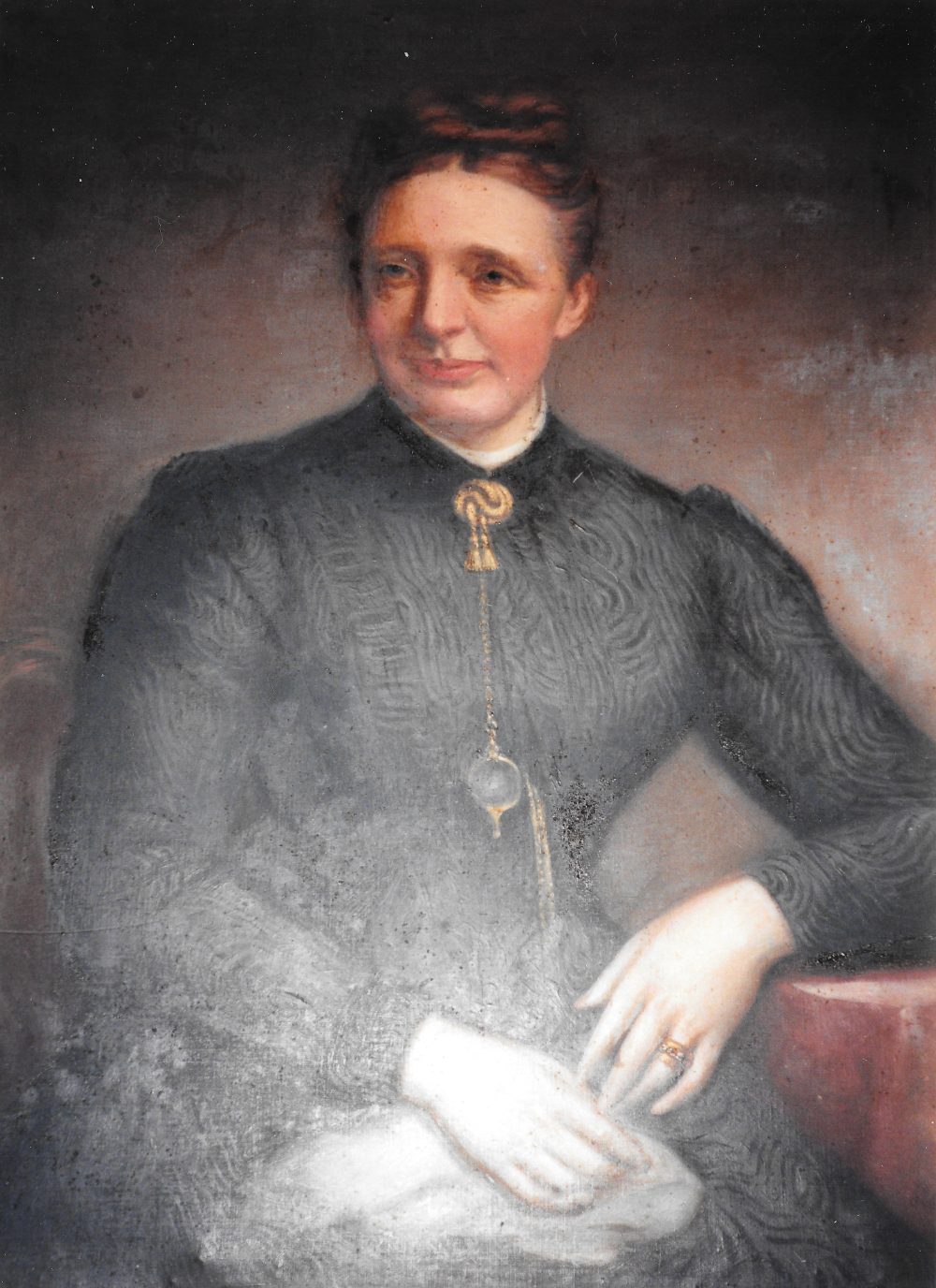 |
|
Portrait of Mary Jane (Kilroy, Hannon)
Lowry hanging in Bachelors Lodge, Kells, county Meath
photo from Andrew Aitkens
|
7 January 1835, in Turin,
Ballymachugh parish, county Cavan, Ireland
James Kilroy
Anne
Moore
Thomas
Hannon on 13 September 1855, in Turin, Ballymachugh, county Cavan,
Ireland
Joseph
Lowry on 19 February 1861, in St Thomas, Dublin, county Dublin,
Ireland. The marriage was witnessed by Joseph Trevor and James Trevor.
Joseph is recorded as a bachelor, a minor, of 97 Amicus Street, a commercial
traveller, the son of John Lowry, a farmer. Mary Jane Hannon is recorded as
a widow, of full age, of 1 Upper Derrel Street, the daughter of James
Kilroy.
The 1911 census notes that this marriage had 10 children of whom 6 were
living in 1911.
1913, in Navan district, county
Meath, Ireland
1861: 1 Upper Derrel Street; Dublin, county Dublin (marriage record)1901:
Scallanstown,
Ardbraccan, county Meath
1911:
Scallanstown, Ardbraccan, county Meath
- IGI film number 1985656
- IGI film
number 1985594; Ireland Marriage Index (1855 Cavan vol 3 p502)
- Marriage
record
p27 entry 53; Ireland
Marriages
batch M70224-5
- Ireland Death Index
(2Q1913 Navan vol 2 p593); IGI (AFN: KMQ4-6Q) has date as 1914;
Kathleen's notes, from the gravestone, has age at death as 79
Mary Ruth Kilroy
1894, in Middleborough, Plymouth
county, Massachusetts, United States
The birth
record has Mary's birth date as 18 September 1894, which is
incompatible with the death date of 8 September 1894.
Richard
Thomas
Joseph Kilroy
Bridget A. (Devine) Kilroy
8 September 1894, in Middleborough,
Plymouth county, United States
Mary Alix Hester (Kilroy) Meynell
Dame Alix Kilroy, Lady Meynell, DBE.
Alix was Lady Meynell after her marriage to Sir Francis Meynell in 1946
until this was superceded by her own DBE received in 1949.
2 February 1903, in Nottingham,
Nottinghamshire, England
9 February 1903, in St Barnabas,
Nottingham, Nottinghamshire, England
Lancelot
Kilroy
Hester Mary (Dowson) Kilroy
Malvern Girls' Schools and
Somerville College, Oxford
Francis
Meredith Wilfrid Meynell in 1946. Francis was born in 1895, the son of
writer Alice Meynell. He was imprisoned as a conscientious objector in
the First World War, but later became well
known as a a poet, book designer and founder of the Nonesuch Press, and was
knighted in 1946. Sir Francis died in 1975.
Civil Servant. Alix was noted
for having been, in 1925, one of the first two women to enter the
administrative grade of the Civil Service by examination. She had a
distinguished career at the Board of Trade, serving as Under Secretary from
1946 until her retirement in 1955. Alix also served as Secretary of the
newly formed Monopolies Commission from 1949 until 1952.
1953: The
task and methods of the Monopolies Commission
1979: Francis Meynell of the Nonesuch Press
1988: Public Servant, Private Woman
(autobiography)
1998: What Grandmother Said (extracts of
letters from her grandmother)
31 August 1999, in Brent Eleigh,
Suffolk, England
The Independent (London) 2 September 1999,
by John Commander
Mary always used her second name,
Alix, but both her birth certificate and baptism record show her first name
as Mary. Alix was known as "A.K." to her colleagues and "Bay" to her
friends.
1911: Salcombe,
Devon
1958: 19 Clevedon Place, London SW1 (notes by Kathleen Kilroy)
Matilda (Kilroy) Elliott
13 February 1844, in Ballymachugh,
county Cavan, Ireland
James Kilroy
Anne
Moore
John
David Elliott on 22 May 1867, in Ballymachugh, county Cavan, Ireland
Matilda emigrated to the United
States in 1888 with her children, following her husband who had emigrated
the year previously.
23 August 1922, in Chicago, Cook
county, Illinois, United States
Matilda Elliott is recorded as widowed, aged 78, born in Ireland the
daughter of James Kilroy. Her spouse is John David Elliott. Matilda is
resident at 1433 Leland Ave, Ward 2. The informant is Ernest J. Elliott.
25 August 1922 at Graceland
cemetery, Chicago, Illinois, United States.
Matilda is buried in Maplewood section, sub lot 18N.W.P grave 6
1900:
Sheridan Road, Chicago, Illinois
1907: 220 Winthrop Avenue, Chicago, Illinois (Chicago
Daily Tribune 28 August 1907 p9)
1910:
4921 - 4923 Kenmore Avenue, Chicago, Illinois
1918: 1433 Leland Av, Chicago, Cook county, Illinois (WWI
draft registration card of son Ernest)
1920:
1433 Leland Ave, Chicago, Illinois
1922: 1433 Leland Ave, Chicago, Illinois (Illinois
Cook County Deaths #20740)
Maud Winifred Mary Greg (Kilroy) Milne
Lady Milne
24 November 1901, in Nottingham
district, Nottinghamshire, England
30 December 1901, in St Barnabas,
Nottingham, Nottinghamshire, England. Maud was baptised as "Marida Winifred
Mary Kilroy"
Lancelot
Kilroy
Hester Mary (Dowson) Kilroy
Malvern Girls' School. Maud
entered Bedford College, University of London in 1920 and received a B.Sc.
Hons (Chem) (London) 1924. In the same year she became a Fellow of the
Chemical Society, nominated by G.A.R. Kon, M.A. Whiteley and Arnold
Stevenson. After graduation, Maud acquired a Department of Scientific and
Industrial Research (DSIR) grant to work at Imperial College with Professor
Thorpe. In 1926 she applied for a position of assistant librarian in the
Science Library. There is no indication as to whether she was successful.
David Milne on 23 August 1928 in
Nottingham, Nottinghamshire, England. David was born in 1895/6. Sir David
Milne was appointed Permanent Under Secretary of State for Scotland in 1946.
In 1960, David joined the Board of the BBC as Scottish Governor, aged 64. In
1964, David was appointed as Chairman of the Committee of Inquiry into an
outbreak of typhoid in Aberdeen.
Maud was generally called Winifred,
and known as "Bimbi" to her family and friends.
On 17 November 1904, Hester and her children Maud and Robert (but not Alix),
along with Evelyn Roebuck, their nurse and governess, entered the United
States on The Majestic (manifest),
from
Liverpool. Their final destination is given as Bermuda with the intention of
joining Surgeon Kilroy at the Royal Naval Hospital, Bermuda.
On 22 March 1905, Lancelot, his wife Hester and children Maud Winifred and
Robert, and Evelyn Roebuck, returned to the United States aboard the Bermudian (manifest)
sailing from Hamilton, Bermuda. They were en route to London, and they give
their last residence as Bermuda.
1924: Brooklyn Hotel, Earl's Court Square, London (nomination to Chemical
Society)
1958: 34 Greenhill Gardens, Edinburgh, Scotland (notes by Kathleen Kilroy)
Mona Gabrielle (Kilroy) Middleton
21 December 1906, in Nottingham
district, Nottinghamshire, England
21 February 1907, in St Barnabas,
Nottingham, Nottinghamshire, England
Lancelot Kilroy
Hester Mary (Dowson) Kilroy
Geoffrey D. Middleton in 1938,
in Wokingham
district, Berkshire, England
- England Birth Index
(1Q1907 vol 7b p412); exact date from baptism record
- FreeReg
baptism
record 4657326
- Baptism record
- England Marriage Index
(3Q1938 Wokingham vol 2c p1349)
Noel James Isaac Kilroy
22 July 1909, at High Street,
Tullamore, King's County, Ireland
Noel James Isaac was born on Twenty second July 1909 at High St., Tullamore,
the son of James Arthur Kilroy, hardware merchant of High St., Tullamore,
and Lucy Kilroy formerly Hutchinson.
James Arthur
Kilroy
Lucy Hannah (Hutchinson) Kilroy
Kathleen Henrietta Hoskin on 16
December 1933 in the parish church, Fermoy, county Cork, Ireland
Noel James Isaac Kilroy is recorded as a bachelor, of full age, the son of
James Arthur Kilroy, in the hardware business. Noel is a bank official, of
Fermoy. Kathleen Henrietta Hoskin is recorded as a spinster, of full age,
the daughter of Henry Hoskin, chemist. Kathleen is resident in Fermoy. The
wedding was witnessed by Henry Hoskin and Herbert Carrier Ross.
Kathleen Henrietta Hoskin was born 7 March 1903, at Sovereign Street,
Clonakilty, county Cork, the daughter of Henry Hoskin, pharmaceutical
chemist of Sovereign Street, Clonakilty, and Ellen Hoskin, formerly Reid. In
the 1930's, Kathleen was a teacher at the Adair School in Fermoy, county
Cork.
Fermoy
Adair National School Blog
In the 1930's Miss Hoskin took over the reins.
She married Mr. Noel Kilroy from the bank and of course was known to her
pupils as Mrs. Kilroy. Rosalie Eagar's family came back from what was then
Rhodesia and settled down to live in Ileclash House by the banks of the
Blackwater. Rosalie was packed off to school in Adair. She remembers Mrs.
Kilroy as a "pleasant, good looking
woman who was good to me".
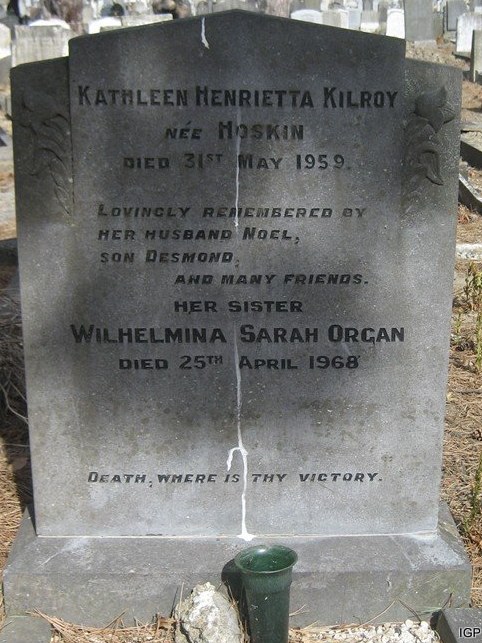 |
|
Headstone of Kathleen Henrietta Kilroy in
Mt Jerome cemetery, Dublin, county Dublin
|
Kathleen died on 31 May 1959, and is buried in Mt Jerome cemetery, Dublin.
The headstone reads:
KATHLEEN HENRIETTA KILROY | née HOSKIN | Died
31st May 1959 | Lovingly remembered by | her husband NOEL, | son DESMOND |
and many friends. | Her sister | WILHELMINA SARAH ORGAN | Died 25th April
1968 | "Death where is thy victory"
Bank Official
26 October 1965, at the Royal City of
Dublin Hospital, Dublin, county Dublin, Ireland, aged 56
Noel Kilroy, of The Avenue, Gorey, Co. Wexford, died on October Twenty sixth
March 1965 at Royal City of Dublin Hosp. He was a retired bank manager,
married, and aged 56 years. The cause of death was carcinomatosis, carcinoma
of bronchus.
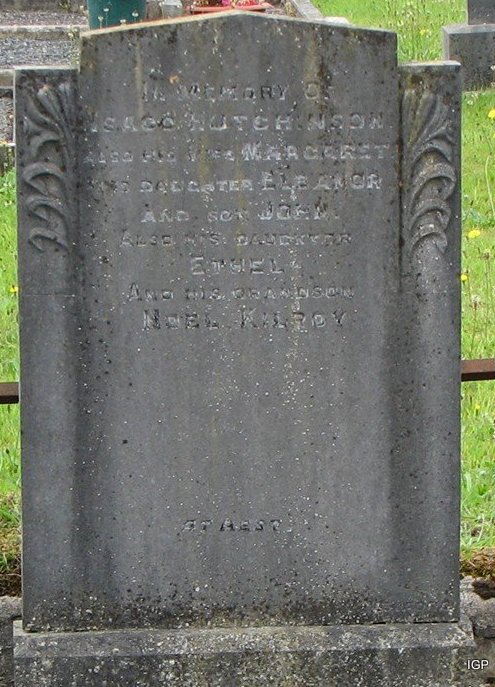 |
|
Headstone where Noel James Isaac Kilroy is
buried in Christ Church graveyard, Gorey, county Wexford
|
Christ Church graveyard, Gorey,
county Wexford, Ireland. Noel is buried in the family grave of his
grandfather, Isaac Hutchinson.
The headstone reads:
In Memory of | ISAAC HUTCHINSON | Also his wife
MARGARET | his daughter ELEANOR | and son JOHN | also his daughter | ETHEL
| and his grandson| NOEL KILROY. | At Rest
1911:
High Street, Tullamore, Kilbride parish, King's county
1933: Fermoy, county Cork (marriage
record)
1965: The Avenue, Gorey, county Wexford (death
record)
Percy Joseph Kilroy
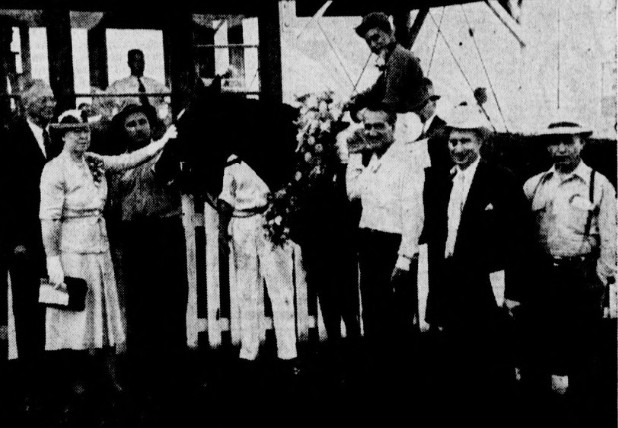 |
|
Percy "Pat" Kilroy (right) with Fort
Garry, the winner of the Western Canada handicap in 1948. Mrs. J.
S. McDiarmid, wife of Hon. J. S. McDiarmid, minister of mines and
public works, decorates the winner in the enclosure. In the saddle
is Jockey Paul Bailey with Max Freed, Frank Kilroy and Pat Kilroy
beside the horse.
|
18 September 1887, at Derrysheridan,
Killeagh parish, county Meath, Ireland
Unnamed male was born on Eighteenth September 1887 at Derry Sheridan, the
son of James Kilroy, gentleman, of Derry Sheridan, and Maria Kilroy formerly
Gibson.
James Watkin
Kilroy
Maria (Gibson) Kilroy
Dorothy Frank Cottrell on 5 March
1932 in St James, Winnipeg, Manitoba, Canada
Percy attended
Vaughan Charter School in Tubbrid, Drumkeeran, county Fermanagh, where
he was admitted on 10 March 1900. The school records show that he was
baptised in Castlepollard, county Westmeath. Percy was apprenticed to a shop
in Ballyboy in October 1904. This didn't last long, and Percy sailed
to Canada on the Bavarian
which departed Liverpool on 4 May 1905, via Moville,
Ireland, arriving in Halifax in April 1905. His destination is listed as
Winnipeg. In the 1906 census, Percy is listed as a hired man on the John
Morrow farm in Selkirk district, Manitoba. He later moved to Kenora, Ontario
where he found work with the Canadian Pacific Railway.
Percy volunteered for the Canadian Expeditionary Force in World War I on 30
January 1917. His attestation
papers list his trade as a locomotive engineer and his address as the
Y.M.C.A. in Kenora, Ontario. He is single, born on 19 December 1899, in
Oldcastle, Ireland. His next of kin is his sister, Mrs. T. Marshall of 1458
Ross Avenue, Winnipeg, Man. Percy is described as being 5 ft 7 ins. tall, of
fair complexion with blue eyes and brown eyes.
Kenora Miner and News 31 January 1917
(Kenora, Ontario)
20
ENGINEERS AND FIREMEN ENLIST
LOCAL C. P. R. MEN OFFER FOR RAILWAY CONSTRUCTION AND OPERATIVE
SERVICE IN FRANCE?WILL LEAVE SHORTLY
In regard to the number of men enlisting from Kenora for
overseas service, this week has been the best since the early months of
the war, no less than twenty C.P.R. engineersand firemen enlisting in
the Railway Construction and Operating Battalions now being mobilized to
go to France. Their work will be particularly in connection with th
egreat offensive movement in the spring. They will operate trains in
constructing the railway lines as the enemy is pushed back, and also
trains for bringing up troops and supplies to the front, and it is
pleasing to note that the number of Kenora men already at the front will
be considerably augmented in a very short time. Following are the names
of this very important service:
Engineers?
H. Britton
M. Harris
G. Banks
A. Alterton
S. Towns
A. McKay.
R. Pollock
J. McLennan
P. Kilroy
A. McKee
J. A. Love
J. A. Hutchinson
Firemen
N. Smith
A. Fordes
T. Thorpe
G. Bateson
G. McClatchie
M. Brown
A. Reynolds
I. Hawkins
Kenora Miner and News 7 February 1917
(Kenora, Ontario)
32
KENORA MEN LEAVE FOR FRONT
WERE GIVEN A SPLENDID SEND-OFF AT THE STATION THIS AFTERNOON
A large crowd gathered at the station shortly after noon
today to say good-bye to thirty-two local C. P. R. men who enlisted for
overseas service in Section No. 1 Skilled Railway Operators, and who
passed through for the east. They were as fine a body of men as ever
left Kenora, and their skilled service will be of great value to the
allied cause in the operation of military trains. They are all
well-known local young men, and they had a very busy time during the
10-minute stop of the train saying good-bye to relatives and their many
friends, all of whom wished them a safe return. Following are the names
of those who left today:
H. Britton, M. Harris, G. Banks, A. Alterton, S. Towns, A. McKay,
R. Pollock, G. McClatchie, J.McLennan, P. Kilroy, A. McKee, J.A.
Hutchinson, F. Fullford, R. Mableson, W. J. Hawkins, N. Smith, A.
Forbes, T. Thorpe, M. Brown, A. Reynolds, M. Blight, W. McVeigh, O.
Sigurdson, A. Cripps, C. Husband, I. Hawkins, A. Barclay, G. Miles, H.
Dawson, Thos. Huchinson, J. H. McKay, R. Redding.
Judy Stockham provides further details of Percy's war service at the Kenora
Great War Project :
Organized in December of 1916 with recruitment amongst railway men in
all military districts east of Winnipeg, the No 1 Section, Skilled
Railway Employees had a number of enlistments from CPR employees from
Kenora. A local newspaper article of the 31st of January 1917 published
the names of some 20 men who had enlisted, and another article of the
7th of February spoke of the men passing through Kenora by train,
heading east on the first leg of their journey to the front. As a
Private with the No 1 Section, Percy embarked from Halifax on 4 March
1917 aboard the Ausonia.
Once in England Percy was promoted to Acting 2nd Corporal on the
23rd of March. The next month, on April 11th, he was admitted to the
Military Isolation Hospital at Aldershot suffering from parotitis, the
mumps. He was discharged on the 26th of June and posted to the No 85
Canadian Engine Crew Company at Purfleet on the 13th of November,
reverting to rank of Sapper at his own request. By the 12th of December
Percy was in France.
From January until June of 1918 Percy was attached to the No 58
Broad Gauge Railway Operating Company, rejoining the No 85 Canadian
Engine Crew Company on the 6th. In early November of 1918 he was
admitted to the No 35 General Hospital in Calais with inflamed adenoids
and tonsils, discharged by the end of the month. In January of 1919 he
was granted a fourteen day leave to the UK and by mid April he proceeded
back to England. After a series of transfers, Percy was discharged in
July with his intended residence given as High Street in Tullamore,
Kings County, Ireland where his brother James Arthur had been living in
the 1911 Ireland census.
At some point Percy returned to Canada and continued working for
the Canadian Pacific Railway in Kenora and Winnipeg. On the side while
in Kenora he also sold radios for General Electric. On 5 March 1932, in
St James, Winnipeg, Percy married Dorothy Frank Cottrell. The couple
were found on a 1935 Kenora Voters list as residing at the Kenricia
Hotel. To his friends Percy was known as Captain Pat of Devil's Gap
Lodge on Lake of the Woods. Retiring from the CPR as an engineer in
1945, Percy then became the building superintendent of the Hart Building
in Winnipeg. He was a long time member of the Winnipeg Game and Fish
Association, of the Hook and Slice Club, and the Carleton Club. In April
of 1958 Percy returned to Ireland for a three month holiday, intended
destination given as Rheban Castle in Athy on the passenger list of the
Empress of France that arrived
in Liverpool on the 22nd. His marital status was given as single.
(Note: Rheban Castle was the family farm of the Large's - Percy's elder
sister, Isabella, had married Robert Large of Rheban Castle before they
emigrated to Canada in 1909.)
3 October 1960 at his home at 155
Mayfair Avenue, Winnipeg, Manitoba, Canada
Kenora Miner and News 4 October 1960
(Kenora, Ontario)
Long-Time
Member Of Game And Fish Association Dies
Percy (Pat) Kilroy, of 155 Mayfair Avenue, died Monday in
Winnipeg. Born in Ireland in 1887, Mr. Kilroy came to Canada as a young
man, served with the Canadian forces in France from 1914 until 1919 and
was know to his friends as Captain Pat of Devil's Gap Lodge.
He retired from the Canadian Pacific Railway as engineer in 1945
and had been the building superindendent of the Hart Building. He was a
long time member of the Winnipeg Game and Fish Association and was a
member of the Hook and Slice Club and a former member of the Carleton
Club.
He is survived by two sisters, Mrs. Mae Large and Mrs. A.
Tinkler: a grand nephew, Frank Kilroy and several nieces and nephews in
Ireland, Canada and the United States. Funeral services will be at 1:30
p.m. Thursday in St. Andrews Anglican Church, Rev. J. S. Whitehouse
officiating. Burial will be in the Chapel Lawn Memorial Gardens. Mordue
Brothers Funeral Home is in charge.
Honorary pallbearers will be Dr. Vernon Smith, Gerhard Kennedy,
Nate Shuckett, Duke Campbell, Harry Jeffries and Fred Prest. Active
bearers will be Frank Kilroy, Matt Mann, Dr. Norman Anderson, Dunc
Sproat, John Donovan and Gerry Dennehy.
6 October 1960, in Chapel Lawn
Memorial Gardens, Winnipeg, Manitoba, Canada. His grave is in Old Rugged
Cross Lot 13 Grave 0001.
1901:
Vaughan Charter School, Tubbrid, Drumkeeran, county Fermanagh
1906:
Selkirk district, Manitoba
1960: 155 Mayfair Avenue, Winnipeg, Manitoba (Kenora Miner and News 4 October 1960)
Percy Gibson Kilroy
12 February 1912, at High Street,
Tullamore, King's County, Ireland
Percy Gibson was born on Twelfth February 1912 at High St., Tullamore, the
son of James A Kilroy, merchant, of High St., Tullamore, and Lucy Kilroy
formerly Hutchinson.
James Arthur
Kilroy
Lucy Hannah (Hutchinson) Kilroy
Kathleen Howard on 8 January 1935
in the parish church, Clontarf, Dublin, county Dublin, Ireland
Percy Gibson Kilroy is recorded as a bachelor, of full age, the son of James
Arthur Kilroy, shopkeeper. Percy is a clerk, resident at 5 Waverley Av.
Kathleen Howard is recorded as a spinster, of full age, the daughter of John
Edward Howard, whose profession is described as "retired business". Kathleen
is resident at 5 Waverley Av. The wedding was witnessed by Desmond A. Kilroy
and John Edward Howard.
Kathleen was the daughter of John Edward Howard. She died on 19 December
1975, and is buried in Deansgrange cemetery graveyard, Rathdown, county
Dublin.
Clerk
9 November 1989
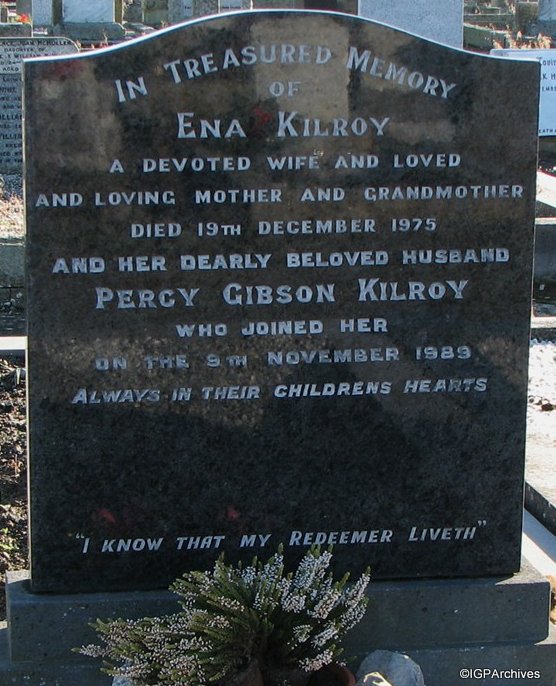 |
|
Headstone of Percy Gibson Kilroy and
Kathleen (Howard) Kilroy in Deansgrange cemetery, Dublin, county
Dublin
|
Deansgrange cemetery graveyard,
Rathdown, county Dublin, Ireland.
The headstone reads:
In Treasured Memory | of | ENA KILROY | a devoted
wife and loved | and loving mother and grandmother | died 19th December
1975 | and her dearly beloved husband | PERCY GIBSON KILROY | who joined
her | on the 9th November 1989 | Always in their childrens hearts | "I
know that my Redeemer liveth".
1935: 5 Waverley Avenue, Dublin, county Dublin (marriage
record)
1965: The Avenue, Gorey, county Wexford (death
record)
Philip Le Feuvre Kilroy
1844, in Plymouth, Devon, England
Alexander
Kilroy
Maria Lucinda (Fry) Kilroy
Louisa Susan Le Feuvre in 1867 in South
Stoneham
district, Hampshire, England.
Louisa was born in 1839, in Southampton, Hampshire, and baptised in 1840 in
Southampton All Saints, the daughter of William James Le Feuvre and Martha
(Mansell) Le Feuvre. She died in 1919, on the Isle of Wight, aged 79.
1851: South
Stoneham, Hampshire
1861: Highfield,
South Stoneham, Hampshire
1871: Highfield,
South Stoneham, Hampshire
1881:
Plymstock,Devon
1891: 72 Chaucer Road, Bedford St
Paul, Bedfordshire
1901: Pellhurst
Road, Ryde, Isle of Wight
1907: Fairfield, Ryde, Isle of Wight (The Medical Press 10 July 1907 p50)
1910: "Fairfield", Ryde, Isle of Wight (manifest
of the Cincinnati 24 October
1910)
1911: Ryde, Isle
of Wight
1916: "Fairfield", Ryde, Isle of Wight (manifest
of the New York 19 August 1916)
Army Surgeon, reaching the rank
of Brigade Surgeon Lieutenant Colonel.
Philip joined the Royal Army Medical Corps as an assistant surgeon on 2
October 1865. He is listed in the Regimental Chronicle of the 60th, or King's Royal
Rifle Corps, as an assistant surgeon from 1867 to 1873. He
was promoted to surgeon on 1 March 1873 and in
1875 was stationed in West Forts. Philip was made Surgeon Major on 2
October 1877. Hart's
Army
List for 1882 shows Philip as a Surgeon Major, stationed in Bengal.
Philip was promoted to Lieutenant-Colonel on 2 October 1885 and to
Brigade-Surgeon Lt. Col. on 10 March 1892. He retired on 15 May 1895.
13 August 1905, in Paramé, France
British
Medical Journal 26 August 1905 p466:
OBITUARY.
LIEUTENANT-COLONEL
PHILIP LE FEUVRE KILROY,
late of the Royal Army Medical Corps, of Eastfield, Ryde, Isle of Wight,
died at Paramé, France, on August 13th, at the age of 61. He entered the
Army Medical Department as Assistant-Surgeon, October 2nd, 1865; became
Surgeon, March 1st, 1873; Surgeon-Major, October 2nd, 1877; was granted
the rank of Lieutenant-Colonel, October 2nd, 1885; and made
Brigade-Surgeon-Lieutenant-Colonel, March 10th, 1892. He retired from
the service, May 15th, 1895. He had no war record.
1851: Alfred
Place, St Andrew, Devon
1881: Plymstock,
Devon
1891: North End
Road, Fulham, London
1901: Pellhurst
Road, Ryde, Isle of Wight
Reginald James Kilroy
10 October 1881, at Glen Road,
Eglinton, Dunedin, New Zealand
Otago Witness 5 November 1881 p17
BIRTHS.
On the 10th October, at Glen road, Eglinton, the wife of M. M.
Kilroy, of a son.
Mark Moore
Kilroy
Mary Ellen (Moore) Kilroy
Eveline Gordon Matheson in 1920 in
New Zealand
Eveline was born in 1889, in Dunedin, Otago, New Zealand, the daughter of
Thomas Matheson and Annie Stronach Grant. She died on 2 December 1948, in
Dunedin, aged 58, and was cremated on 3 December 1948. Her ashes were
scattered on 4 December 1948.
Dunedin
Probate and Letters of Administration Files 1948-9075-24027
THIS IS THE
LAST WILL AND TESTAMENT
of me
EVELINE GORDON KILROY of Dunedin in the
Provincial District of Otago and Dominion of New Zealand Widow.
1. I REVOKE all wills and testamentary dispositions heretofore made by
me and declare this to be my last will and testament.
2. I GIVE DEVISE AND BEQUEATH the whole of my real and personal property
whatsoever and wheresoever situate (including the proceeds of any policy
or policies of Insurance upon my life) unto such of them my children
MARY ELLEN BROCKETT, ANNETTE KILROY and REGINALD THOMAS KILROY as shall
survive me and if more than one in equal shares AND I APPOINT EDMUND
JAMES SMITH of Dunedin aforesaid Solicitor SOLE EXECUTOR of this my Will
3. I DECLARE that the said Edmund James Smith or my other Executor for
the time being of this my Will being a solicitor shall be entitled to
charge and be paid for any work done by him or by the firm with which he
is associated in the premises whether in the ordinary course of his
profession or business or not and although not of a nature requiring the
employment of a Solicitor.
IN WITNESS WHEREOF I have hereunto subscribed my name this
twelfth day of March One thousand nine hundred and fortysix.
SIGNED AAND ACKNOWLEDGED by the said EVELINE GORDON KILROY the Testatrix
as and for her last will and testament in the presence of us both at the
same time who at her request and in her presence and the presence of
each other have hereunto subscribed our names as witnesses:-
R. A. King Solicitor Dunedin
N. M. Morrison Clerk Dunedin
Draper.
Reginald was a commercial traveller for the Butterworth firm before the War,
leaving "the road in 1914", although he continued to work for Butterworth
Bros, who are listed as his employers on his attestation papers in 1917 (New
Zealand Archives R18057048 p6).
Evening Star 5 October 1914 p4
At the
Commercial Travellers' Club, Dowling street, on Saturday evening a large
and representative gathering of commercial travellers met and made a
presentation to Mr R. J. Kilroy; who has lately left "the road." Mr
Morrall, in handing Mr Kilroy, on behalf of his fellow-travellers, a
gold-mounted walking stick and a gold sovereign case, suitably
inscribed, referred to his many sterling qualities, and wished him every
success in his new sphere. Several old comrades also paid eloquent
testimony to Mr Kilroy's popularity. Mr Collie, on behalf of Mr Kilroy's
Naseby customers, presented him with a nugget tiepin of local gold. The
recipient feelingly responded.
Dunstan Times 18 May 1914 p5
THE
LOSS OF REG KILROY.
Central Otago is in mourning to day
And cant be consoled whate'er one can say,
For she's lost her pet boy
Her dear Reg Kilroy,
Who has bid her good-bye and left her for aye,
They cry from afar, away up at Tarras,
Why should fortune forsake us and unduly harrass
People who did enjoy
Dear old Reg Kilroy —
Whom we ne'er could insult and ne'er could embarras.
Lowburn mourns and says, through Mick Spratt
What do Butterworths mean, and what are they at
In spoiling our joy
By transferring Kilroy,
A man who can run the whole place on his pat.
Dave Young says the people of Cromwell are furious,
That losing Kilroy is really injurious
For with now friends they're coy,
And they'll miss Reg Kilroy ;
And how trade will do now they're certainly curious.
Mack at the Dunstan says he'll be sadly missed ;
Most girls in Clyde he has probably kissed.
And there's no other boy
Who could do that like Kilroy.
And for actions like this he'll surely be blessed.
Alexandra's McClintock has told us, with tears,
Alexandra has dealt with Kilroy for years
No one there would annoy
Their old friend Kilroy.
And always did welcome his visit with cheers.
So Central Otago does mourn out loud,
And Butterworth's firm should be rather proud
That they do employ
A man like Kilroy,
Who with business ability seems well endowed.
J. B. MACK.
Clyde, 13/5/14.
Reginald took over the drapery firm of Kilroy and Sutherland after
his father's death, and a court report relating to a burglary at the store
in 1928 refers to him as the managing director of that firm (Otago Daily Times 9 October 1928 p3).
Reginald served as a non-commissioned
officer World War I, and was awarded the Military Medal
He was passed as fit for military service in a medical exam at the Drill
Hall, Kensington, Dunedin in April 1916 (Evening Star 3 April 1916 p6). He left
Dunedin as a corporal in the 20th Reinforcements Infantry on 29 June 1916.
Otago Witness 5 July 1916 p52
A HEARTY FAREWELL.
The
bleak northerly wind on the 29th, with just a suspicion of rain in the
air did not serve in the least to dull or damp the enthusiasm of the
crowds that gathered to honour the men of the Eighteenth Reinforcements
as they left to go into camp. The usual routine was followed, the men
parading first of all at Drill Hall at 10 o'clock, where they were
addressed by Mrs J. K. Mache (of the Women's Recruiting Committee) and
Colonel E. R. Smith.
...Small gift parcels distributed to the men from the Women's Patriotic
Association were greatly appreciated by the men, who loudly cheered the
thoughtful donors.
From the Drill Hall the men, led by the Kaikorai Band, were
marched along the Anderson Bay road and Princes street to the Octagon,
and thence down Stuart street to the railway station. A liberal display
of bunting testified to the public's appreciation of the men who wero
going forward. and many business places were closed for an hour to
enable employees to take part in the farewell gathering in Anzac Square.
...
The Kaikorai Band led the men on to the
station amid cheering, and the work of entraining was speedily carried
out. The police exercised a rigorous supervision over approaches to the
station, and no one on the platform without a pass could long escape
detection and a firm request to leave. The strains of "Tipperary" from
the band were the parting note as the train drew out at noon.
Reginald was promoted to temporary sergeant on 12 December 1916 (Evening Post 13 December 1916 p8, New
Zealand Archives R18057048 p5). He embarked from Wellington on the Athenic on 30 December 1916 (Nominal
Rolls of New Zealand Expeditionary Force Volume II), arriving in
Devonport on 3 March 1917 and proceeded to Sling
Camp in Wiltshire where he was assigned to the 2nd Otago Company,
reverting to the rank of corporal. Reginald failed to qualify at A.T.G.
class for N.C.Os on 30 March and reverted to the rank of private (New
Zealand Archives R18057048 p5). On 3 April, Reginald was assigned to
the 4th Reserve Battalion Canterbury of the Otago Regiment as a private and
transferred to nearby Codford.
He was promoted to lance corporal in the newly
formed 3rd Batallion, Otago Regiment on 19 May, and shipped to France,
on 28 May (New
Zealand Archives R18057048 p5). In the Official History of the Otago Regiment, N.Z.E.F. in
the Great War 1914-1918 p246-7, A. E. Byrne provides a great
account of the movements and activities of the 3rd Battalion in France. They
moved by train to Southampton, and shipped overnight to Le Havre. They
proceeded to Bailleul and played a role in rear support during the Messines
Battle, repairing and reconstructing the Wulverghem-Messines Road and
performing traffic control duties. On the night of 22-23 June, the 3rd
Battalion moved up to the front in relief, and were in possession of
trenches for the first time. Reginald's 4th company held a section of the
line opposite the German-held village of Frelinghien. The Battalion was
relieved in the line on June 30th, and proceeded to billets at Les Trois
Tilleuls, near Pont de Nieppe.
Reginald was promoted to corporal on 2 July 1917 in the 4th Company of the
battalion and detached to the School of Instruction, in the field, on 12
July. He was appointed
temporary lance sergeant on 28 July, returned to his battalion on 11
August, and then promoted to sergeant on 22 August (New
Zealand Archives R18057048 p4). The 3rd Battalion was generally
alternating between construction support work near the front and billets at
Pont de Nieppe. On 1 September, they departed for a new area farther west at
Henneveux, travelling by train and lorries to billets in Cremarest, for a
period of training. On 25 September they returned east, to Eecke, then the
Forth Camp at Poperinghe, and on 1 October to Vlamertinghe in Belgium, where
the Battle
of Passchendaele (also known as the Third Battle of Ypres) was
ongoing. On 4 October the 3rd Battalion participated in their first
offensive action, part of an action to regain the village of Gravenstafel.
Official History of the Otago Regiment, N.Z.E.F. in
the Great War 1914-1918 p254-8 (A. E. Byrne, 1921)
The 3rd Battalion of the Regiment, quartered in
the area of the old British and German front lines, completed all
details of equipment during the day of October 2nd, and Company officers
visited the front line and made a reconnaissance of the country. On the
same evening the Battalion moved forward and took over the front line
from the 1st Battalion of Otago, which had been in occupation since the
morning of September 30th, relief being completed by 10 p.m.
...
Zero hour was 6 am. on October 4th. Rain fell overnight and the morning
broke cheerless and drizzly, with the sky heavily overcast. The early
stages of the night had passed fairly quietly, save for intermittent
shelling, but after midnight enemy artillery fire gradually increased in
intensity, until at about half an hour before zero it assumed the
fierceness of barrage fire and extended heavily to the south. This, it
was subsequently learned, was the preliminary to an attack in force
which the enemy was about to launch in an endeavour to regain the
positions wrested from him during the British attacks of September 26th,
and which our own attack but briefly anticipated. An hour and a-half
before zero all companies had reached their assembly positions, and
under increasingly heavy shell fire awaited the moment of attack. The
two front line Companies selected for the assault were, from right to
left-4th, commanded by Captain N. H. Arden, and 14th, commanded by
Captain M. Watt; 8th Company, commanded by Captain E. H. Sharp, was
detailed for mopping-up purposes, and in that capacity was to assist the
leading Companies.
...
At 6 a.m. our artillery broke out in thunderous concert with the enemy's
guns, and moving behind a splendid barrage the Battalion advanced to the
assault. The attack, once hunched, moved forward without check until the
main enemy resistance was encountered, consisting of "pill-boxes,"
machine gun emplacements, and fortified shell-holes along the slopes of
Abraham Heights. The locality of Otto Farm, the first enemy stronghold,
fell to the determined attack of one section of 8th Company, and yielded
33 prisoners. Forward of this point the quagmire of the Hanebeek
rendered progress exceedingly difficult, many of the attacking troops
sinking almost to their thighs in the slime and filth. Van Meulen Farm
and dug-outs constituted one of the main defensive points of the ridge,
and with strongly emplaced machine guns and a considerable garrison,
offered a resistance which eventually broke before a determined attack
organised and personally led by Captain N. H, Arden, resulting in the
capture of over 50 prisoners and machine guns. On the objective being
gained, Captain Arden, who had been wounded early in the advance, went
forward to determine the most suitable line for consolidation, and was
there grievously wounded, dying. a few moments after he had given his
instructions. In the death of Captain Arden the Regiment lost a brave
and capable officer. Command of 4th Company was now taken over by Lieut.
M. Rohan.
...
The 3rd Battalion of Otago Regiment, as its share in the operation, had
also achieved substantial and decisive success, which was the more
remarkable by reason of being the Battalion's first offensive effort.
The Battalion's casualties total six officers and approximately 150
other ranks; on the other side of the scale, the captures included over
250 prisoners and eight machine guns. The sodden and yielding nature of
the ground, while seriously impeding advance, had certainly minimised
casualties from shell fire, the shells generally burying themselves well
below the surface before bursting. The majority of the casualties
sustained were due to machine gun fire.
On 4 October, during the action described above, Reginald was severely
wounded by gunshot to the chest and face. He was transferred back through
the lines being admitted at the 3rd New Zealand Field Ambulance, then the
3rd Australian Field Ambulance and the 10th Casualty Clearing Station in the
field on the 5th, admitted to the 3 Stationary Hospital in Rouen on 6
October 1917, then evacuated to England on a hospital ship Essequibo
on 10 October and admitted to the New Zealand General Hospital Brockenhurst,
Hampshire, on 12 October. He was transferred to the Convalescent
Depot at Hornchurch, London on 23 October where he remained until 6
November. After that he was given two weeks convalescence leave, and
reported to Codford
Depot on 23 November (New
Zealand Archives R18057048 p1). Codford housed the New
Zealand Command Depot, which provided rehabilitative training to
soldiers not yet fit enough to return to their unit. Reginald was awarded
the Military Medal on 31 October 1917, for acts of gallantry in the field (New
Zealand Archives R18057048 p12,
London Gazette 14 December 1917 p13201).
The Commercial Travellers and Warehousemen's Association noted in late
December of that year that "ex-Committeeman Sergeant R. J. Kilroy, who was
wounded some time ago, is now convalescent, and has been awarded the
Military Medal. A cable of congratulation has been sent to our old
colleague." (Evening Star 21 December 1917 p2).
On 29 January 1918, Reginald rejoined the 4th Reserve Battalion of the Otago
Regiment in Sling Camp and was promoted to Company
Quartermaster Sergeant (C.Q.M.S.) on 22 April. On 23 October 1918, it
was decided that Reginald woudl be evacuated to New Zealand on duty - he was
transferred to the New Zealand Discharge Depot at Torquay on 31 October (New
Zealand Archives R18057048 p4) and returned to New Zealand aboard the
Ayrshire leaving Plymouth on 6
November and arriving in Auckland on 22 December 1918 with the rank of Staff
Quartermaster Sergeant (Evening Star 13 December 1918 p5). Reginald
was discharged from service on 23 January 1919 (New
Zealand Archives R18057048 p1).
In his attestation papers in 1917, Reginald was described as being 5 foot 7
inches tall, weighing 182 pounds.He had light brown hair, blue eyes and a
fair complexion (New
Zealand Archives R18057048 p6).
6 March 1945 at Seacliff
Mental Hospital, Otago, New Zealand, aged 63
7 March 1945. Reginald's ashed
were scattered on 8 March 1945
Dunedin
Probate and Letters of Administration Files 1945-9075-21179
THIS IS THE
LAST WILL AND TESTAMENT
of me
REGINALD JAMES KILROY of Dunedin in the Provincial District of Otago and
Dominion of New Zealand Mercer
1. I REVOKE all wills and testamentary dispositions heretofore made by
me and declare this to be my last will and testament
2. I DECLARE that if my wife EVELINE GORDON KILROY shall survive me then
and in such case I GIVE DEVISE AND BEQUEATH all my real and personal
property whatsoever and wheresoever situated (including the proceeds of
any policy or policies of Insurance upon my life) unto my said wife
absolutely and I APPOINT my said wife SOLE EXECUTRIX of this my will.
3. I DECLARE that if my said wife shall predecease me or if my said wife
and I shall die simultaneously then and in such case I APPOINT EDMUND
JAMES SMITH of Dunedin aforesaid Solicitor (hereinafter called "my
Trustee") TRUSTEE AND EXECUTOR of this my Will AND I DIRECT AND DECLARE
that this paragraph and the subsequent paragraphs of this my Will shall
take effect but that otherwise such paragraphs shall be absolutely null
and void.
5. I GIVE DEVISE AND BEQUEATH all my real and personal property
whatsoever and wheresoever situated (including the proceeds of any
policy or policies of Insurance upon my life) unto my Trustee UPON TRUST
that he shall sell call in collect and convert into money the whole or
such part or parts thereof as shall not already consist of money at such
time or times and in such manner as he shall think fit but so that he
shall have the fullest power and discretion to postpone the sale calling
in collection or conversion of the whole or any part or parts thereof
during such period or periods as he shall think proper and to retain the
same in its present form of investment without being responsible for
loss.
6. I DIRECT my Trustee to pay my just debts and my funeral and
testamentary expenses and the duty (if any) on my estate out of the
proceeds of such sale calling in collection and conversion or out of any
ready moneys of which I shall die possessed AND to retain the balance of
such proceeds and any ready moneys as aforesaid (hereinafter called "my
residuary estate") and to stand possessed thereof:
(a) UPON TRUST as to both capital and in come for all and every
my children or my child (if only one) who have attained the age of
twenty one years and if more than one as tenants in common in equal
shares.
(b) PROVIDED NONETHELESS that In case any child of mine has died
in my lifetime whatever his or her age leaving issue or shall die after
my death but before attaining the age of twenty one years leaving issue
him or her surviving such issue shall stand in the place of such
deceased child and take per stirpes and equally between them if more
than one the share of my residuary estate which such deceased child
would have taken if he or she had survived me and had attained the age
of twenty one years.
(c) PROVIDED FURTHER that in case any child of mine has died in
my lifetime whatever his or her age without leaving issue or shall die
after my death but before attaining the age of twenty one years without
leaving issue him or her surviving then and in such case the share of my
residuary estate which my said child so dying would have taken if he or
she would have survivedme and had attained the age of twenty one years
shall accrue to and vest in such of his or her brothers and sisters as
shall be living at the death of the child so dying and if more than one
in equal shares.
7. I DECLARE that my Trustee may in his absolute discretion pay or apply
the whole or any part of the income or the capital of the share of any
of my said children to which he she or they might be entitled in
possession if of full age in or towards his or her maintenance education
advancement or benefit during his her or their minority.
8. I DECLARE that the said Edmund James Smith or any other Executor or
Trustee for the time being hereunder being a Solicitor or any other
person engaged in any profession or business shall be entitled to charge
and be paid for any work done by him or his firm in the premises whether
in the ordinary course of his profession or business or not and although
not of a nature requiring the employment of a Solicitor or other
professional person. IN WITNESS WHEREOF
I have hereunto subscribed my name this Sixth day of July One
thousand nine hundred and twenty six.
SIGNED AND ACKNOWLEDGED by the said REGINALD JAMES KILROY the Testator
as and for his last will and testament in the presence of us both
present at the same time who at his request in his presence and in the
presence of each other have hereunto subscribed our names as witnesses:-
W. Carson Solicitor Dunedin
Allan B. Bennie Law Clerk Dunedin
1917: 5 Neidpath Road, Mornington, Dunedin, Otago (New
Zealand Archives R18057048 p1)
1917: 5 Neidpath Road, Mornington, Dunedin, Otago (New
Zealand Archives R18057048 p17)
1921: Hart Street, Roslyn, Dunedin, Otago (Otago Daily Times 2 July 1921 p8)
1945: 16 Kilgour Street, Dunedin, Otago (Dunedin
City Council cemetery search)
Richard Kilroy
 |
 |
|
Gravestone of
Richard and Elizabeth Kilroy, and their daughters Hannah and
Elizabeth, in the churchyard at Ballymachugh Parish Church. It is
probably part of the old church wall.
|
Detail of the
gravestone:
Here Until the
Resurrection are
deposited the Remains of Richd
Kilroy Esq of Omard and of
Elizabeth his beloved Wife the
Former Depd this life on the 18th
April 1823 aged 43 Years the Latter
on the 19th August 1830 aged 45 Years
also the Remains of Hannah their
Eldest daughter who Depd this
life the 7th of Sept 1827 aged 19 Years
and of Elizabeth their Fourth
Daughter who Depd this life on
the 28 of Aug. 1827 aged 13 Years
This tribute to the memory of
Richd and Elizabeth Kilroy has
been Raised by their affectionate
Daughters Maria Maxwell
and Frances Fearns
|
1777-80, in Ireland
_____ Kilroy
Elizabeth _____
Elizabeth was born in 1784-6, in Ireland. She died on 19 August 1850, aged
45, and is buried at the Ballymachugh parish church, county Cavan.
Census:
1821:
Omard, Ballymachugh, county Cavan
Farmer. In the 1821 census,
Richard is recorded as owning 109 acres in the townland of Omard, an
extremely large area for this time and place, and indicates he was a very
wealthy man.
18 April 1823, aged 43. Alan Hutchinson has his date of
death as 20 April 1843, and his age at death as 44.
Ballymachugh Parish Church, county
Cavan, Ireland
1821:
Omard, Ballymachugh, county Cavan
- Richard's gravestone
inscription at Ballymachugh has his age as 43 at his death in 1823, and
Alan Hutchinson lists his age as 44 at his death. The 1821 census lists
Richard as aged 43, indicating birth in 1777 or 1778. Place from death
record of daughter Maria at New
Jersey Death and Burials batch B06609-7
- Inscription on
gravestone in Ballymachugh parish church; Elizabeth birth from age at
death (the 1821 census lists Elizabeth's age as 35 indicating birth in
1785 or 1786 ) with place from death record of daughter Maria at New
Jersey Death and Burials batch B06609-7; Elizabeth death, burial
from inscription on gravestone in Ballymachugh parish church
- 1821 census
- Inscription on gravestone
in Ballymachugh parish church; Alan
Hutchinson's
Wilton web site
- Inscription on
gravestone in Ballymachugh parish church
- 1821 census; Kilroy
family notes
Richard Kilroy
1816/7
Richard Kilroy
Elizabeth (_____) Kilroy
1821:
Omard, Ballymachugh, county Cavan
Richard Thomas Joseph Kilroy
1863, in Dublin, county Dublin,
Ireland
John Kilroy
Catherine Wilhelmina (Wigelsworth)
Kilroy
Bridget A. Devine on 15
August 1892, in Middleborough, Plymouth county, Massachusetts, United
States. Richard is listed as aged 31, born in Dublin, Ireland, single, the
son of John Kilroy and Catherine Wigglesworth. Bridget A. Devine is listed
as aged 27, born in Dublin, Ireland, single, the daughter of Thomas Devine
and Mary Renigon (or Kerrigan). Bridget, who used the nickname Delia, died
on 6 March 1902, in Middleborough.
Cora Evelyn Terry on 26
August 1905, in Central Falls, Rhode Island, United States. Richard is
listed as aged 41, born in Ireland, widowed, the son of John Kilroy and Kate
Wigelsworth. Cora is listed as aged 27, born in Fall River, Massachusetts,
the daughter of Benjamin Terry and Isabel Manchester.
Cora was born on 15 February 1878, in Fall River, Bristol county,
Massachusetts.
1880:
Fall
River, Bristol county, Massachusetts
1900:
Middleboro
Town, Plymouth county, Massachusetts
1920:
Abington
Town, Plymouth county, Massachusetts
Richard emigrated to the United
States in 1890
Richard Anthony Kilroy
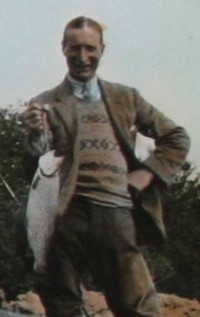 |
|
Richard Anthony Kilroy
(May 1935)
photograph from Jerry Gosnell
|
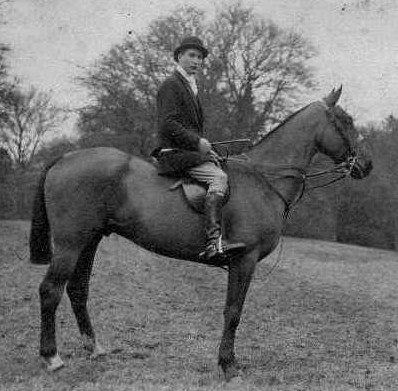 |
|
Richard Anthony Kilroy
photograph from Jerry Gosnell
|
27 February 1895, in Oldcastle,
county Meath, Ireland
William
Wesley Kilroy
Annie
Catherine Maxwell (Groome) Kilroy
Martha Jane Webb on 15 June 1927 in
the parish church, Kilbixy, county Westmeath, Ireland
Richard Anthony Kilroy is recorded as a bachelor, of full age, the son of
Wm. W. Kilroy, a gentleman farmer. Richard is a gentleman farmer, resident
at Clongill, Wilkinstown, county Meath. Martha Jane Webb is recorded as a
spinster, of full age, the daughter of Matthew William Webb, a gentleman
farmer. Martha is resident at Kilbixy rectory, Ballynacargy. The marriage
was witnessed by W. W. Kilroy, A. Kilroy and Percival J. L. Webb.
Martha was born on 29 August 1885, at Bracklagh, Drumlumman, county Cavan,
the daughter of Matthew William Webb and Elizabeth Jane Syndon. Martha died
on 13 April 1968, and was buried on 15 April 1968 in Killeagh cemetery,
Oldcastle, county Meath.
Richard usually used the name "Tony".
He served in World War I, enlisting in the 12th Regiment, Canadian Mounted
Rifles in Calgary on 18 June 1915 (Trooper 117338)
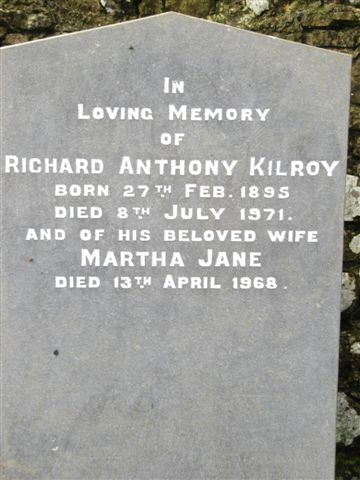 |
|
Gravestone of Richard Anthony Kilroy and
Martha Jane (Webb) Kilroy in Killeagh Cemetery, Oldcastle, county
Meath, Ireland
photograph from Jerry Gosnell
|
8 July 1971
Killeagh cemetery, Oldcastle, county
Meath, Ireland
The headstone reads:
In loving memory of Richard Anthony Kilroy born
27th Feb 1895 died 8th July 1971 and of his beloved wife Martha Jane died
13th April 1968
1901:
Moat, Oldcastle, county Meath
1911:
Mountjoy School, Mountjoy Square, St Peters, Dublin, county Dublin
Robert Alexander Kilroy
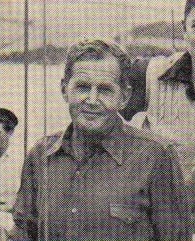 |
|
Commander R. A. Kilroy (1949)
|
known as "Robin"
Commander Robert Alexander Kilroy,
D.S.C.
27 June 1904, in Nottingham
district, Nottinghamshire, England
8 July 1904, in St Barnabas,
Nottingham, Nottinghamshire, England
Lancelot
Kilroy
Hester Mary (Dowson) Kilroy
Officer in the Royal Navy, with
a temporary commission in the Royal Air Force.
Robert joined the Royal Navy as a midshipman on 15 May 1922 on the
battleship Queen Elizabeth and
promoted to acting sub-lieutenant on 15 September 1924, then sub-lieutenant
on 15 June 1926. On 4 January 1927, Robert was granted a temporary
commission as Flying Officer on attachment for 4 years' duty with the R.A.F.
(London
Gazette 14 January 1927 p289). He was promoted to Lieutenant
on 17 December 1927 (London Gazette 23 December 1927 p8244).
In June 1929, Robert, a lieutenant on board the Eagle,
was involved in the rescue of Ramón
Franco, a famed Spanish pioneer aviator (and brother of future Spanish
dictator Francisco Franco), for which he was awarded the Cross of the First
Class of the Order of Naval Merit by the King of Spain on 2 December 1929
"in recognition of valuable services rendered by him" (London Gazette 3 December 1929 p7863).
Flight 4 July 1929:
Spanish Atlantic Airmen Found
H.M.S.
"EAGLE," the aircraft carrier, found the missing Spanish
Dornier-Wal flying-boat on June 29, after the machine had been missing
for a week. It will be remembered that Major R. Franco and his
companions, left Spain for the Azores on June 21 on the first stage of
an attempt to fly to America. They were first reported to have landed
safely, but later that was denied. Then an extensive search by aircraft
and surface craft, in which H.M.S. Eagle
was ordered to take part, was waged for a week. The Admiralty received
the following message from H.M.S. Eagle,
which contains Major Franco's story of the flight. "We left Los
Alcazares (Cartagena) at 17.00 hours, June 21, passing Cape St. Vincent
at 21.00 hours. From the Cape we were forced to gain height owing to
excessive air disturbances. From Cape St. Vincent to the Azores was an
interrupted layer of cloud, above which we had to fly. Later another
cloud layer formed above us. The intended time of our arrival at the
Azores was 09.00 G.M.T. on June 22, but a strong north-east wind which
we were unable to foresee or check in flight, caused us to pass over the
Azores during the dark. At dawn we took our longitude by the sun, which
showed that we were to the south-west of the Azores.
"We therefore flew through the clouds
and alighted to economise fuel and examine the situation more closely.
We checked our position and took off, shaping a course to Fayal, but,
owing to strong headwinds, ran out of petrol about 40 miles from that
point. Strong north-easterly winds drifted us to the south, and on the
following day, June 23, we were about 100 miles from Fayal. The wind
shifted to the south-west, reaching gale force, and drifted us to the
island of Santa Maria. From June 24 to 27 winds of varying force and
direction drifted us about. On the morning of the 27th the situation was
extremely dangerous on account of the wind and sea conditions. At dawn
on June 29 the aircraft-carrier Eagle
found us in the vicinity of Santa Maria and took us on board. The
behaviour of the aircraft and engines (Hispano-Suizas) was magnificent."
The aircraft-carrier reached Gibraltar
on July 2 and the crew and the Spanish airmen received a great welcome.
The Governor of Algeciras conveyed the Spanish Government's thanks to
Capt. Lawrence of H.M.S. Eagle,
whilst Spanish aircraft flew over the British warship. Flt.-Lieut.
Lewin, who flew the machine from which the airmen were sighted has been
singled out for special praise, and it is understood that the Spanish
Government intends to award decorations to Capt. Lawrence and Lieut. R.
A. Kilroy, who sighted the machine when on duty in the aircraft-carrier.
The Auburn Citizen (Auburn, New York) 2
July 1929:
Rescue of Spanish Trans-Atlantic Fliers
Described by Airplane Carrier Chief
Gibraltar, July 2.-(AP) - How he clung to a forlorn hope and followed a
fantastic light gleam near the Azores Saturday morning to save the lives
of the Spanish trans-Atlantic aviators was told by Lieutenant R. A.
Kilroy of H. M. S. Eagle today.
Lieutenant Kilroy was on watch before
dawn Saturday morning of last week. The weather had been rough the day
before and neither he nor his fellow officers believed there was a
chance the Dornier-Wal plane of Major Ramon Franco still floated
At 4 a. m. there was a queer weird beam
from the surface of the sea far to the South of him. It might have been
most anything but Lieutenant Kilroy turned the Eagle about and in a few
minutes was able to make out the plane. With the four Spaniards aboard,
waving and gesticulating to him.
Lieutenant Kilroy was reticent but
Major Franco was more voluble. He [line unreadable] after that came down
south-east of the Azores. These gave their position, but apparently they
were not picked up. Day after day they drifted with the wind, and on
their fifth and sixth day afloat, Thursday and Friday, June 27 and June
28, a heavy sea made them fear that would be their last.
On the morning of Saturday, June 29,
Maj. Gonzales Gallarza saw a vessel's lights, probably 20 miles away.
The aviators flashed their own Bengal lights and sent up some rockets,
then spent anxious moments wondering if they were seen. They were
overjoyed a little later to see the craft turn In their direction and
make way rapidly toward them.
The fliers were taken aboard, and at 6
o'clock, two hours after they were sighted, their plane was lifted up by
the carrier's hoists and lodged on one of the decks. Lieutenant Kilroy
said Major Franco and his three companions were exceedingly cheerful
despite their danger.
Although they still had plenty of food
aboard their drinking water was running short and they had been using
the fluid from the engine and radio tanks. They were visited aboard the
Dornier by Lieutenant Stevenson of the Eagle before they came aboard. He
shook hands with them and they thanked him earnestly.
Major Franco told the story of their
landing early Saturday morning, June 22, just a week before they were
picked up. He said conditions were bad on the journey with visibility
greatly impaired by layers of clouds. There was dense fog over the
Azores in which they could find no break. They knew they were over the
islands but if they attempted to fly low and get their exact bearings
they probably would crash. Therefore they flew around until they were
sure they were over the sea and then came down upon the water.
Their fuel was exhausted because of
having flown so long through the fog. After landing on the water they
saw no ships for more than six days. They took turns sleeping, one of
the four always on the lookout. They had considerable rough stormy
weather and bad seas with their plane pitching heavily. They were not
seasick, however, and did not suffer.
Each night they used some of their
signal rockets, firing the last of them when the Eagle's lights finally
were sighted.
Robert also served in the Hermes
and the Glorious. He was promoted
from Flying Officer to Flight Lieutenant on 1 January 1934 (London Gazette 29 December 1933 p17) and to
Squadron Leader on 31 December 1937 (London Gazette 31 December 1937 p8194).
When the war began in 1939, Kilroy commanded the Fleet Air Arm's 778
Squadron, a service trials unit, and in 1940 was Commanding Officer of 815
Squadron embarked in the Illustrious.
On 24 April 1940 he led that that squadron to to join RAF Coastal Command in
minelaying operations in the English Channel. He was awarded the
Distinguished Service Cross, a naval medal awarded for 'gallantry during
active operations against the enemy', for minelaying operations in a Swordfish
when in command of 815 Squadron In May 1940 he provided support during
the Dunkirk evacuation and was promoted to Commander on 30 June 1940 (London Gazette 2 July 1940 p4016). In 1941
Robert was appointed Commander (Flying) at Lee on Solent, Fleet Air Arm
Headquarters in Southern England. He was sent to Colombo in 1942 as a member
of the Air Staff, and held that appointment until joining the Indefatigable.
Evening Post (Wellington, New Zealand) 28
November 1945 p8:
NAVAL CAREERS
CARRIER'S OFFICERS EXPERIENCE IN SERVICE
MINELAYING IN SWORDFISH
The
Commander (Flying) in the ship [Indefatigable] is Commander Robert
Alexander Kilroy, D.S.C, R.N., of London. Aged 41, he began to
specialise in flying in 1927, served in H.M. Ships Eagle, Hermes,
Glorious, and Illustrious, before, and during the early days of the war.
Of these, the Eagle was sunk by torpedoes in the Mediterranean, the
Hermes was bombed to the bottom by the Japanese off Ceylon, the Glorious
was sunk by the Scharnhorst off Norway, and the Illustrious survived
many hazardous operations in the Mediterranean. Later, she helped open
the British Pacific Fleet's offensive against the Japanese off the
Sakishima Gunto.
When the war began in 1939, Commander
Kilroy commanded the Fleet Air Arm's 778 Squadron, a service trials
unit, and in 1940 was Commanding Officer of 815 Squadron embarked in the
Illustrious. In that year he was promoted Commander, and in 1941 was
appointed Commander (Flying) at Lee on Solent, Fleet Air Arm
Headquarters in Southern England. He was sent to Colombo in 1942 as a
member of the Air Staff, and held that appointment until joining the
Indefatigable.
Commander Kilroy was awarded the D S C.
for minelaying operationsin a Swordfish ("Stringbag*') when in command
of 815 Squadron.
After the war Robert was appointed Boom Defence Officer in Singapore. Boom
defences laid steel nets around harbours and individual ships to
protect them from submarines and torpedos. Robert retired on 27 June 1954 (London
Gazette 29 June 1954 p3829).
On 17 November 1904, Hester and her children Maud and Robert (but not
Alix?), along with Evelyn Roebuck, their nurse and governess, entered the
United States on The Majestic (manifest),
from
Liverpool. Their final destination is given as Bermuda with the intention of
joining Lancelot Kilroy at the Royal Naval Hospital, Bermuda.
On 22 March 1905, Lancelot, his wife Hester and children Maud Winifred and
Robert, and Evelyn Roebuck, returned to the United States aboard the Bermudian (manifest)
sailing from Hamilton, Bermuda. They were en route to London, and they give
their last residence as Bermuda.
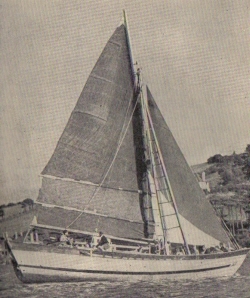 |
|
The Boleh
|
In 1949, Robert "Robin" Kilroy designed and built a Malay junk yacht Boleh and then sailed it in an epic
15,000 mile journey from Singapore to Salcombe, Devon with a crew of five.
The "jhow" left Singapore on 18 January 1950 (The Straits Times 18 January 1950 p4) and
arriving in Salcome on 1 September 1950 (The Sunday Herald (Sydney, Australia) 3
September 1950 p5). The voyage, with stops in Sabang, Colombo,
Minikoi, Seychelles, Mauritius, Port Elizabeth, Simonstown, St. Helena,
Ascension and Cape Verde was the subject of a book, Boleh,
Kilroy wrote in 1951.
Robin gave a series of lectures in England about his journey, and a series
of photos, technical
drawings and illustrations about the voyage and the wildlife he
encountered are published at the bolehproject
website.
The Boleh was severely damaged by
fire in 1978, but was rebuilt and was later purchased by a Kilroy family
trust. It is now a registered National
Historic
Ship and is in Portsmouth, Hampshire being
restored to be used for sail training for disadvantaged young people.
The Straits Times 14 August 1949 p7
THE BOLEH WILL SAIL TO U.K.
5-month trip in
20-ton 'jhow'
Sunday Times Staff Reporter
THREE
Royal Navy Officers, a Royal Naval Dockyard civilian and possibly two
Malay youths intend to sail a small Singapore-built craft to England in
January next year - a 12,000-mile voyage which will take about five
months.
Commander Robin Kilroy, D.S.C., R.N.,
is at present supervising the building of this vessel of his at the Boom
Depot, Loyang. He calls his little craft - she less then 20 tons
displacement - a "jhow." That is because she is a mixture of Chinese
junk and Arab dhow in design, with the high stern typical of Eastern
vessels.
He has named her the Boleh, partly as a
tribute to the two Trengganu Malays who are building her. These
shipwrights, Embong bin Salleh and Ali bin Ngah, have just returned to
work on the Boleh, after spending the Hari Raya festival at home in
Trengganu.
They do not mean to sail in her to
England, but two youngsters who are helping Commander Kilroy with the
construction, may sign on as crew.
Their names are Ahmad bin Samin, of
Batu Pahat, and Omar bin Saleh, of Siglap, each aged 18. Their keenness,
as they work on the Boleh, is a pleasure to watch, whether they are
planning or caulking or dyeing sail.
The boat will have a great brown sail
like a junk, half slatted, and has a hull of stout chengai wood.
Now that work is nearing completion,
the boat is hoisted on an iron trolley in the open. Commander Kilroy
wants her ready for trials in October, "as," he says, "we must leave
Singapore for England in January."
The Boleh's course will be from Malaya
to Ceylon, across to the Seychelles and through the Mozambique Channel
to Durban. Then she will round the Cape of Good Hope to St. Helena,
Ascension, the Azores and so to Salcombe, Devon.
Salcombe is the home of many sailing
men, and Mr. George Jarvis, of the R. N. Dockyard, Singapore Naval Base,
who is one of Commander Kilroy's crew, hails from there.
The other two, so far chosen, are
Lt,-Cdr. John Rusher and Lt.-Cdr. Peter Aplin. The ideal fifth
Englishman has not yet turned up, but the Commander has his ideas on the
subject of what type of man he would best like.
On holidays, stripped to the waist, the
Boleh's skipper toils on his craft. He has even enlisted feminine help
in the person of the wife of a friend.
The Boleh will not voyage entirely by
sail, as there is a 9 h.p. engine. Two water tanks capable of carrying
120 gallons will be fitted fore and aft, but there will be no system of
refrigeration.
And this lack of means of keeping food
supplies cool is worrying the skipper. "Of course, we could trail stores
in the water at night." he said with a puzzled expression.
The Sunday Herald (Sydney, Australia)
3 September 1950 p5:
Halfway Round The World In 16-Ton
"Dream" Boat
From Our Staff
Correspondent
LONDON
Sept. 2. - The Boleh, 16 tons, a craft which is a cross between a
Chinese junk and an Arab dhow, reached Salcombe Harbour, Devon,
yesterday after sailing 12,000 miles from Singapore.
Malaya shipping men had laughed at her
and said she would not last an hour in bad weather.
"Boleh" is Malay for "can do".
The Boleh, 38ft long, rode out half a
dozen storms during her 194 days at sea.
Her master is Commander Robin Kilroy,
R.N., who designed her.
Kilroy, who was boom defence officer in
Singapore at the end of the war, decided to build his "dream ship" and
sail to his home town of Salcombe. He persuaded three other Royal Navy
men to get long leave and join him.
He enlisted a Chinese cook, Chang
Hai-kun.
Four Malay workmen built the vessel in
a Singapore shipyard in 16 months. It cost £3,000.
TINS AND TUNNY
"For weeks we saw nothing but sea, sky,
waves, and stars, but we were never bored," said the electrician and odd
jobs man, Lieutenant-Commander J. S. Rusher.
The crew played chess, worked out more
than 1,000 crossword puzzles, and kept in touch with news by radio.
They ate 38 different kinds of tinned
meat, and Chang Hai-kun discovered seven ways of cooking tunny.
1951: Boleh
The Straits Times 21 January 1952 p8
Singapore To
U.K. Before The Wind
BOLEH. By Robin Kilroy. (Hodder
and Syoughton, 15s)
-By -
BRUCE FRASER
MOST
people with a love for the sea and boats have a dream at the back of
their minds that one day they will cut loose from the worries of the
shore, and make a deep-sea voyage in their own small craft. They hanker
after the right to call themselves blue-water sailors, to know the
flying fish and boisterous draught of the trade winds as their familiar
friends.
Back to
earth
AND then, like most
of us they go back to their stuffy offices, and realise sadly that the
money and the time are lacking: to wake up some years later and find
that neither money nor time are lacking, but that there are other things
such as family ties that have swallowed the anchor for them almost
unnoticed.
But for some people, the Alain
Gerbaults, the Joshua Slocums and the Irving Johnsons, the dream comes
true. For Robin Kilroy the dream came true too, perhaps even better than
for most, for he designed and built his own ship in Singapore, with
restricted funds and from local resources, and then sailed it round the
Cape of Good Hope to England, was a feat that only those who have
struggled with the archaic methods and startling prices of local
boatbuilders can appreciate.
Advantages
AS
a naval officer Kilroy had some advantages: he was incharge of the Boom
Defence Depot at Loyang, with the facilities of a slipway at his
disposal. he had a band of helpers whose enthusiasm made up much for
their lack of experience. Best of all he was able to enlist the help of
some skilled naval shipwrights and engineers, who spent many week-ends
of their spare time to aid him, and one of whom, George Jarvis, joined
his crew for the homeward voyage.
His disadvantages were that his
artist's eye (he was an amateur painter of some worth) had given him a
liking for the exotic in naval architecture: and that he preferred to
rediscover for himself what many generations of seaman had already found
out in the hard school of the ocean sailing ship routes.
So he designed his ship Boleh with a
high poop owing something to the junks of China and the dhows of the
Indian Ocean: with a quadruped mast of horrible weight and windage
aloft, tried and rejected by deep-water sailors many years ago: and a
mainsail stiffened by "wishbones" which were in theory aerodynamically
splendid, but a perfect nightmare to live with at sea.
From the crew's point of view his
nastiest innovation was the propeller drive, a curious Heath Robinson
device which enabled the propeller to be removed when the engine was not
in use, saving drag. Unfortunately it was so unsound mechanically that
power was seldom available, and when it was the noise made life a
misery.
But in spite of all this, in spite of
his admission that most of what he had considered his excellent ideas
were failures, he took Boleh home. His book is a record of solid
achievement, although with its likeness to a ship's log, its steady
record of the trivia of shipboard life, it is no literary masterpiece.
The crew
HE
took with him a crew of four - Peter Aplin and John Rusher, both
naval officers, George Jarvis, a civilian employed in the Naval
Dockyards, and Chang, his cook. From his book only two characters come
to life: Peter Aplin, whose diary forms a large part of the book, who,
as sailing master and navigator, probably did most towards the voyage's
successful conclusion: and Chang, a paragon of all sea-cooks, never
weary, never complaining.
Scant justice is done to the vivid
personality of John Rusher. One gets the impression that as caterer he
never managed to turn up a meal antone liked: in fact his humour was
probably a saving grace in the irritation which always ensues when too
many people are confined too long in a small ship.
Kilroy is now stationed in the West of
England, and gets down to Boleh whenever he can. She has descended from
an ocean voyager to a quiet yacht for coastal cruising. Though no
greyhound of the seas, perhaps as the ocean racers storm past her bound
for then Fastnet Rock or Santander, she chuckles quietly and a little
proudly to herself what her Malay shipwrights from Trengganu said as she
took the water at Loyang: boleh!
The Straits Times 23 March 1952 p14
'BOLEH' - AND
THE MEN WHO SAILED HER
- By Our Literary Critic
DURING
1949 there was built at the Boom Defence depot at Loyang in Singapore a
yacht, which its owner, Commander Kilroy, R.N., describes as a Malay
junk yacht: "It is, as the White Knight said 'my own invention'."
On completion of this craft, which Cdr.
Kilroy built in his spare time and at his own expense, he was granted
six months' half-pay leave, and, having signed on a four-man crew
consisting of a caterer-maitre d'hotel-electrician a
navigator-boatswain-diarist, a shipwright-engineer and a cook, he set
sail from Singapore for home, and after 170 saiing days across 15,000
miles of ocean, reached Salcombe harbour, Devon, in September, 1950.
"Boleh" is Cdr. Kilroy's story of this
great voyage, and is a most readable book from every point of view.
There is much technical detail, both of the building of the boat, and of
the voyage itself, but there is plenty of humour and general interest,
and plenty of illustrations, thought the photographic reproduction is
not of a very high order.
AS
with all great ventures there were many setbacks, great and small, to be
overcome. Cdr. Kilroy, for example, had spent three tedious weeks
tracing and inking in the first set of construction drawings, for
printing. Finally, all was finished, except for the rubbing out of the
old pencil marks.
"I had to attend a meeting at the
dockyard at 9 o'clock, and had first to go to the office, which left me
with very little time. Whilst drinking my coffee I began on the rubbing
out, with Lim Fok Gnow, my most intelligent Chinese steward of those
days, standing watching me and simply itching to help in some way. It
was a rather slow process ... some care to prevent the dry ink from
coming off in places with the pencil marks. At last I could delay no
longer, so I explained the difficulty of the ink to Lim and left him to
carry on while I dashed down to the office.
"As usual I was detained there a little
longer than I had meant to be. When I returned to the bungalow some
twenty minutes later to collect the drawing, Lim presented me proudly
with a completely clean sheet. The ink-lines that he could not get off
by heavy application of the rubber he had erased with one of my
safety-razor blades.
I was fond of Lim."
1 February 1961, in
Salcombe, Devon, England
1911: Kingsbridge district, Devon: Robert Alex Kilroy is aged 6
Sarah Anne (Kilroy) Russell
known as "Sallie"
Richard Kilroy
Elizabeth (_____) Kilroy
Thomas
Samuel Russell on 22 January 1852, in Ballymachugh, county Cavan,
Ireland. Thomas is listed as single, the son of Eleas Russell. Sarah is
listed as single, the daughter of Richard Kilroy.
Sallie is listed in the Kilroy family
notes as a member of this family. She does not appear with the family in the
1821 census, and was probably born after the census but before her father's
death in 1823. Sarah is noted in the death record of her daughter, Marian,
to have predeceased Marian, who died on 19 January 1917.
Susan Kilroy
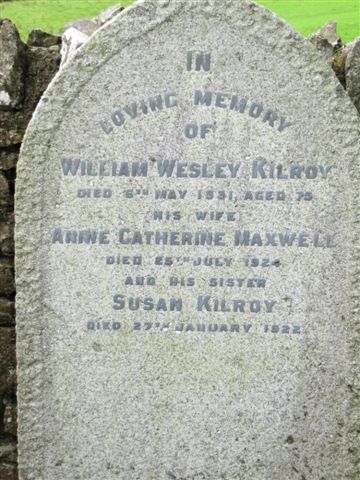 |
|
Gravestone of William Wesley Kilroy, Annie
Catherine Maxwell (Groome) Kilroy and Susan Kilroy in Killeagh
Cemetery, Oldcastle, county Meath, Ireland
photograph from Jerry Gosnell
|
30 June 1846, in county Cavan,
Ireland
James Kilroy
Anne
Moore
Known as "Lily"
26 December 1921, at Moat View,
Oldcastle, county Meath, Ireland
Susan Kilroy died on Twenty-Sixth December 1921, at Moat-View, Oldcastle.
She is recorded as a spinster, aged 75 years and her occupation is
housekeeper. The cause of death is listed as cerebral haemorrage resulting
from gangrene of foot. The informant was Wm W. Kilroy, of Moat View,
Oldcastle.
Killeagh cemetery, Oldcastle, county
Meath, Ireland
The headstone reads:
In loving memory of William Wesley Kilroy died
6th May 1931 aged 75 his wife Annie Catherine Maxwell died 25th July 1924
and his sister Susan Kilroy died 27th January 1922
1901:
Castlereban North, Churchtown, county Kildare (Susan is visiting her
niece, Isabel (Kilroy) Large
1911:
Scallanstown, Ardbraccan, county Meath
- IGI (AFN: KMQ4-FX);
place from 1911 census
- Notes on the Kilroy
family from Kathleen Kilroy
- Ireland
civil records Deaths 1922 Oldcastle #168; Ireland Death Index
(1Q1922 Oldcastle vol 3 p473); the gravestone lists Susan's death date
as 27 January 1922, but I have preferred the civil record.
- Gravestone
Susan Edith (Kilroy) Dudenhoeffer
28 May 1882, at Derrysheridan,
Killeagh parish, county Meath, Ireland
Susan was born on Twenty Eighth May 1882 at Derrysheridan, the daughter of
James Kilroy, farmer, of Derrysheridan, and Maria Kilroy formerly Gibson.
James Watkin
Kilroy
Maria (Gibson) Kilroy
Jean
Baptiste Alexandre Dudenhoeffer on 4 December 1909 in St Mary,
Johannesburg, Transvaal Colony
Jean Baptiste Alexandre Dudenhoeffer is recorded as a bachelor, aged 32,
born in Basel, Switzerland. He is resident at 22 Biccard St, Johannesburg.
Susan Edith Kilroy is recorded as a spinster, aged 26, born in Ireland. She
is resident at 79 Loveday St, Johannesburg. The marriage was witnessed by
E.F.M. Lommerd and F. Nugent.
13 February 1913, at 119 De Korte
Street, Wanderers View, Johannesburg, Transvaal, South Africa, aged 29 years
and 9 months
Susan Edith Dudenhoeffer (born Kilroy) is recorded as born in Oldcastle,
County Meath, Ireland, the daughter of James Kilroy (dead) and Maria Kilroy
(born Gibson) (dead). Susan is a housewife, aged 29 years and 9 months.
1909: 79 Loveday St, Johannesburg, Transvaal (marriage record)
1913: 119 De Korte Street, Wanderers View, Johannesburg,
Transvaal (death notice)
Virginia Catherine Kilroy
23 January 1897, in Middleborough,
Plymouth county, Massachusetts, United States
Richard
Thomas
Joseph Kilroy
Bridget A. (Devine) Kilroy
1900:
Middleboro
Town, Plymouth county, Massachusetts
1920:
Abington
Town, Plymouth county, Massachusetts
William Kilroy
11 June 1837, in Ballymachugh, county
Cavan, Ireland
Anthony
Kilroy
Catherine (_____) Kilroy
Farmer
12 April 1865 at 8 Charlemant St.,
Dublin, county Dublin, Ireland, aged 26
granted 2 May 1865, to Anthony
Kilroy
Ireland
Calendar of Wills 1865 p114
KILROY
William. 2 May Letters of Administration of the
personal estate of William Kilroy late of Ornard in the County of
Cavan Esquire a Bachelor who
died 12 April 1865 were granted at the Principal
Registry to Anthony Kilroy of Ornard aforesaid Esquire the
Father only next of kin of said deceased. Effects
under £600
1865: Omard, county Cavan (Ireland
Calendar of Wills 1865 p114)
William James Kilroy
1848, in Plymouth, Devon, England
17 July 1848, in St Andrew, Devon,
England
William James is recorded as the son of Alexander and Maria Kilroy.
Alexander is a surgeon, R.N., and resident in Alfred Place.
Alexander
Kilroy
Maria Lucinda (Fry) Kilroy
William was Fleet Paymaster in
the Royal Navy. William was made assistant paymaster with seniority from 11
December 1869. On 2 March 1871, William joined the Scout,
a corvette in the Pacific, as assistant paymaster (1872 Navy List), and he was still aboard the Scout in the Pacific in
1873 and when it was ordered home in 1874.
On
5 August 1875, William joined the Excellent,
a gunnery ship stationed in Portsmouth (1876
list). On 10 January 1877, William joined the Seagull,
a gun-vessel, as assistant paymaster in charge. In the 1878 Navy List, the Seagull
had been stationed in the Cape of Good Hope and the West Coast of Africa,
but was ordered back to Devonport. On 30 July 1880, William joined the Euphrates, an Indian troop ship (1881
list) where we still find him in the 1881 census. On 11 August 1881,
William joined the Malabar, an
iron troop ship, stationed in Porstmouth (1882
list) and on 1 October 1882 he joined the Crocodile,
also a troop ship based in Portsmouth (1883
list). On 20 July 1883 William joined the Sultan,
attached to the Channel Squadron (1885
list). On 13 January 1886, William was promoted to paymaster, and on 3
April 1886, he joined the Kingfisher,
a composite sloop based in the East Indies, as paymaster (1887
Navy list). On 1 February 1889 William
joined, as paymaster, the Hyacinth,
a screw cruiser 3rd class which was in China at the time of the 1891 Navy List. William retired as Fleet
Paymaster on 30 April 1900.
1901, in the Isle
of
Wight district, Hampshire, England, aged 53
1851: Alfred
Place, St Andrew, Devon
1881: Euphrates,
Royal Navy, England
1901: Buckingham
Road, Ryde, Isle of Wight
William Wesley Kilroy
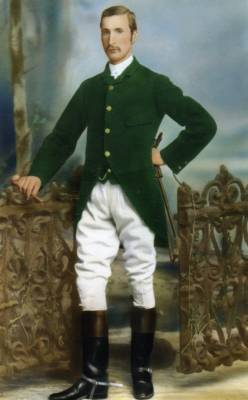 |
|
William Wesley Kilroy
scan by Chris Gosnell
|
 |
|
Gravestone of William Wesley Kilroy, Annie
Catherine Maxwell (Groome) Kilroy and Susan Kilroy in Killeagh
Cemetery, Oldcastle, county Meath, Ireland
photograph from Jerry Gosnell
|
27 April 1856 in county Cavan,
Ireland
James Kilroy
Anne
Moore
Annie
Catherine Maxwell Groome on 20 September 1888, in the parish church,
St Peters, Drogheda, county Louth, Ireland
William Wesley Kilroy is recorded as a bachelor, of full age, the son of
James Kilroy, gentleman. William's occupation is listed as gentleman, and he
is resident at Moatview, Oldcastle, county Meath. Annie Katherine Maxwell
Groome is recorded as a spinster, of full age, the daughter of Edward
Groome, clerk in holy orders. Annie is resident in St Peters, Drogheda.
Farmer and Land Agent. This is
how William describes himself in the 1901 census and in 1911 as Assessor,
Surveyor and Farmer. On 9 February 1889, William was appointed as a
magistrate in Meath county, and is described at the time as a land agent and
landowner. William was an executor of the will of his wife's aunt, Catherine
Dalzell Carpendale in 1917, at which time he is listed as a Surveyor. In
1926, he writes a letter from Moat View, and notes that he is "Assessor for
Honr. Mr. Justice Wylie Land Judge" and that he valued land all over Ireland
"for him & others". In the same letter he notes that previously he had
had a large stud farm, but reduced its size in 1914, because his work took
him away from home so much.
6 May 1931, in Oldcastle, county
Meath, Ireland, aged 75
William Wesley Kilroy is recorded as a widower and gentleman farmer, aged
76. The cause of death is listed as septic pneumonia and heart failure.
Killeagh cemetery, Oldcastle, county
Meath, Ireland
The headstone reads:
In loving memory of William Wesley Kilroy died
6th May 1931 aged 75 his wife Annie Catherine Maxwell died 25th July 1924
and his sister Susan Kilroy died 27th January 1922
William was Master of the Ballymacad fox hounds.
1896: Moat View, Oldcastle, county Meath (birth certificate of daughter
Annie Kathleen)
1901:
Moat, Oldcastle, county Meath
1911:
Moat, Oldcastle, county Meath
1926: Moat View, Oldcastle, county Meath (letter in possession of Chris
Gosnell)
Willie Dickson Kilroy
1876, in Southampton Highfield,
Hampshire, England
Philip Le
Feuvre Kilroy
Louisa Susan (Le Feuvre) Kilroy
Edith Mary Maclaran in 1906 in Farnham
district (Hampshire and Surrey), England. Edith was born on 10 August
1874 in the Bombay Presidency, India, and was baptised on 22 September 1874
in Tanna, Bombay, India, the daughter of Francis Blayney Maclaran and Mary
Beckwith Armstrong. Edith died on 15 December 1954, at "Dolphins", Everton,
near Lymington, Hampshire.
Census:
1881: 59 West St,
Chichester St Peter The Great, Sussex
1891: West Pallant St., Chichester
All Saints, West Sussex
1901: Frimley, Surrey: Edith M. Maclaran, daughter, is aged 26, born in
India
1911: Harrow on the Hill, Middlesex: Edith Kilroy is aged 36, born in Bombay
Presidency
Electrical Engineer.
Willie was elected an Associate of the Institute of Electrical Engineers in
January 1899.
Willie served during World War I in the Royal
Navy Volunteer Reserves. He was made temporary Lieutenant on 16
November 1915 (London Gazette 23 November 1915 p11592) and
appointed Assistant to the Director of Naval Ordnance. The Royal Navy
adopted several of his inventions, including Kilroy's
Danger Signal and the Mechanical Aid-to-Spotter
Willie was awarded an O.B.E. on 1 April 1919 "for valuable services in
connection with the design and improvement of fire control instruments." (London Gazette 28 March 1919 p4197)
Willie was a prolific inventor, and secured numerous patents including, in
1907, a Means
for
Automatically Indicating Certain Relative Positions of Guns or the like to
Each Other, in 1909 an application "For Improvements Relating to
Electro-motors and to the Production of Sound Waves for Signalling to a
Distance, in 1910, a patent "for Improvements in and Relating to Danger and
Like Signal Devices, in 1916 a Sound
Emitter with fellow inventor Sydney Evershard and, in 1928, one for "1934, Willie,
his brother Lancelot and F. Wheatley received for a patent for "A
new or improved device for holding fish hooks, artificial flies or baits"
and in 1955 he patented "Improvements
in and relating to blocks for yachts, boats and the like"
9 November 1956 at "Dolphins",
Everton, near Lymington, Hampshire, England, aged 81
1881: Plymstock,
Devon
1891: 72 Chaucer Road, Bedford St
Paul, Bedfordshire
1901: Fulham, London: Willie Kilroy, visitor, is aged 25, born in
Southampton, Hampshire. He is an Electrical Engineer
1911: Harrow On The Hill, Middlesex: Willie Kilroy is aged 35, born in
Southampton, Hampshire
1934: Lane End, Everton, Lymington, Hampshire (patent
application)
1954: "Dolphins", Everton, near Lymington, Hampshire (London Gazette 7 January 1955 p207)
1956: "Dolphins", Everton, near Lymington,
Hampshire (London Gazette 23 November 1956 p6693)
William Ernest Kilroy
May 1885, in New Zealand
Mark Moore
Kilroy
Mary Ellen (Moore) Kilroy
Carpenter, building contractor
and War Pensioner.
In his attestation papers in 1915 (New
Zealand Archives R18057049 p5), William is recorded as a carpenter,
last emplyed by G. Muir, a farmer in Balclutha.
William struggled in his business activities after the war. In 1923 he was
taken to court for non-payment of a delivery of steel windows ordered for a
building project, and in 1927 he was convicted of forging a signature on a
cheque. The
will of William's mother, written in 1938, leaves his inheritance in a
trust to provide an income to him, a provision not made for his siblings,
and may be a result wither of William's inability to manage his finances, or
perhaps to shield that inheritance from any legal liability. A codicil to
Mary Ellen's will, written later that same year contains the information
that she had "purchased a "Times" Newspaper Run in Dunedin aforesaid for the
sum of Two hundred pounds which Paper Run is being operated and worked by my
son WILLIAM ERNEST KILROY AND WHEREAS I have also advanced to the said
William Ernest Kilroy the sum of THIRTYONE POUNDS THIRTEEN SHILLINGS AND
FOURPENCE as a deposit on the purchase by him of a Motor Car to enable him
to operate and work the said Paper Run more conveniently."
Auckland Star 30 November 1923 p8
BY
WHOSE ORDER?
A dispute as to whom certain materials were to be charged was the
subject of a case decided yesterday afternoon at the Magistrate's Court
by Mr. W. R. McKean, S.M. The plaintiff, Alfred Woolnough (Mr. Thwaites)
claimed from W. Monks (Mr. Ready) and W. E. Kilroy, who did not appear
and was not represented, the sum of £75, alleged to be due for some
steel windows supplied for defendant Monk's factory. The claim against
the defendants was jointly and separately. The defence entered by Monk
was that he did not order the windows, also that the sum of £200 had
been paid to Kilroy.
Mr. McKean said that the evidence submitted was not sufficient to
establish joint and several liability. The order was not signed by
Kilroy per Monks. The evidence showed that Monks called on the plaintiff
to get quotations, but did not himself give an order. Plaintiff accepted
the order given by Kilroy, care of Monks. That however did not suggest
it was intended to make Monks liable. Mr. McKean said he was not able on
the evidence to give judgment against Monks, but was prepared to give it
against Kilroy.
Mr. Thwaites elected to take judgment against Kilroy. Plaintiff
was then nonsuited as against Monks, and judgment was given in
plaintiff's favour against Kilroy by default for the amount claimed,
with costs.
Auckland Star 21 June 1927 p5
ENDORSED
A CHEQUE.
FORGERY CHARGE FOLLOWS.
TECHNICAL OFFENCE ADMITTED.
In the Police Court yesterday afternoon, before Messrs. S. J.
Marks and L. S. Rickerby, J.P.'s, three charges of forgery were
preferred against William Ernest Kilroy, aged 40 (Mr. Beattie). Accused
was charged with forging the name of W. Wall to the endorsement of a
cheque for £4 9/6 and to two receipts for £4 9/6 and 17/3.
Wall stated that Kilroy agreed to renew an iron roof for him.
Accused measured the amount of iron required, and witness gave the order
to Hardleys, Limited.
Further evidence showed that accused returned two lots of iron to
Hardleys, Limited receiving 17/3 in cash and a cheque for £4 9/6. He
signed the name of W. Wall in receipt of each amount, and also endorsed
the cheque in Wall's name and cashed it.
Accused, in a statement, said that Wall told him be could have
any iron that was left over. He had had to sign Wall's name to get the
money, as Wall was away.
Accused at first pleaded not guilty, and was committed to the
Supreme Court for trial. Later he pleaded guilty to a technical offence
in signing Wall's name to the cheque. He was committed for sentence on
this charge.
William served in the Otago Infantry
Battalion in World War I, and was severley wounded at Gallipoli. He enlisted
on 11 January 1915 as a private in the 3rd Reinforcements of Otago Infantry
Battalion. William shipped out on 13 February on HMNZT
19, which reached Suez on 27 March 1915 (New
Zealand Archives R18057049 p11). He joined his unit, the Otago
Infantry Battalion, in Cape Helles, Turkey, on 9 May 1915, in the thick of
the Gallipoli Campaign. The Otago Infantry Batallion had participated in the
the famous landings at Anzac Cove on 25 April, and in a failed attempt to
expand the territory gained at the beachhead made in early May, the Otago
Battalion lost nearly half of its 912 men. With the Anzac beachhead felt to
be secure, a brigade of New Zealand troops, including the Otago Battalion,
was redeployed on 6 May about 10 miles south, at Cape Helles, where British
and French troops had landed and were attempting a push inland. The depleted
Otagos lost another hundred men in two days of vicious fighting before being
relieved and returning to its bivouac near the Stone Bridge on the Krithia
Road. It was into this desperate scene that our William Kilroy arrived as
part of a reinforcement draft:
Official History of the Otago Regiment, N.Z.E.F. in
the Great War 1914-1918 p38 (A. E. Byrne, 1921)
On the morning
of the 8th a Reinforcement draft for the New Zealand Brigade, numbering
about 900 all ranks, under the command of Captain D. Colquhoun, arrived
at Cape Helles, and although joining the Brigade subsequent to the
attack, was for the most part held in reserve.
The Regiment now remained at the Stone Bridge for several days,
providing working parties, constructing roads, and unloading ammunition
and stores. On the afternoon of May 19th advice was received that Anzac
was being attacked and that the New Zealand Brigade was to return there
with all possible despatch. ... Thus hurriedly recalled, the Regiment
embarked over the River Clyde on board the Eddystone, and before
midnight had moved out to sea. On the following morning the Regiment was
back in its old area of Anzac. Here it was ordered into general reserve
along with the New Zealand Brigade and bivouacked in Reserve Gully.
By the time the Otago Regiment had returned to Anzac, the Turkish attack had
been turned back, with heavy Turkish losses, and the confrontation settled
down until the end of July into an effective stalemate, with both dug into
trenches and unable to advance. For most of this time, the Otago Battalion
was tasked with holding the trenches at Courtney's Post, alternating every
eight days with the Auckland Battalion. Conditions were harsh and
unsanitary, as described by A. E. Byrne:
Official History of the Otago Regiment, N.Z.E.F. in
the Great War 1914-1918 p44-5 (A. E. Byrne, 1921)
From the moment
of landing they had lived in a narrow strip of country with the sea at
their backs and surrounded on all other sides by the enemy. At the most
it was only a mile in depth; and whether in "rest" or in the line the
men were always within rifle shot of the enemy.
...
And all this while parties from the reduced ranks had to be provided for
the arduous work of carrying stores, ammunition and water from the beach
to the line, and of transporting by some means or other for there were
many casualties and few stretchers—the wounded to the dressing stations
on the beach. Until the arrival from Malta of the Pioneers, fatigue
parties were drawn almost exclusively from the ranks of the infantry;
and so when men were withdrawn from the line it was never in any sense a
rest. All the stores had to be carried ashore from the lighters which
came in under cover of night, and the water, which was brought overseas,
had to be pumped ashore from the great iron barges.
...
As the season advanced and the weather became warmer, the place swarmed
with myriads of flies, which found a congenial breeding ground in the
primitive sanitary arrangements provided, particularly in the crowded
bivouac areas near the beaches. Dysentery became rife; in a mild form it
was almost universal, and its effect on men already fighting and toiling
may be imagined.
On 6 August, the Otago Regiment was part of the "August Offensive" which
aimed to break out of the beachhead at Anzac. The offensive failed in its
main objective, but gained some small amount of territory, although with
significant casualties. The Otago Regiment was to clear Rhododendron Spur,
and then move up, along with the Wellington Battalion, through the Chailak
Dere ravine onto Chunuk Bair, a prominent feature of the Sari Bair - the
ridge that dominates the whole Gallipoli peninsula and was the objective of
the offensive. On 8 August, the Wellington Battalion, with the Otagos in
reserve, succeeded in gaining a foothold on the slopes of Chunuk Bair and at
dusk the Otagos relieved the Wellingtons who had been reduced to almost
negligible numbers.
Official History of the Otago Regiment, N.Z.E.F. in
the Great War 1914-1918 p58-9 (A. E. Byrne, 1921)
A day
remarkable for the fierceness of the struggle was succeeded by a night
perhaps even more desperate. No food or water reached the garrison;
there was no possible chance of getting the wounded away; and the
already exhausted defenders, though constantly menaced by the enemy,
were forced to exert themselves throughout the night in an endeavour to
deepen the shallow trenches—a difficult business owing to the hard
formation. Shortly after 4th Company had taken up the position which
formed a defensive right flank, movement was observed to the front, but
there was some doubt as to its origin. Lieut. J. E. Cuthill accordingly
moved out to the front and was able to convince himself that the Turks
were massing for attack. This assault was eventually delivered in
considerable force; but our men withheld their fire until the enemy had
advanced to within 15 yards of the line, when it was so well and truly
delivered that the enemy was most sanguinarily repulsed. When beaten off
they retired behind the ridge and reformed for a further effort.
As daylight broke on the 9th considerable numbers of the enemy appeared
to the right rear, and at the same time a determined attack, preceded by
a storm of bombs, was delivered against our front. The enemy's apparent
intention was to drive in the front and then attack the garrison in the
flank as it withdrew. The first line of trenches was entered, but the
enemy was subsequently driven out, and the occupants of the rear trench,
temporarily changing their front, dealt with the enemy threatening the
flank. This attack was thus beaten off; at all other points the enemy
was equally unsuccessful
The attack by the Wellingtons and Otagos was more successful than on the
line around them, with the result that their position was the furthest
forward in the line. A supporting attack from the north that night failed:
Official History of the Otago Regiment, N.Z.E.F. in
the Great War 1914-1918 p60-1 (A. E. Byrne, 1921)
The New Zealand
Troops—Otago Battalion and Wellington Mounted Rifles Regiment—who were
still grimly holding on to the slopes of Chunuk, had anxiously awaited
the relief which this attack, had it been successful, would have brought
them. When the completely exhausted state of the defenders of these
advanced trenches, and the seriousness of their losses had been
represented, encouragement was given by the announcement that
Brigadier-General Baldwin's force—the No. 3 Column—was to advance and
seize the Turkish positions to the left. The defenders had now witnessed
the launching of this action and its failure; and had to some extent
suffered in the counter-blast delivered by the enemy.
During the day an effort was made to send up reinforcements; two
platoons of North Lancashire troops made an effort to reach the position
and failed.
The fact that the troops in occupation of Chunuk Bair had now been
fighting almost continuously for three days and nights rendered their
relief imperatively necessary. It was pointed out that two battalions
would be required to hold the position; and it was urged that the relief
should be effected that night. The outcome was that orders for relief
were issued at 8 p.m. on the 9th. ... As to the Chunuk Bair position,
the trenches extended a distance of about 200 yards across the height,
and were shallow in depth. The troops detailed to relieve Otago
Battalion and the Wellington Mounted Rifles Regiment were the 6th Loyal
North Lancashire Regiment and the 5th Wiltshire Regiment, of the 13th
Division; .... Towards midnight on the 9th the North Lancashire Regiment
had arrived; but it was 2 a.m. on the 10th before the whole of the New
Zealand troops on Chunuk Bair were relieved. The Regiment, a mere
fraction of its original strength, withdrew to the advanced trenches on
Rhododendron Spur, and passed into reserve.
Two days after this ordeal, William was admitted to the 16 Casualty Clearing
Station in Anzac on 12 August 1915, suffering from diarrhoea and evacuated
to Malta on the Hospital Ship Karroo,
where he was admitted to hospital on 19 August 1915, with a gun shot wound
to his thumb and enteritis
(New
Zealand Archives R18057049 p8) - it is hard to tell if this wound was
a result of the action at Chunuk Bair not clearly recorded at the C.S.S., or
if it was a result of some other event in the intervening week. On 26
August, William was evacuated to England on the Hospital Ship Carisbrook
Castle, and admitted to the Royal
Victoria Hospital in Netley, Hampshire. On 31 May 1916, William is
listed as being admitted to the King George Hospital in Dublin. This
hospital had a specialist neurological unit. On 26 July 1916 he was admitted
to the Portobello Military Hospital in Blackrock, Dublin with a venereal
disease (New
Zealand Archives R18057049 p3), then returned to the convalescence
depot at Hornchurch, London where he was discharged on 22 November 1916 on
convalescence furlough (New
Zealand Archives R18057049 p12).
On 28 November 1916, William, still on leave, was attached to the New
Zealand Command Depot at Codford
Depot. which provided rehabilitative training to soldiers not yet fit
enough to return to their unit. He reported to Codford on 7 December 1916 (New
Zealand Archives R18057049 p4). On 17 January 1917, William was
classified by the medical board as unfit for service, and placed on the "New
Zealand roll" of sick and wounded men to be returned to New Zealand. This
did not mean, however, that he was no longer subject to military discipline,
and on 8 February William was disciplined for being out of camp grounds,
improperly dressed and absent without leave from 11pm 20 January until 11pm
29 January. He was given 10 days detention and docked 10 days pay (New
Zealand Archives R18057049 p4). William embarked on the Athenic
from Plymouth on 9 April 1917 (New
Zealand Archives R18057049 p8), arriving back in New Zealand on 12
June (New
Zealand Archives R18057049 p2). He was discharged on 24 July 1917 as
"no longer physically fit for war service on account of wounds received in
action and illness contracted on active service" (New
Zealand Archives R18057049 p2).
20 April 1947 in Dunedin, Otago, New
Zealand, aged 64
21 April 1947. William's ashes
were buried that day in Southern cemetery, Dunedin, block 12A, plot 17.
Dunedin
Probate and Letters of Administration Files 1947-9075-23092
THIS IS THE LAST
WILL AND TESTAMENT
of me
WILLIAM ERNEST KILROY of Dunedin in the Provincial District of Otago and
Dominion of New Zealand War Pensioner.
1. I REVOKE all wills and testamentary dispositions heretofore made by
me and declare this to be my last Will and Testament
2. I GIVE DEVISE AND BEQUEATH the whole of my real and personal property
whatsoever and wheresoever situate (including the proceeds of any policy
or policies of insurance on my life) unto my niece ANNETTE KILROY
absolutely AND I APPOINT her SOLE EXECUTRIX of this my Will
IN WITNESS WHEREOF I have hereunto signed my name
this twenty sixth day of March One thousand nine hundred and fortyfive.
W. E. Kilroy
SIGNED AND ACKNOWLEDGED by the said WILLIAM ERNEST KILROY the Testator
as and for his last Will and testament in the presence of us both
present at the same time who at his request in his presence and in the
presence of each other have hereunto subscribed our names as witnesses.
Ra King, Solicitor, Dunedin
W. Lursey, Solicitor, Wellington
1915: 5 Neidpath Road, Mornington, Dunedin, Otago (New
Zealand Archives R18057049 p5)
1928: 9 Stopper St, Wellington (New
Zealand Archives R18057049 p2)
1935: Monticello Veterans' Home, Dunedin, Otago (Dunstan Times 10 June 1935 p6)
1947: 3 Russell Street, Dunedin, Otago (Dunedin
City Council cemetery search)
William Ernest Edward Kilroy
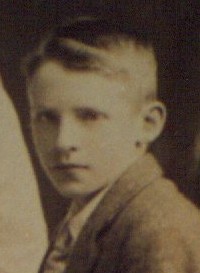 |
|
William Ernest Kilroy
photograph from Chris Gosnell
|
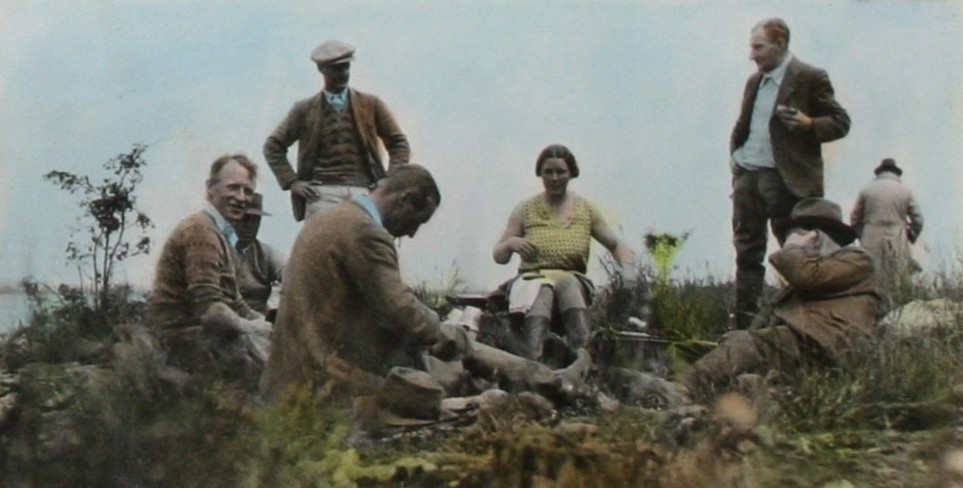 |
|
Kilroy family picnic at Lough Sheelin in
May 1935. William Ernest is seated far left. Others pictured are
Ken Gosnell (standing left), Richard Tony Kilroy (front) and
Louise (Waldron) Kilroy and Cecil Kilroy (standing right)
photograph from Jerry Gosnell
|
known as "Ernest"
12 September 1892, at Moat View,
Oldcastle, county Meath, Ireland
William
Wesley
Kilroy
Annie
Catherine Maxwell (Groome) Kilroy
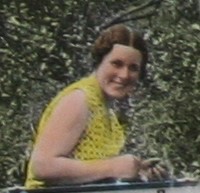 |
|
Louise Emily Madeline Waldron
(May 1935)
photograph from Jerry Gosnell
|
Louise Emily Madeleine Waldron on
13 April 1927 in St James, Athboy, county Meath, Ireland
William Ernest Edward Kilroy is recorded as a bachelor, of full age, the son
of Thomas Richard Kilroy, farmer. William is a gentleman farmer, resident at
Moat View, Oldcastle. Louise Emily Madeleine Waldron is recorded as a
spinster, of full age, the daughter of William Waldron, farmer. Louise is
resident at Ballyfallon, Athboy. The marriage was witnessed by Alan J. M.
Kilroy, M.G. Waldron, W. Waldron and Louise Smith.
[William's father is incorrectly stated on the marriage record - William is
really the son of William Wesley Kilroy as seen in the census records and on
the gravestone.]
Louise was born on 10 January 1904, at 63 Lower Baggot Street, Dublin, the
daughter of William Waldron and Madeleine Smith. She was baptised in 1908,
in St James Church, Athboy, county Meath. Louise died on 3 July 1985, in
Sandycove, county Dublin and was buried in Killeagh Cemetery,
Oldcastle, county Meath.
Census:
1911:
Ballyfallon or Newtown, Athboy, county Meath
Farmer
A horse, "Gay Recruit" (by Gay Crusader), sold at Dublin Horse Show, 1933,
for 280 guineas by W. E. Kilroy.
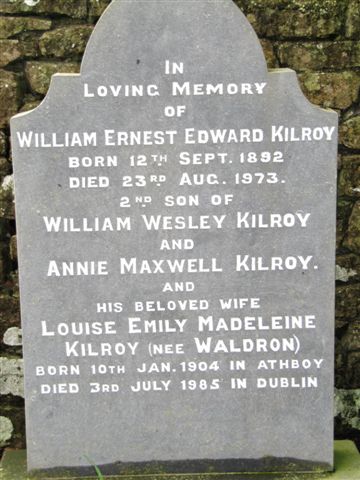 |
|
Gravestone of William Ernest Kilroy and
Louise (Waldron) Kilroy in Killeagh Cemetery, Oldcastle, county
Meath, Ireland
photograph from Jerry Gosnell
|
23 August 1973, at Moat View,
Oldcastle, county Meath, Ireland
Killeagh Cemetery, Oldcastle, county
Meath, Ireland
1901:
Moat, Oldcastle, county Meath
1911:
Moat, Oldcastle, county Meath
- Gravestone; place from
IGI, 1901 census
- 1911 census
- Ireland
civil records 1927 Athboy; Ireland Marriage Index (2Q1927 Trim vol
2 p608); Louise birth from Ireland
civil records 1904 Dublin South and Ireland Birth Index (1Q1904
Dublin South vol 2 p713) - Louise's gravestone incorrectly has the place
of birth as Athboy; Louise baptism from IGI; Louise parents from 1911
census; Louise death from gravestone; exact place from IGI; Louise
burial from gravestone
- Ireland
civil records 1927 Athboy
- Gravestone; place from
IGI
- Gravestone
William George Kilroy
19 April 1914, at High Street,
Tullamore, King's County, Ireland
William George was born on Nineteenth April 1914 at High St., Tullamore, the
son of James A. Kilroy, iron monger, of High St., Tullamore, and Lucy Kilroy
formerly Hutchinson.
James Arthur
Kilroy
Lucy Hannah (Hutchinson) Kilroy
_____ Kilroy
_____ Kilroy
1 March 1884, at Derrysheridan,
Killeagh parish, county Meath, Ireland
Unnamed male was born on First of March 1884 at Derrysheridan, the daughter
of James W. Kilroy, farmer, of Derrysheridan, and Maria Kilroy formerly
Gibson.
James Watkin
Kilroy
Maria (Gibson) Kilroy
Return to Chris Gosnell's Home Page
If you have any comments, additions or modifications to the information on this page, please feel free to email me.
Created and maintained by: chris@ocotilloroad.com









































